Planning to spend 2 days in Seoul, but wondering what to do, see, and eat? Here’s the perfect Seoul itinerary for when you only have limited time, which includes all the city’s top highlights + super helpful tips!
Seoul is one of Asia’s most vibrant cities, with tons of unique attractions, rich history and culture, incredible food, tons of shopping, and more.
Seoul was a city that had been on my bucket list for years, and I was so excited to finally make it here, even for a short time! Even though I only had two days in Seoul, I was determined to make the most of it – and therefore planned a super efficient itinerary that hits all the highlights.
The capital of South Korea boasts grand historical palaces, sky-high skyscrapers, whimsical cafes, traditional markets, and even lush greenery. There’s a lot that Seoul has to offer – you won’t get to experience all of Seoul in 2 days, but it’s definitely enough time to make the best of the city.
A 2 day Seoul itinerary is definitely short, but it’s enough to admire some of the palaces, visit some charming neighborhoods, eat some of the city’s delicious street food, do some shopping, and hang out in some cafes. You won’t get to do it all but that’s ok – it will definitely leave you wanting to come back!
Keep on reading for all the best things to do, see, and eat in Seoul, along with some super helpful tips to help you plan the best trip!
This post contains affiliate links. This means that if you make a purchase or booking, I may receive a small commission at no additional cost to you.Pictures & Words is a participant in the Amazon Services LLC Associates Program, an affiliate advertising program designed to provide a means for us to earn fees by linking to amazon.com and affiliated sites at no cost to you.
Headed to Seoul soon? If you’re planning to spend 2 days in Seoul and short on time, here are some top picks!
Best Things to Do in Seoul:
- Hanbok Rental (w/ optional photoshoot add-on)
- Gyeongbokgung Palace + Bukchon Hanok Village Guided Walking Tour
- N Seoul Tower Observatory
- Gwangjang Market Food Tour
Where to Stay in Seoul
- Myeongdong (ibis Styles Ambassador Myeongdong, Lotte City Hotel Myeongdong)
- Insadong (MOXY Seoul Insadong, Nine Tree Insadong)
- Bukchon Hanok Village (Luxury Hanok Onyu, Hanok Hotel DAAM)
Book Airport Transportation: AREX Airport Express Train
Buy KTX Train Tickets: KORAIL Train Pass
Is 2 days in Seoul enough?
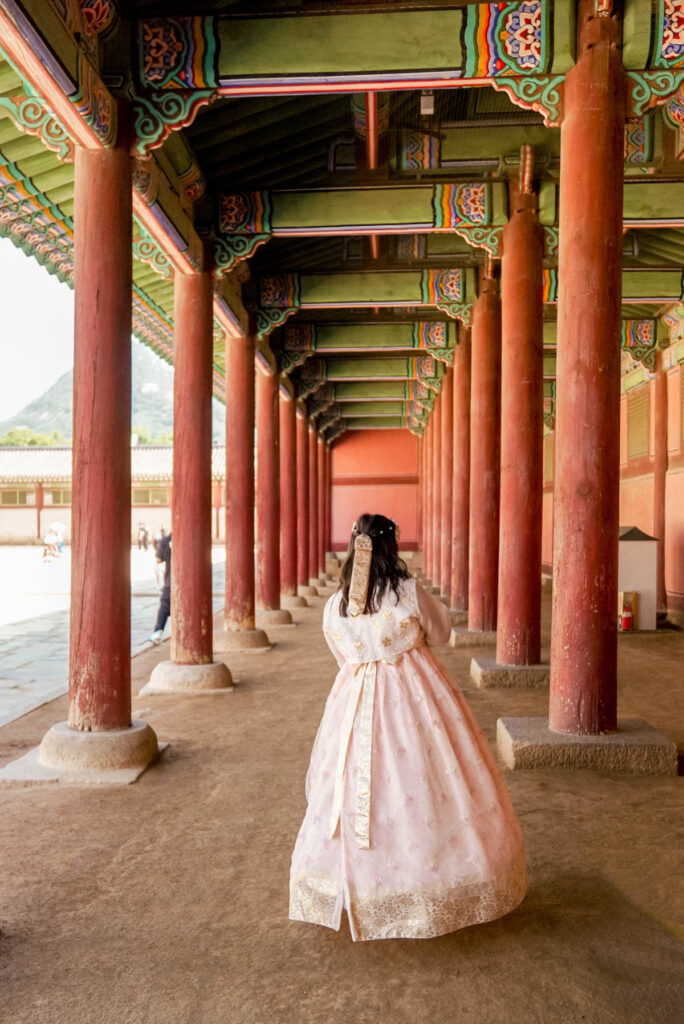
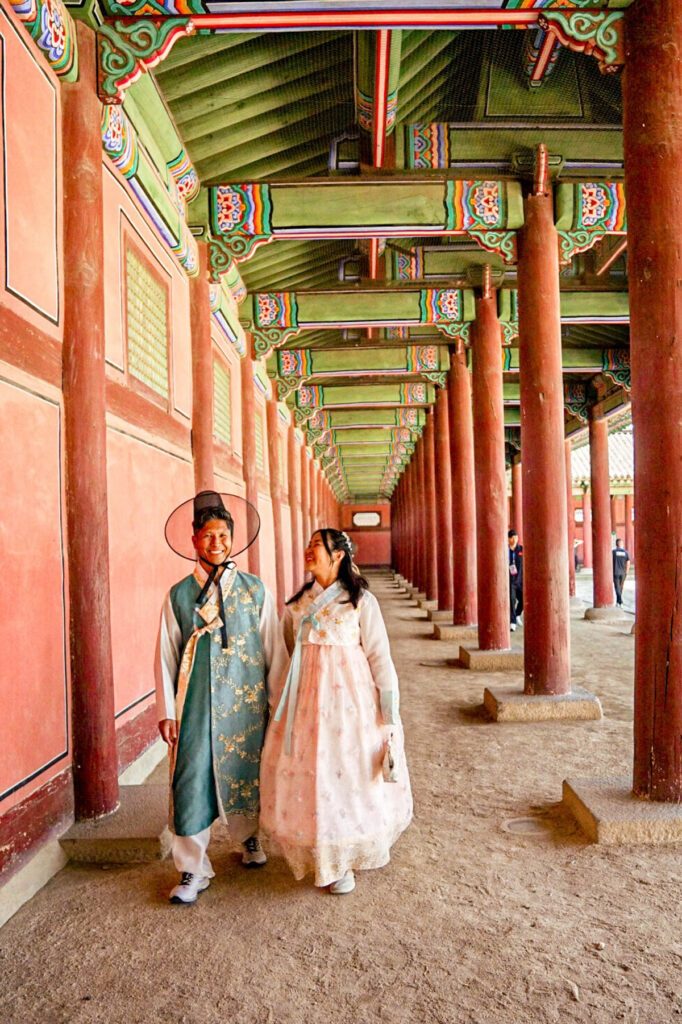
Short answer: not really – but you can make it work.
Seoul is huge, and there’s tonssss of things to do – enough to keep you occupied for more than a week! Many itineraries I saw recommended spending 4-5 days in Seoul to fully explore the city.
However, we stopped over in Seoul on the way to the Philippines, and so 2 days was all we had – so I was determined to make the most of it!
If you only have limited time in the city, the key is to prioritize! You won’t be able to do it all, but if you pick out the things that you want to do the most, and plan efficiently, you’ll still cover a lot of ground.
Two days is enough time to see some of the city’s main highlights, check out a popular cafe or two, sample some foods at the city’s markets, and do a bit of shopping. I definitely made the most of my two days in Seoul, but it definitely made me want to come back for more!
A few things to know before visiting Seoul…
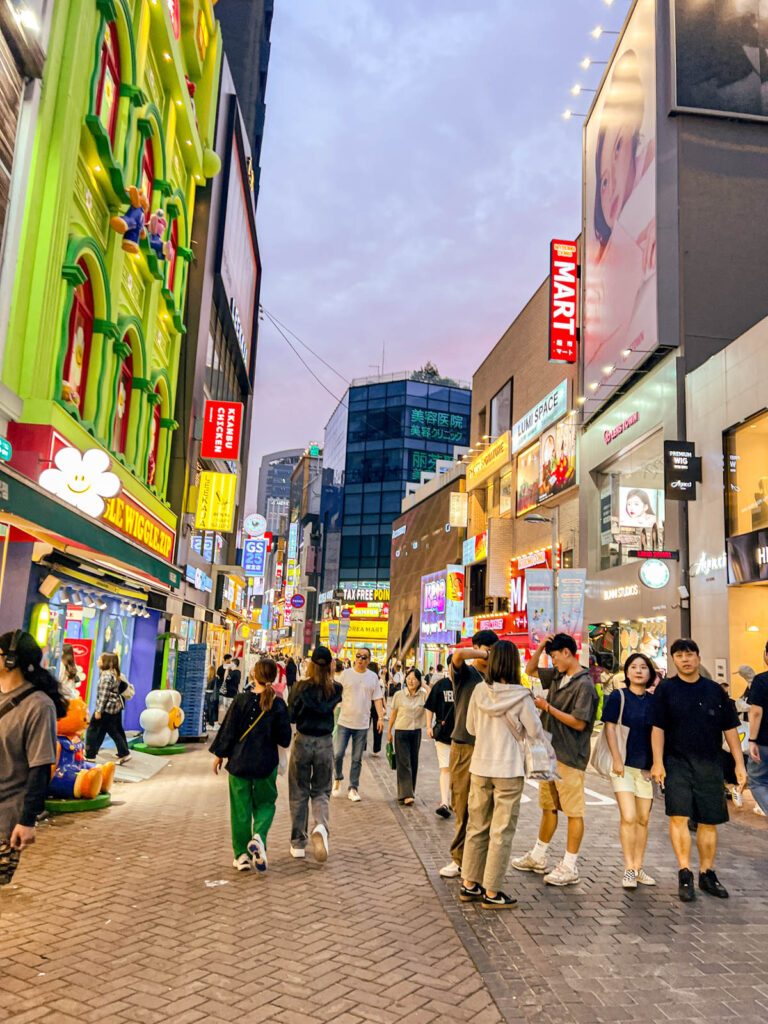
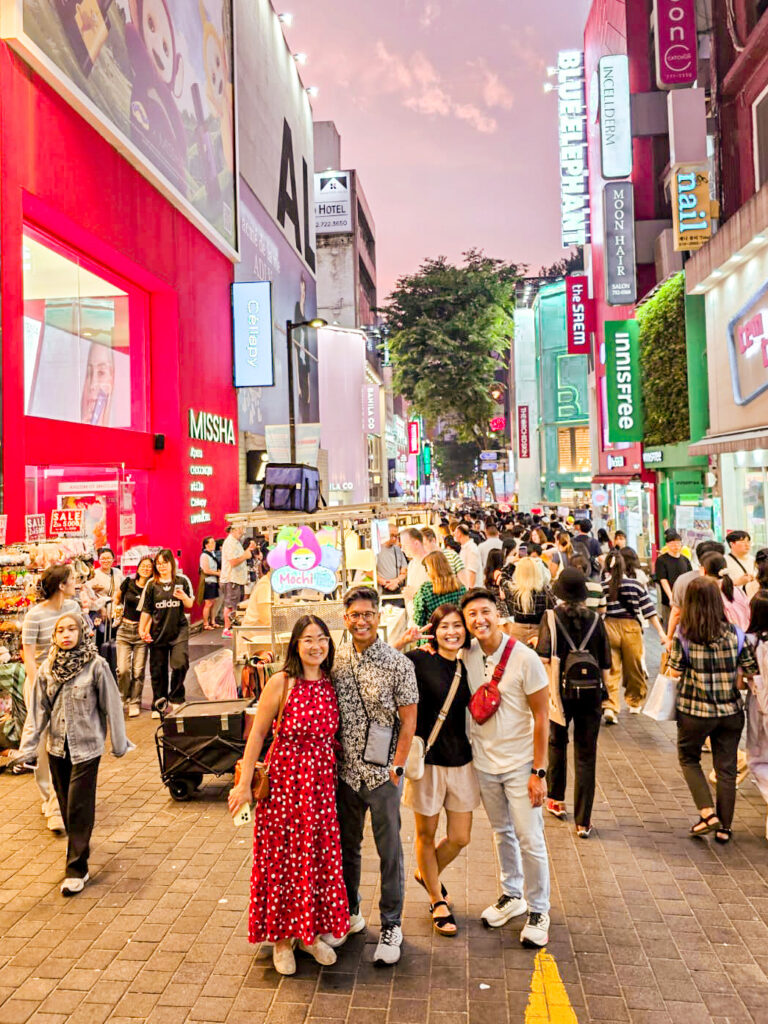
- The city is huge: Seoul is quite large, and it can take anywhere from 20 minutes to an hour to get between places. If you’re trying to see Seoul in 2 days, you’ll definitely need to prioritize and plan efficiently!
- Have some cash on hand: While most places in Seoul accept credit cards, you’ll want to have some cash on hand for street food (which is 100000% a must when visiting), and for transit. You won’t need a whole lot though, so don’t take out too much – around $75-100 USD’s worth per person is more than enough for 2 days.
- Things stay open late at night (and open late in the mornings): Seoul is definitely a stay out late and sleep in kinda city. Jet lag had me awake at 5:30 every morning, but I found that many things didn’t open until 10 or even 11 am – even cafes! On the flip side, all the shops, restaurants, and markets stayed open until at least 10 or 11 at night (and many places much later). Definitely plan your 2 day Seoul itinerary accordingly!
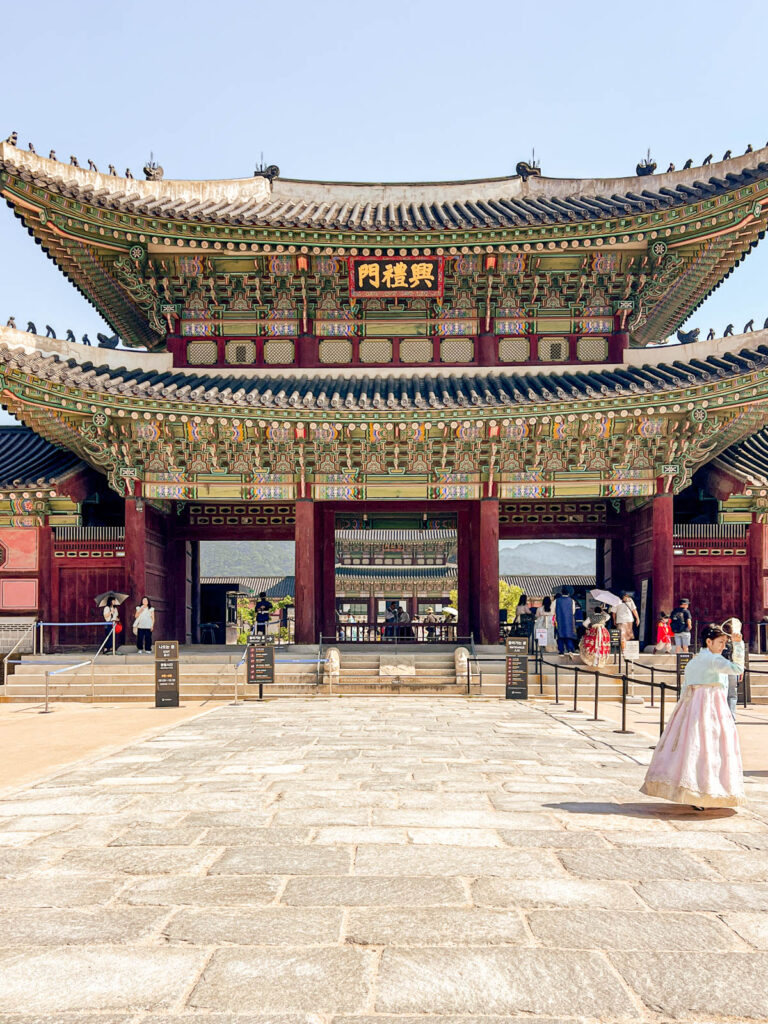
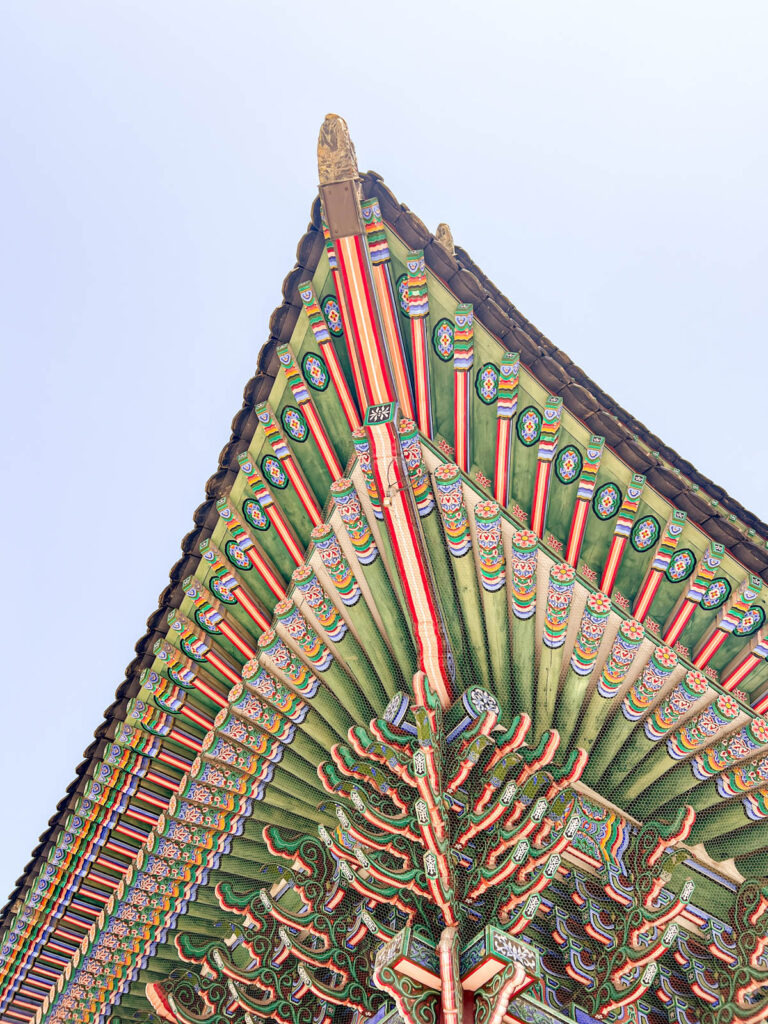
- Download Naver Maps: While Google Maps *does* technically work, its features are limited to transit directions only. While you can technically follow the dot to see which direction you’re walking, I found Naver Maps to be more comprehensive and preferred using it. Sometimes I just wanted to know how long it takes to walk from point A to point B, which is something I couldn’t do on Google Maps. However, if you really don’t feel like downloading another app, you don’t absolutely have to.
- It’s pretty hilly and there’s lots of stairs: One thing I didn’t realize about Seoul is that it’s super hilly and there are stairs EVERYWHERE! I definitely was huffing and puffing a bit while walking around the city (and we did a LOT of walking!). Definitely wear your comfiest shoes (Allbirds makes my favorite travel shoes, and I wore my Crocs sandals)!
- Expect lines at all the popular spots: All the popular cafes and restaurants have lines. Unless you go at opening, you’ll have to prioritize and choose the ones you want to go to the most, especially with limited time. There were many more spots I wanted to check out, but I knew I wouldn’t be able to with only 2 days – I guess that just means I have to make a return visit!
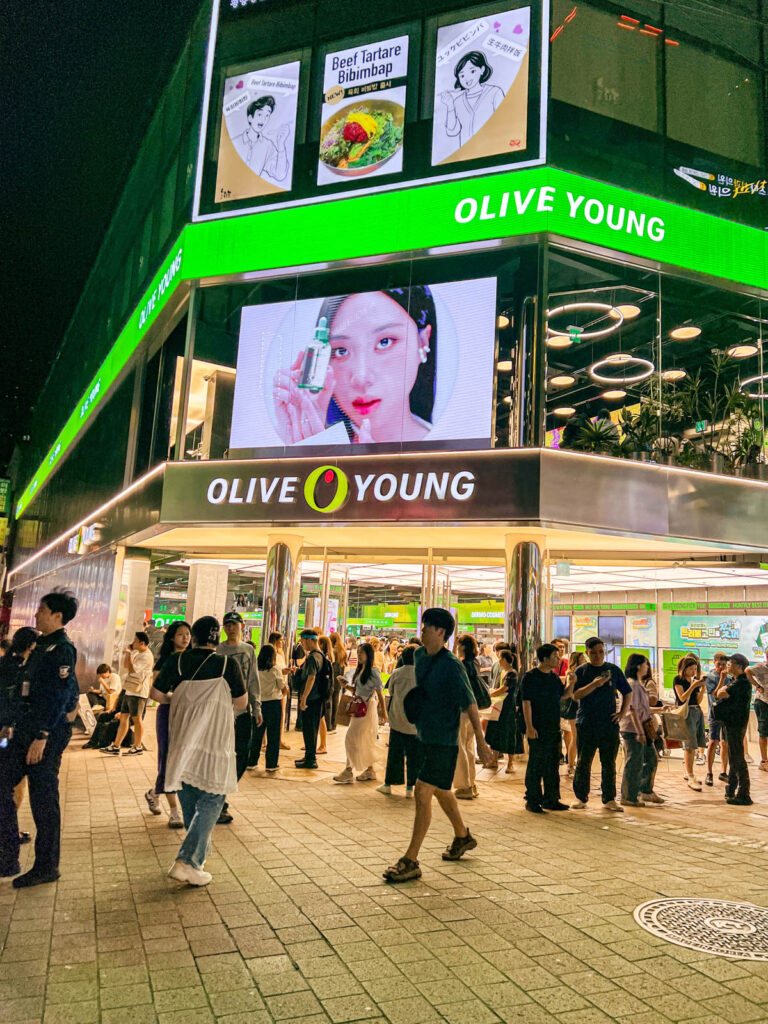
- Olive Young is *everywhere*: If you know anything about Korean skincare, then you’ve likely heard of Olive Young, the K-Beauty emporium. One common misconception about Olive Young is that there’s only the one main store in Myeongdong – but there’s actually locations alllll around the city (and there are several just in Myeongdong alone)! Don’t feel like you need to do all your shopping at just one location. The main one is also super crowded (and we got super overwhelmed), so I recommend stopping at a less crowded location, if you can.
- Carry your passport when you go shopping: Many stores will give you an automatic tax refund upon presenting your passport, instead of having to do it at the airport.
- You need a local phone number for restaurant reservations: If you need to make restaurant reservations, get a SIM with a local number, or ask your hotel concierge. Otherwise, there are plenty of delicious places to eat where you don’t need a reservation (we didn’t make a single one and ate *very* well!).
- Pay attention to closing dates/times: Note that the palaces are closed on Mondays, *except* for Gyeongbokgung Palace which is closed on Tuesdays. Also be aware that the Bukchon Hanok Village is closed to tourists from 5pm to 10am, as well as on Sundays.
- Electricity: Most plugs in Korea use type F 220V plugs, with some type C plugs being used as well. If you are coming from the United States, be sure to pack a power adaptor so you can plug in your devices.
Where to Stay in Seoul
Choosing where to stay in Seoul can be difficult, as the city is so big and there are so many neighborhoods to choose from, each offering something different. Especially with only 2 days in Seoul, it is important to be strategic about where to stay to maximize your time!
Here are my picks for where to stay for this 2 day Seoul itinerary:
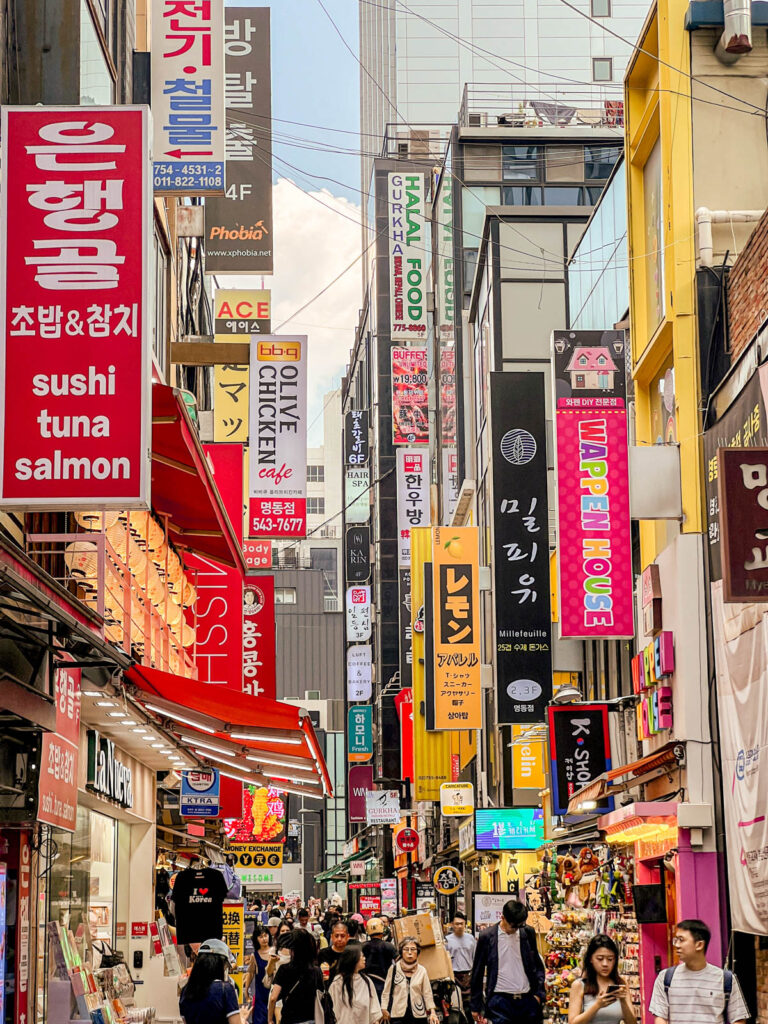
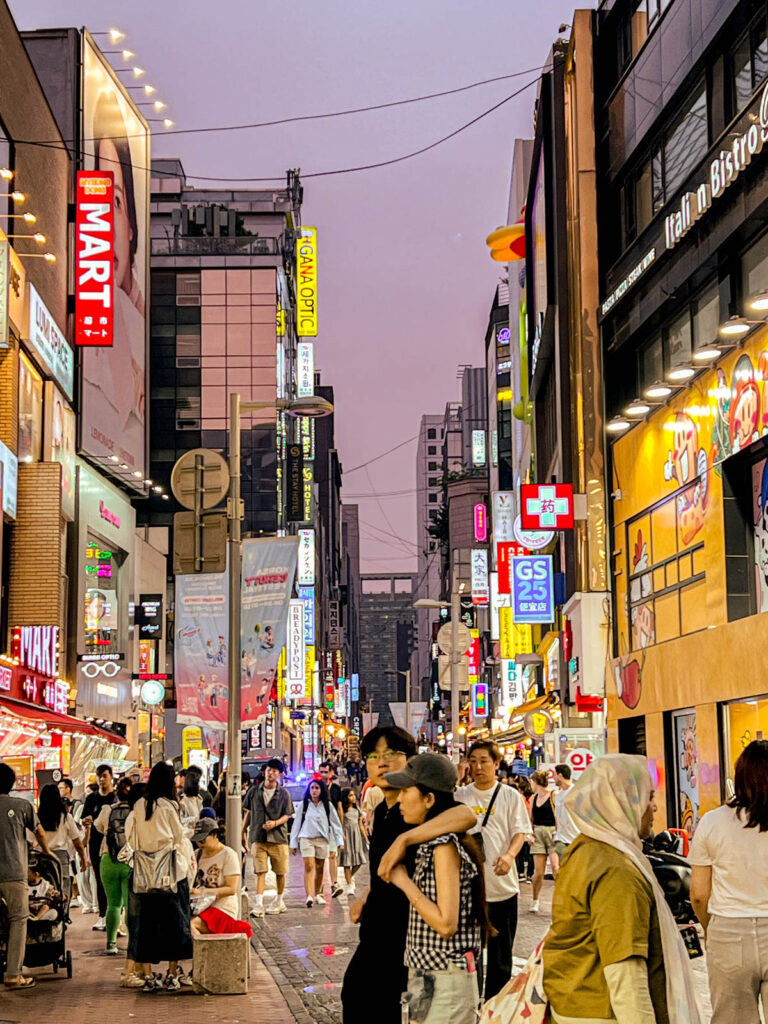
Myeongdong
This is where we stayed, and I highly recommend it! Myeongdong is one of the most popular neighborhoods to stay in for first-time visitors, and for good reason – it’s central, there’s plenty of options, and tons of restaurants and shopping.
One downside is that it’s very lively, and it can get a bit busy. However, I still recommend it as it was super convenient!
- ibis Styles Ambassador Seoul Myeongdong: This is where we stayed. You can’t beat the location, just a few minutes’ walk from all the night market, shopping, and subway stations. The rooms are a bit small and basic, but have everything you need, and the staff was super helpful. There’s also a nice rooftop bar!
- Lotte City Hotel Myeongdong: This upscale hotel is located in the heart of Myeongdong, offering easy access to shopping, the night market, and subway, and offers modern amenities.
- Hotel28 Myeongdong: Korea’s first hotel to be listed on Small Luxury Hotels, this stylish property takes design inspiration from the film industry.
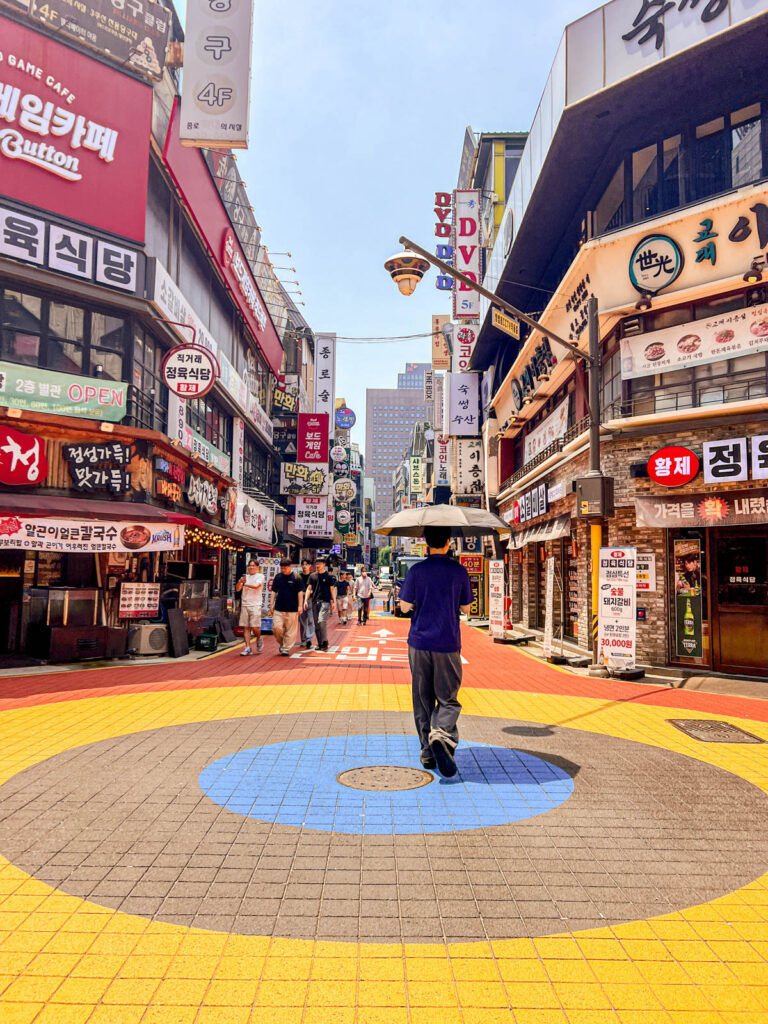
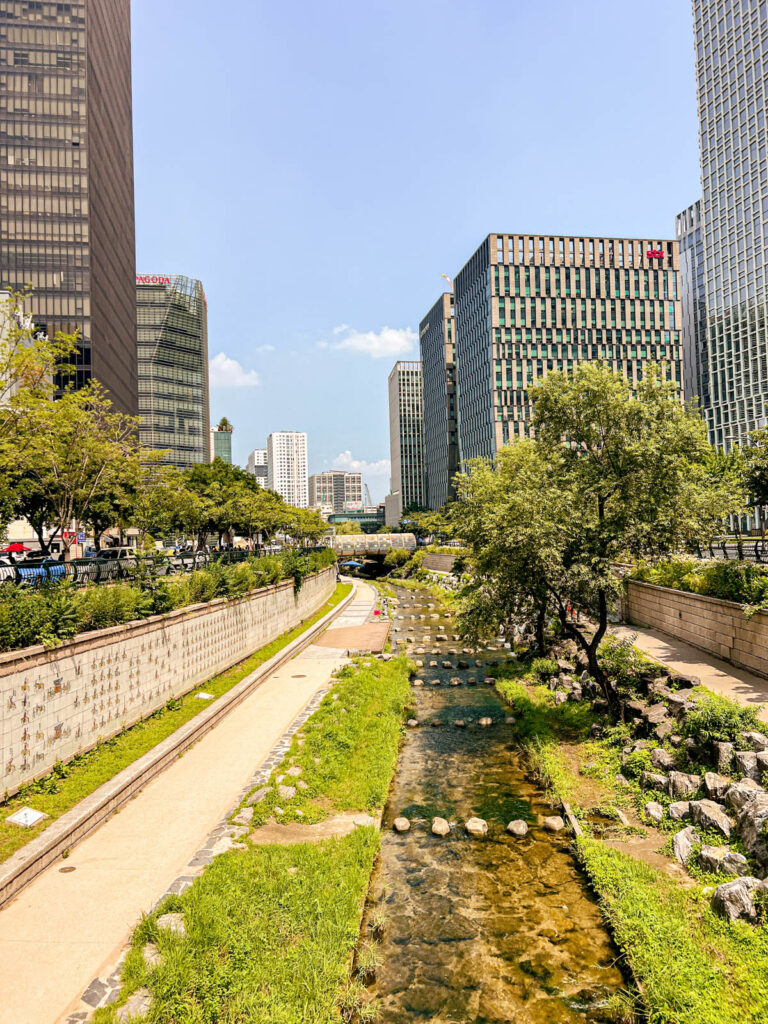
Insadong/Jogno
This area is a bit north of Myeongdong, boasts historical charm, and is close to the palaces and many popular cafes. This is a good place to stay if you want to be close to the top attractions, but want to escape the hustle and bustle of Myeongdong.
- MOXY Seoul Insadong: This trendy adults-only hotel has a convenient location, along with streamlined but modern rooms, a rooftop bar, and more.
- Nine Tree Insadong: This laid-back hotel boasts a convenient location, modern amenities, and a trendy rooftop bar.
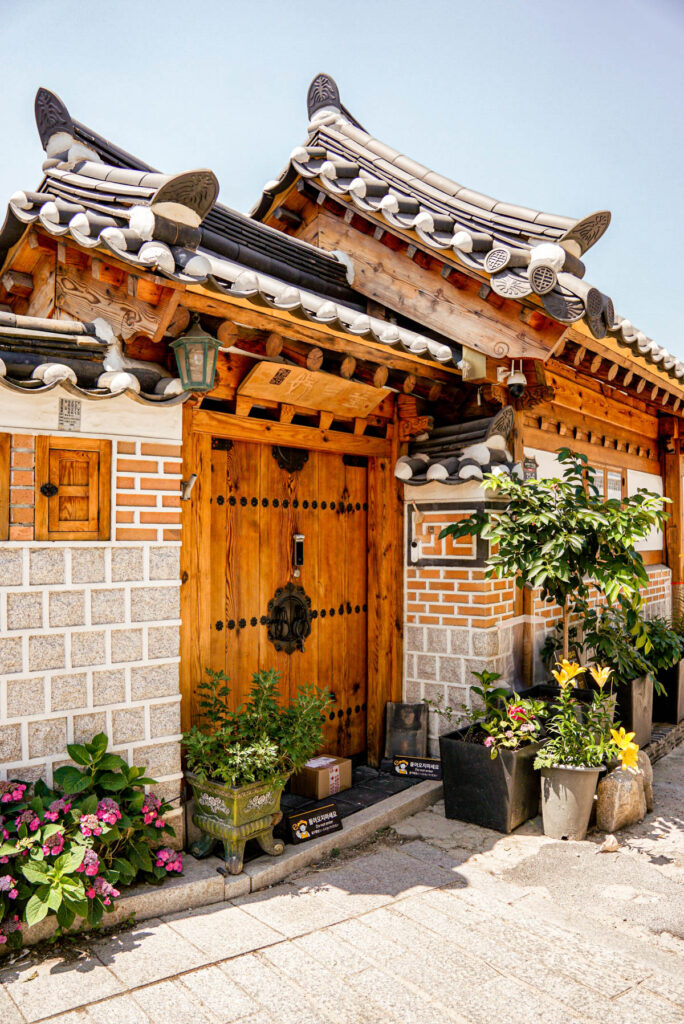
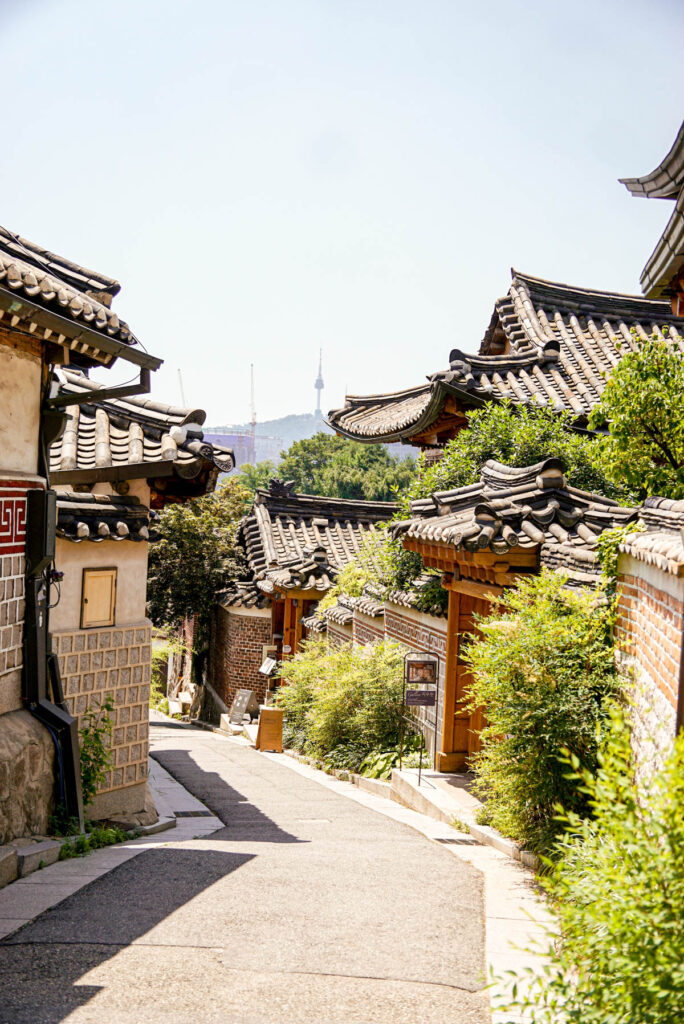
Bukchon Hanok Village
If you’re looking for the unique experience of staying in a traditional Korean hanok, then consider staying here. One major advantage of staying in the Bukchon Hanok Village is that you get access to it before it opens to the public, which means that you’ll get to experience it without all the crowds!
However, do note that the streets here are quite windy and hilly, so keep that in mind if you’re going to have a lot of luggage.
- Luxury Hanok Onyu: This elegant hanok has a convenient location close to the palaces, along with comfortable amenities and an elegant design.
- Luxury Hanok Cottage Nest: This gorgeous hanok property has villa style rooms, and offers spring baths, open-air baths, or spa baths for a relaxing experience. It’s also got a convenient location that’s close to both Gyeongbokgung and Changdeokgung Palace.
- Hanok Hotel DAAM: This is a larger hanok property, which offers both shared and private rooms. Free continental breakfast is included with your stay.
Other Places to Stay in Seoul
The below are a few other popular neighborhoods to stay in Seoul. However, I wouldn’t recommend them for this itinerary, as they wouldn’t be the most convenient locations.
- Gangnam: This ritzy area is often called the “Beverly Hills of Seoul.” It’s known for its high-end shopping and cosmetic beauty clinics. It’s a bit far from all the main tourist attractions, however, it’s a good option if you plan to get some beauty treatments done, or want to stay in the city’s most luxurious hotels. (book hotels in Gangnam here)
- Hongdae: This trendy neighborhood is another popular area in Seoul, known for its nightlife, youthful vibe, and shopping. I didn’t include it above because this itinerary doesn’t spend any time in Hongdae (because priorities!) – however, if you want to experience the nightlife, it may be a good area to stay in. (book hotels in Hongdae here)
The Perfect Two Days in Seoul Itinerary
DAY 1 (Historic Seoul + Myeongdong)
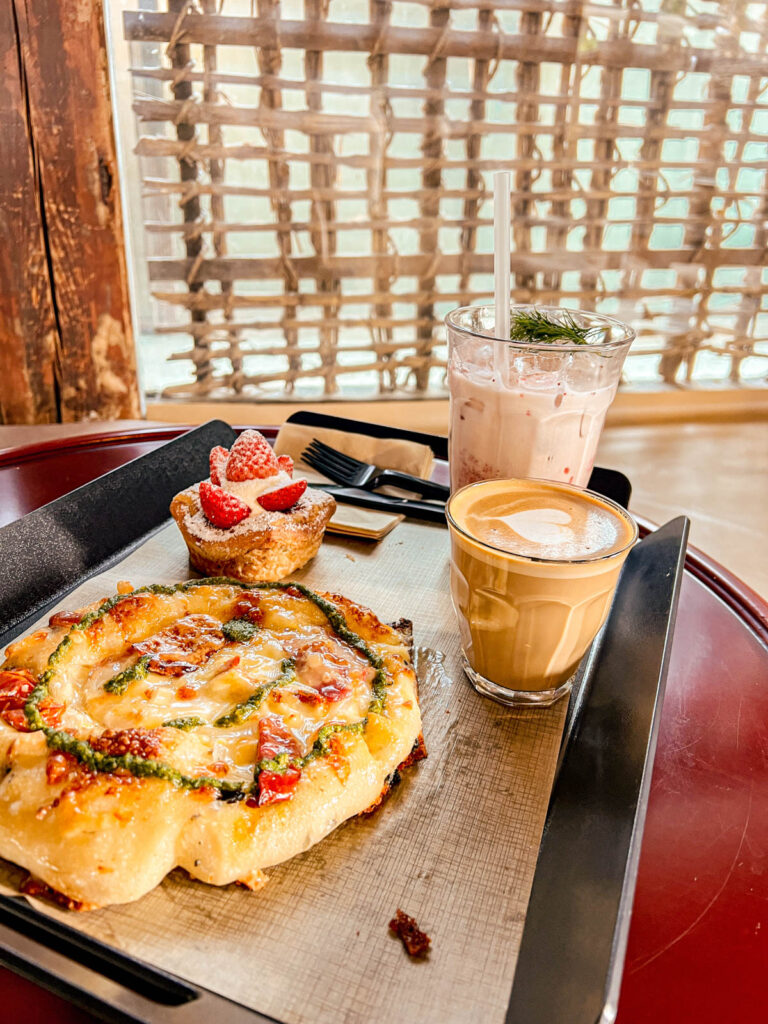
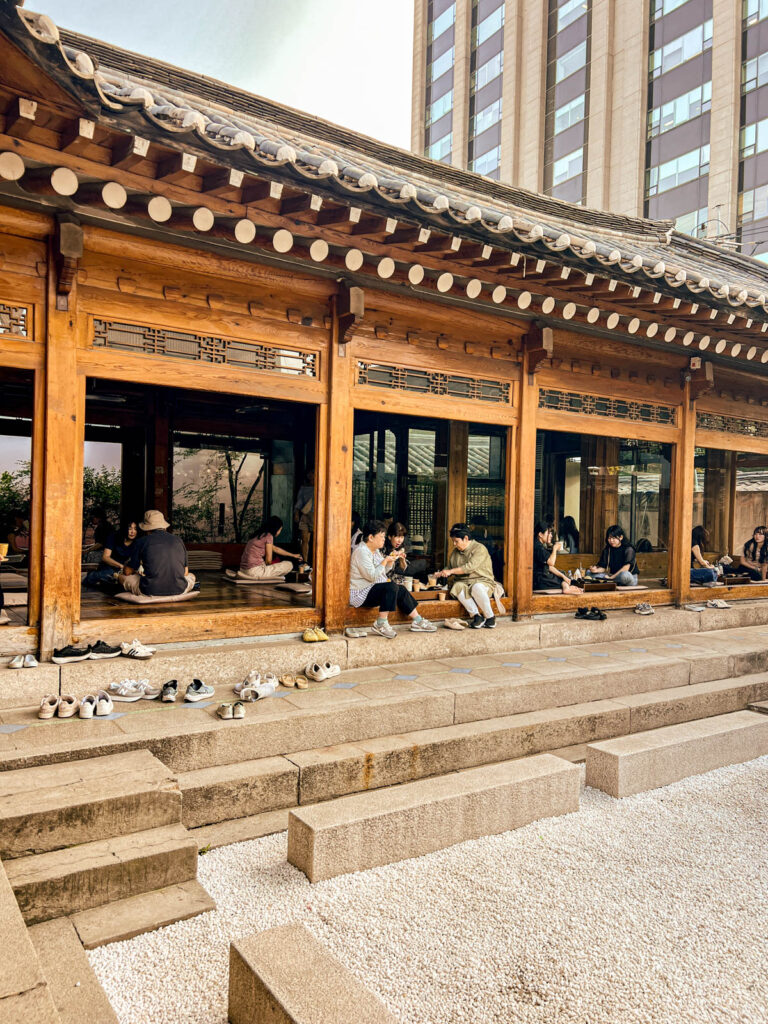
Early coffee + pastries at Cafe Onion
Rise and shine! It’s time to wake up early for your first day in Seoul, as we’ve got a busy day planned!
Start your day at Cafe Onion, which is one of the most popular cafes in the city. It’s gone viral on social media thanks to its traditional hanok setting and delicious pastries.
They have multiple cafes around the city, but I recommend heading to the Anguk location, which is relatively close to the palaces, and most convenient to the rest of the stops on this Seoul itinerary. It’s also the location that is housed in the hanok.
Cafe Onion is one of the few cafes to open early in the morning, opening at 7am on weekdays (9am on the weekends). I recommend getting here early enough to avoid the lines, but not so early that not all the pastries are out yet.
We arrived around 7:30 and found that to be the perfect time – all the pastries were available, and there was no wait. By the time we left around 8:20, there was already a line forming.
They are known for their (highly photo-worthy) chimney pastry, but my favorite was the strawberry tart. I also really enjoyed my drink, which was a milk tea with strawberry milk – yum!
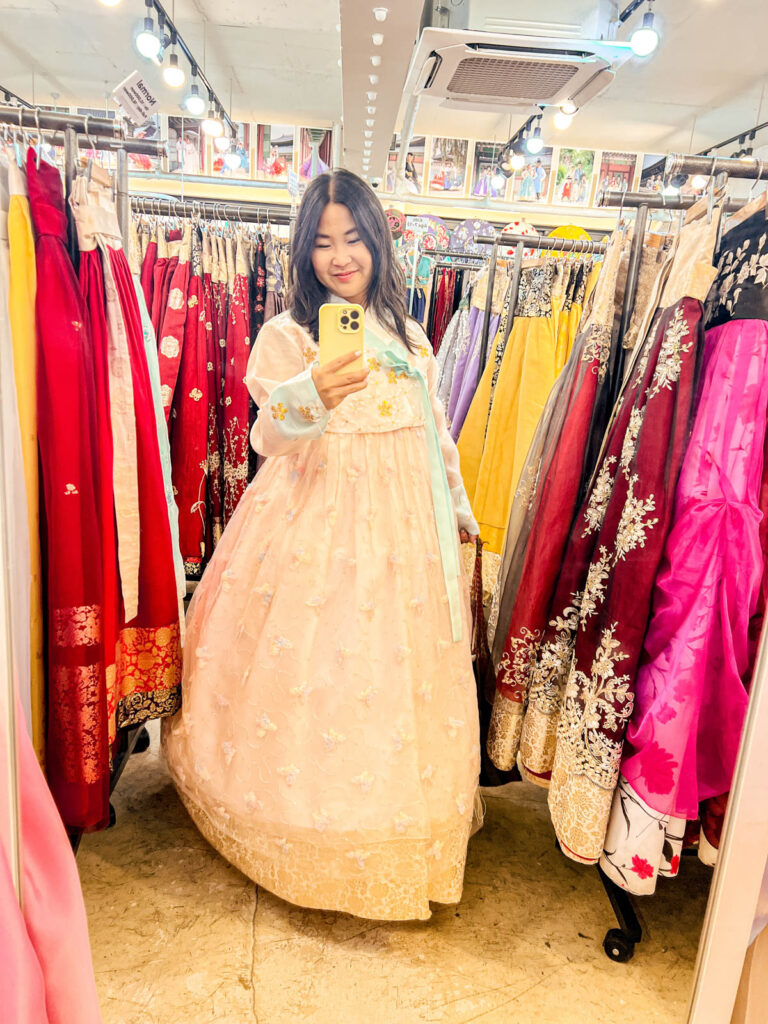
Rent a hanbok
After breakfast, hop on the subway for one stop and get off at Gyeongbokgung Station. Once you exit the station, you’ll find tons of storefronts offering hanbok rentals.
A hanbok literally translates to “Korean clothing,” but usually refers to the traditional clothing worn during the Joseon period. The outfits consist of two pieces, with women wearing a jacket (jeogori) and skirt (chima), and men wearing a jacket and pants (baji).
It’s a popular thing to do in Seoul, and is an activity that is encouraged by the Korean tourism board to promote their history and culture. As such, you’ll receive free entry into the city’s palace if you are dressed in hanbok.
Dressing in a traditional hanbok was definitely the highlight during my two days in Seoul, and I felt like a princess starring in her own K-drama! Both my boyfriend and I, along with his family (including his mom!) dressed up, and we all loved the experience.
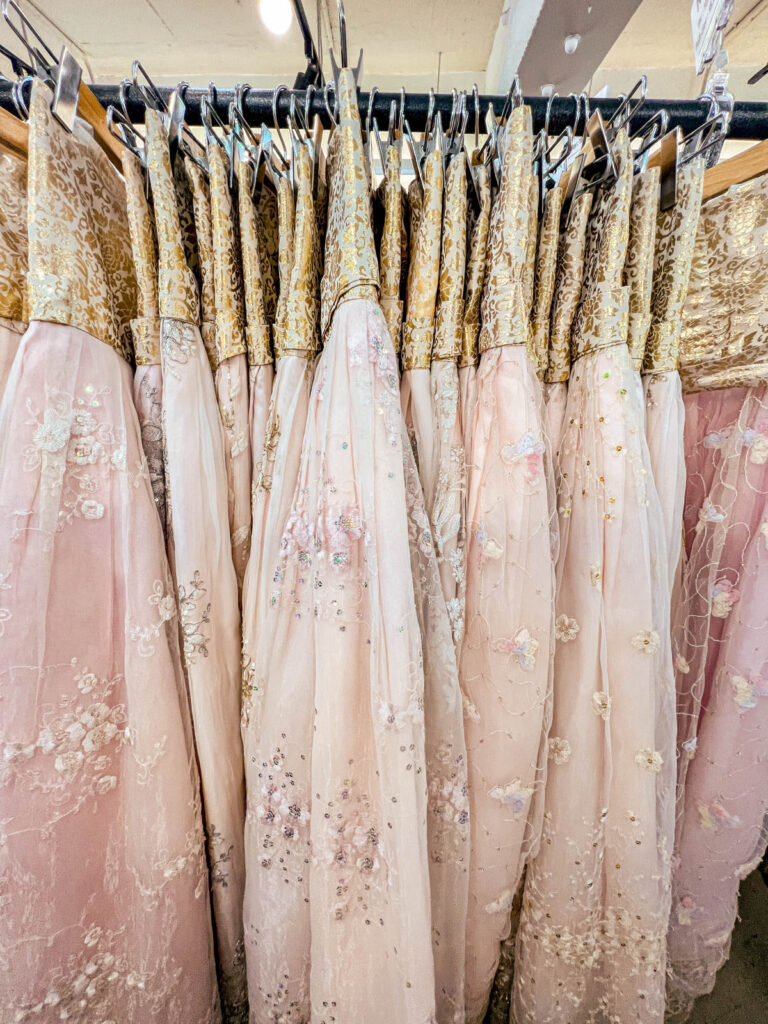
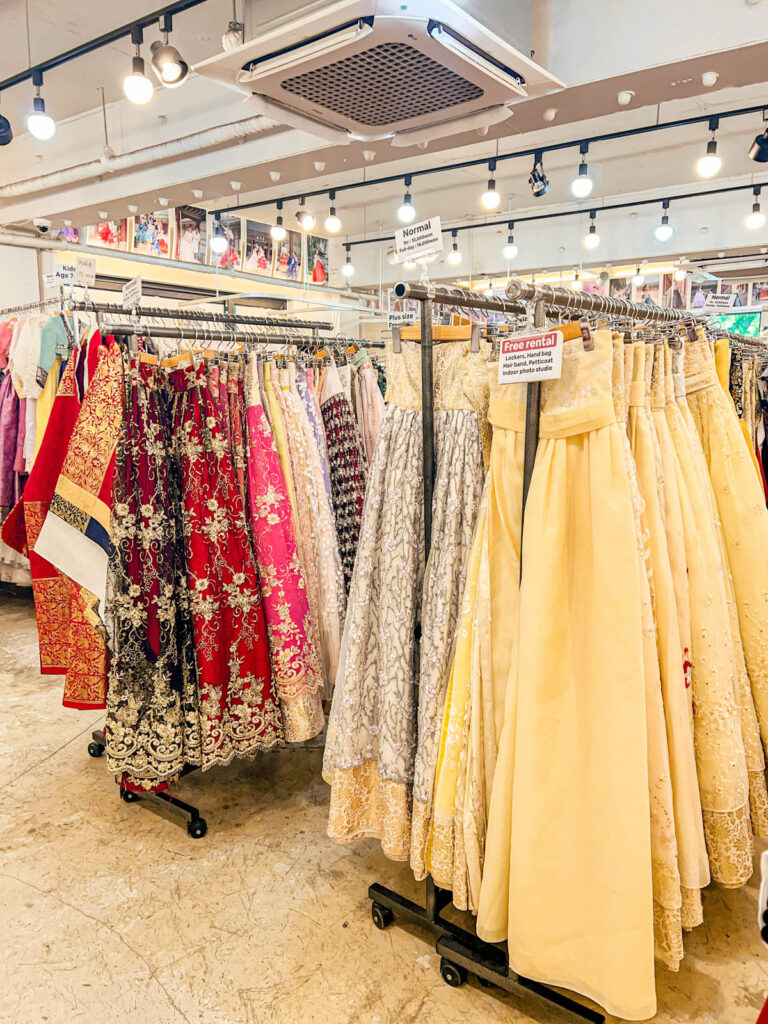
There are plenty of rental shops to choose from located around the palaces and the Bukchon Hanok Village. We headed to Daehan Hanbok, which I primarily chose because they opened a little bit earlier (8:30) than all the other shops (9am). However, when we were walking there, we noticed that there were already other shops open as well.
I recommend booking in advance online, as this will allow you to skip the wait if it’s busy. You’ll find an extensive selection of hanbok for both men and women, available in a wide variety of colors, textures, and patterns.
I paid 18,000 KRW (~$13 USD) for an all-day rental (which was offered at the 2 hour price) of a regular hanbok. You can also rent a premium hanbok for an additional price, but I felt like the regular hanboks were already beautiful! You can also rent by the hour, but I highly recommend renting for the day so you’re not in a rush to take it back.
The rental also included a purse and some accessories. Hair styling is also available starting at 5000 KRW. I originally wasn’t going to get my hair done, but decided to do it after looking in the mirror and seeing that my hair was a mess and didn’t look good with the hanbok LOL. It was definitely worth it, as it only took 5 minutes, and really pulled the look together!
If you want to learn more from a local guide, consider taking this guided walking tour of Gyeongbokgung Palace and Bukchon Hanok Village, the next two stops on this 2 day Seoul itinerary. The tour also makes a stop at a hanbok rental shop as well, if you want to dress up (but is optional if you don’t)!
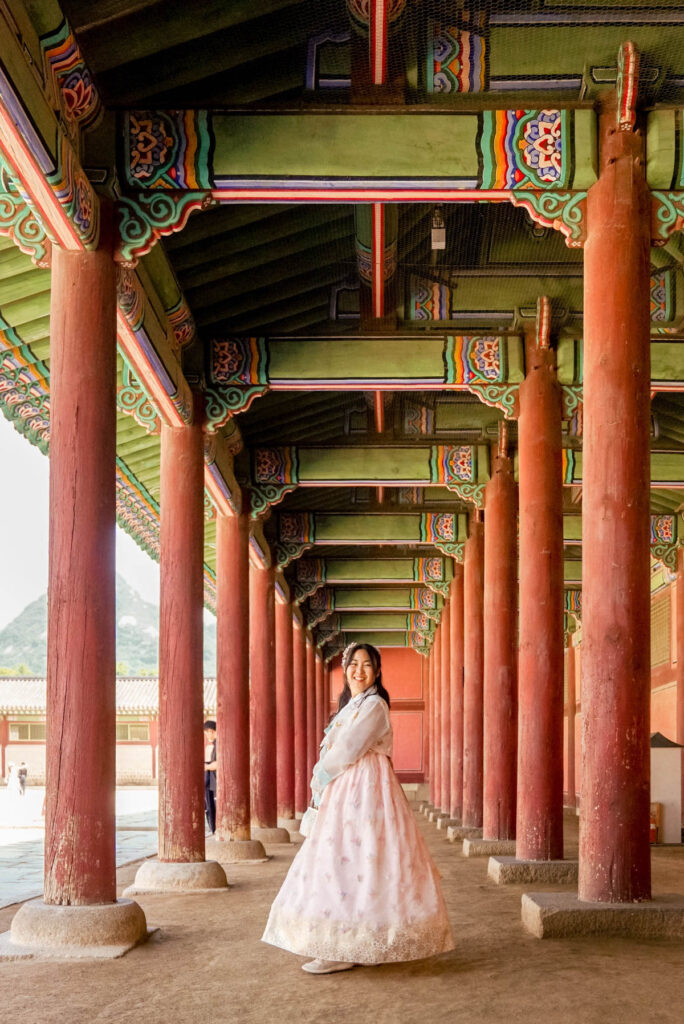
Gyeongbokgung Palace
After dressing up in your hanbok, walk on over to Gyeongbokgung Palace.
There are actually 5 royal palaces in Seoul. However, as you would be limited on time trying to see Seoul in 2 days, I recommend visiting Gyeongbokgung, which is the largest and most beautiful.
Gyeongbokgung Palace dates back to 1395, when it was the main royal palace during the Joseon Dynasty. The palace boasts a rich history, and has been destroyed and rebuilt twice.
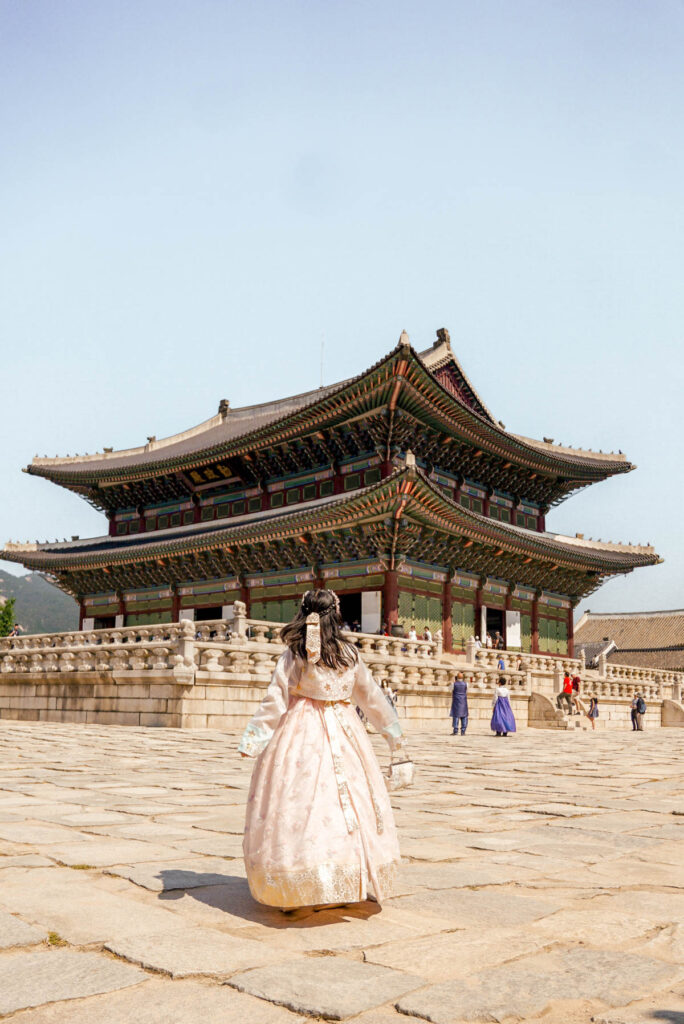
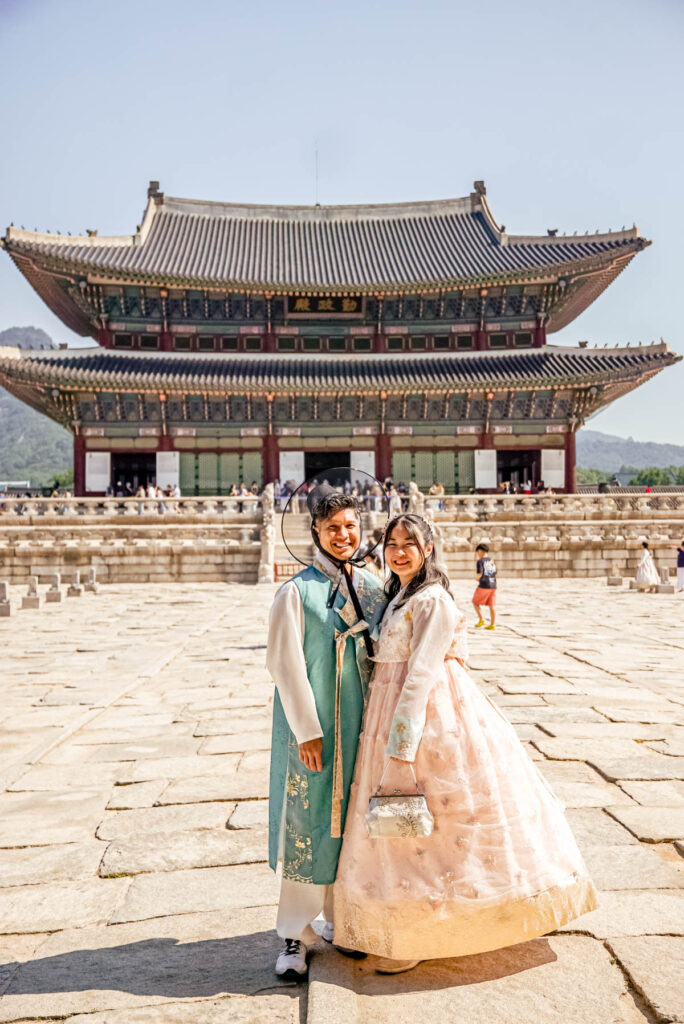
The grounds are sprawling, and features stunning architecture, gorgeous pavilions, grand courtyards, and beautiful gardens. It’s also home to the National Folk Museum of Korea, which is free to visit and a wonderful place to learn more about Korean history and culture.
I recommend getting to the palace as soon as they open at 9am, as it does tend to get very busy. We unfortunately didn’t get to explore as much of the grounds as we would’ve liked, as both the crowds and heat were starting to get a bit overwhelming after a while.
Another highlight here is the changing of guards ceremony, which takes place at 10am (and then again at 2pm) at the Gwanghwamun Gate (the main gate to the south). Sadly, we missed this as well, as we got a bit distracted and forgot about it, whoops!
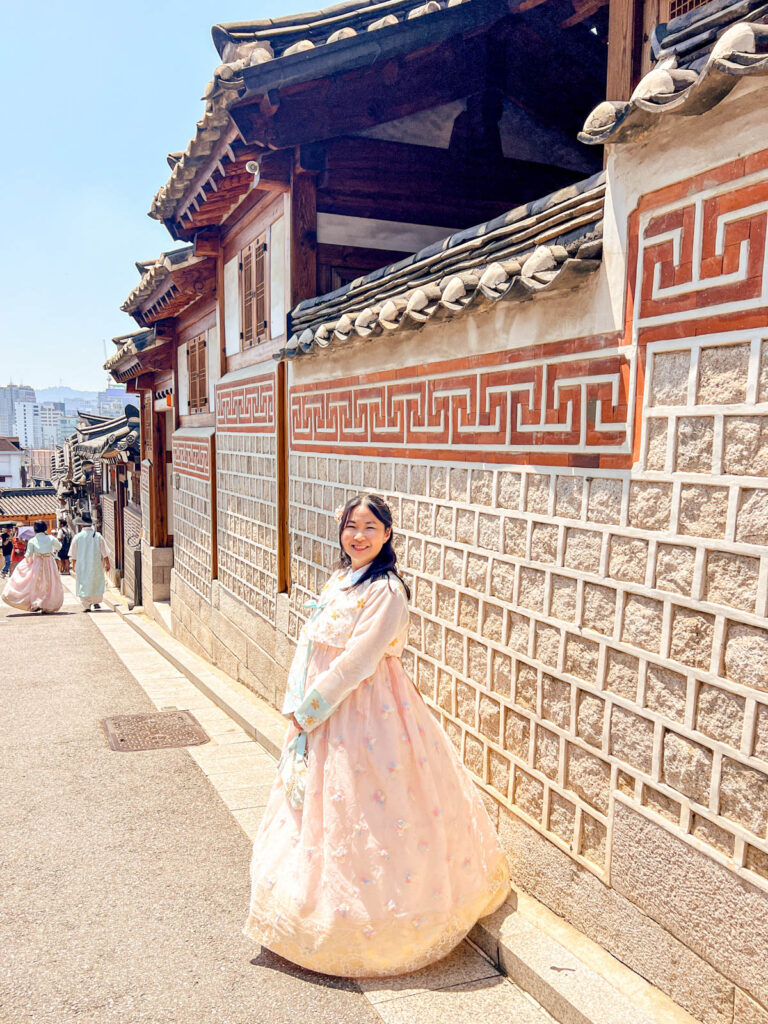
Bukchon Hanok Village
After exploring the palace grounds, exit from the east gate and head towards the Bukchon Hanok Village. This is the most popular hanok village in the city, thanks to its position on a hill, which means that you get a view of Seoul’s skyscrapers set against the traditional hanok buildings. It’s such an awesome juxtaposition of the traditional and modern, which reflects that of the city itself.
The village is home to over 900 hanok buildings. Some of them house cafes, restaurants, and shops, but many of them serve as residences.
It is very important to remember that while this is one of the top tourist attractions in the city, people live here. It is very important to remember to be very quiet and respectful when visiting this area!
Over the last few years, the village has become a victim of its own popularity, drawing huge crowds. After complaints from residents, the village implemented visiting hours. As such, it is now only accessible by tourists between 10am and 5pm, Monday through Saturday.
You’ll also see guards there reminding people to keep their voices down (essentially the noise police). Anything more than a whisper and they are quick to shush you.
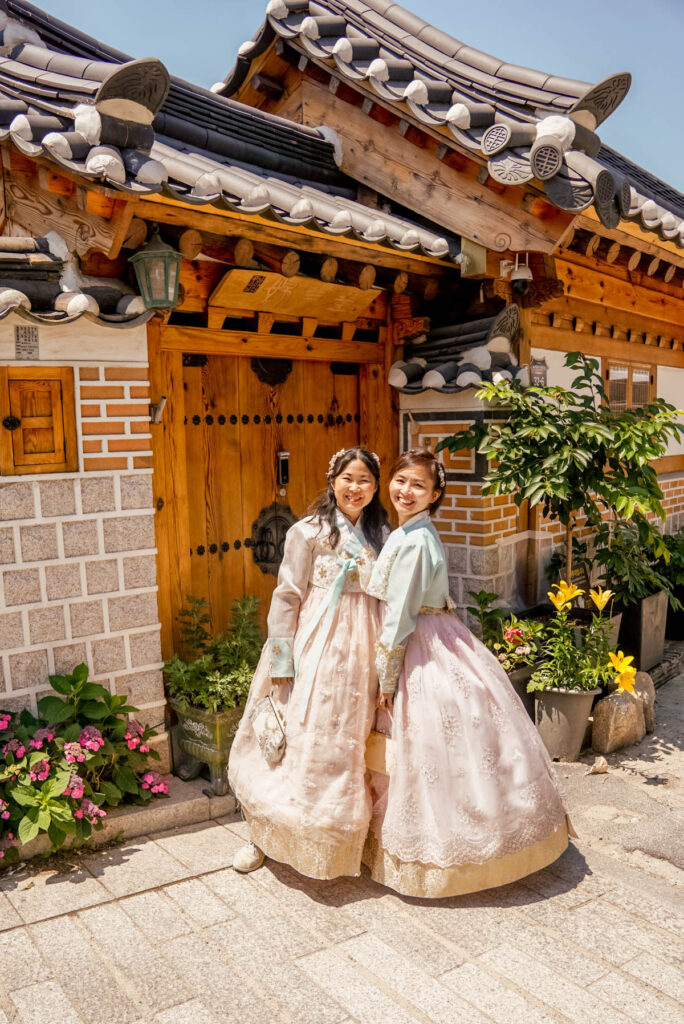
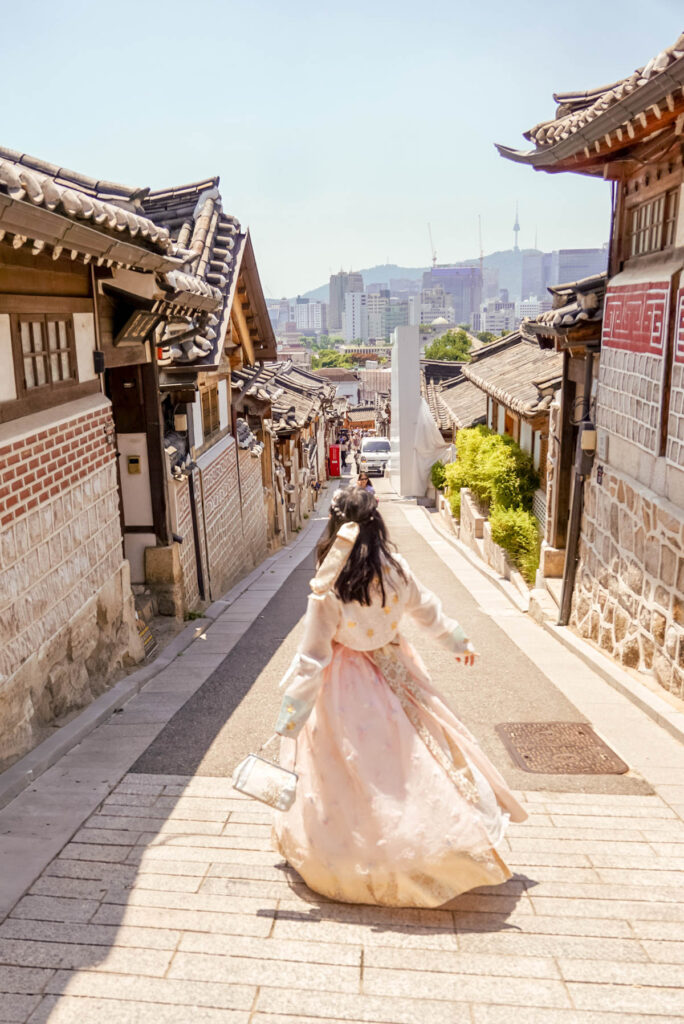
It’s really difficult to escape the crowds, as there is no way to visit super early in the morning. I found the main street and viewpoint (Bukchon Yukgyeong (Photo Spot) 북촌육경) are very busy. However, there are plenty of quiet corners if you wander into some of the side streets.
Some people say that the Bukchon Hanok Village is not worth visiting for this reason, and that there are other, much less crowded, hanok villages that you can visit instead. However, I do think that Bukchon is worth a visit as the hanok buildings here date back to the Joseon Dynasty, when they were occupied by the nobility. Other hanok villages have newer buildings.
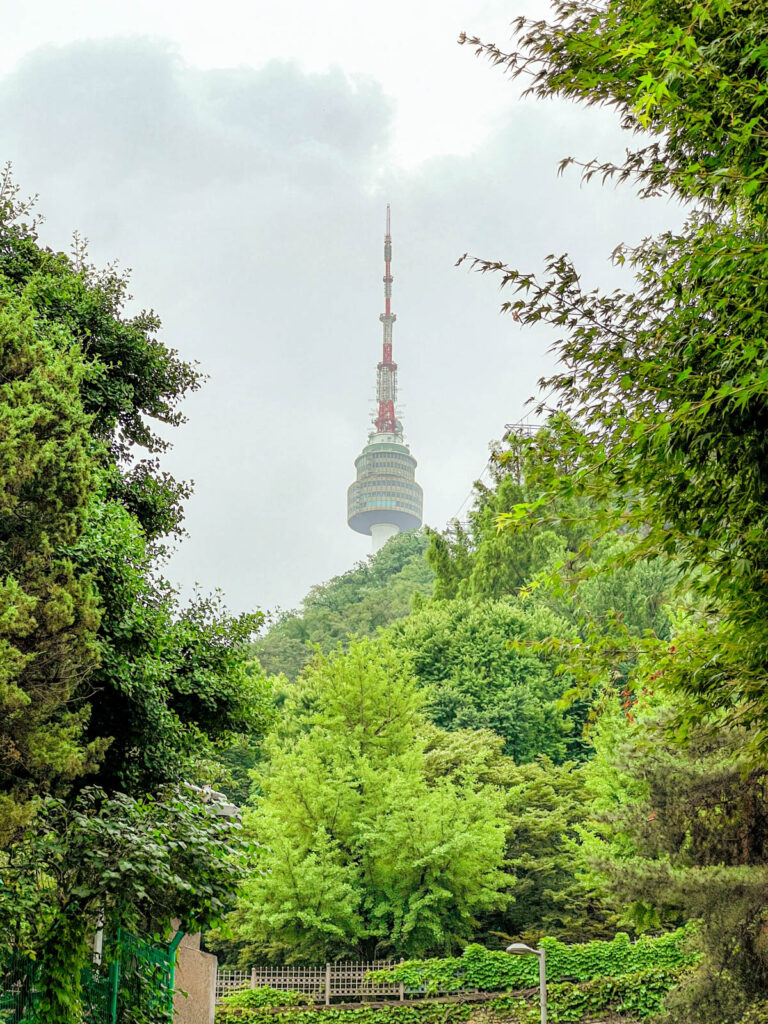
Namsan/N Seoul Tower
You cannot visit Seoul and miss the N Seoul Tower, one of the most iconic landmarks in the city. It’s a place that’s been featured in several popular K-dramas, and it’s one of the most frequently visited attractions in the city.
While you can certainly walk up the mountain (a 30-45 minute uphill climb), the best way to reach the tower is via the Namsan Cable Car. It costs 15,000 KRW (~$11 USD) round-trip, and you’ll already enjoy some gorgeous views of the city on the way up.
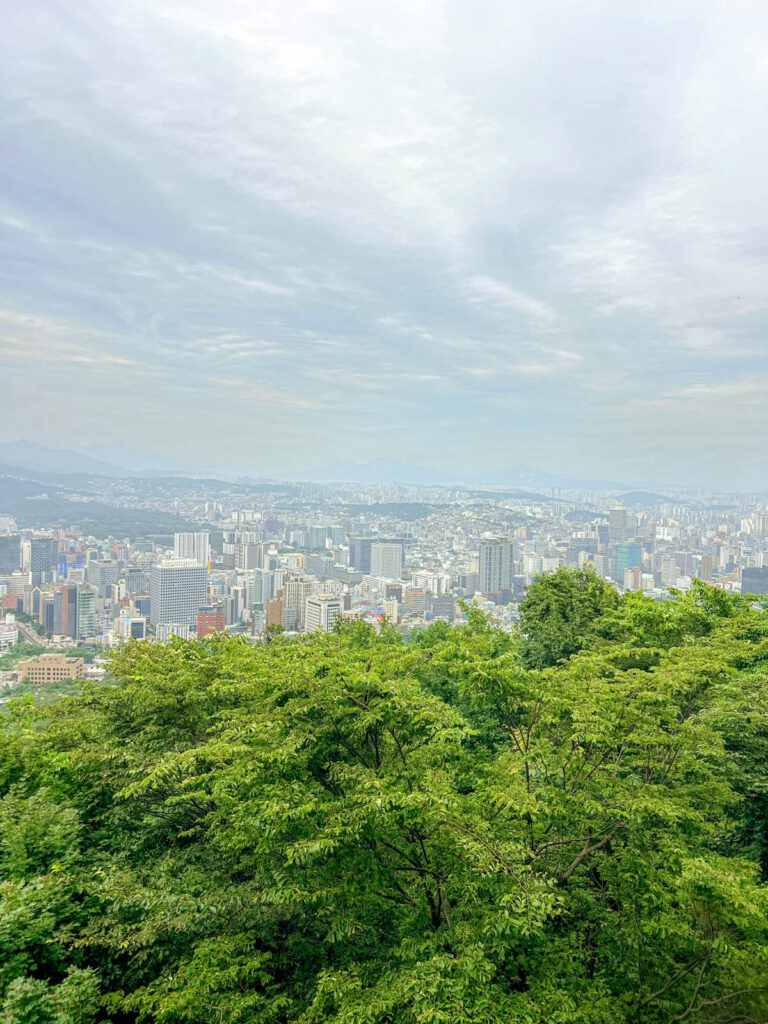
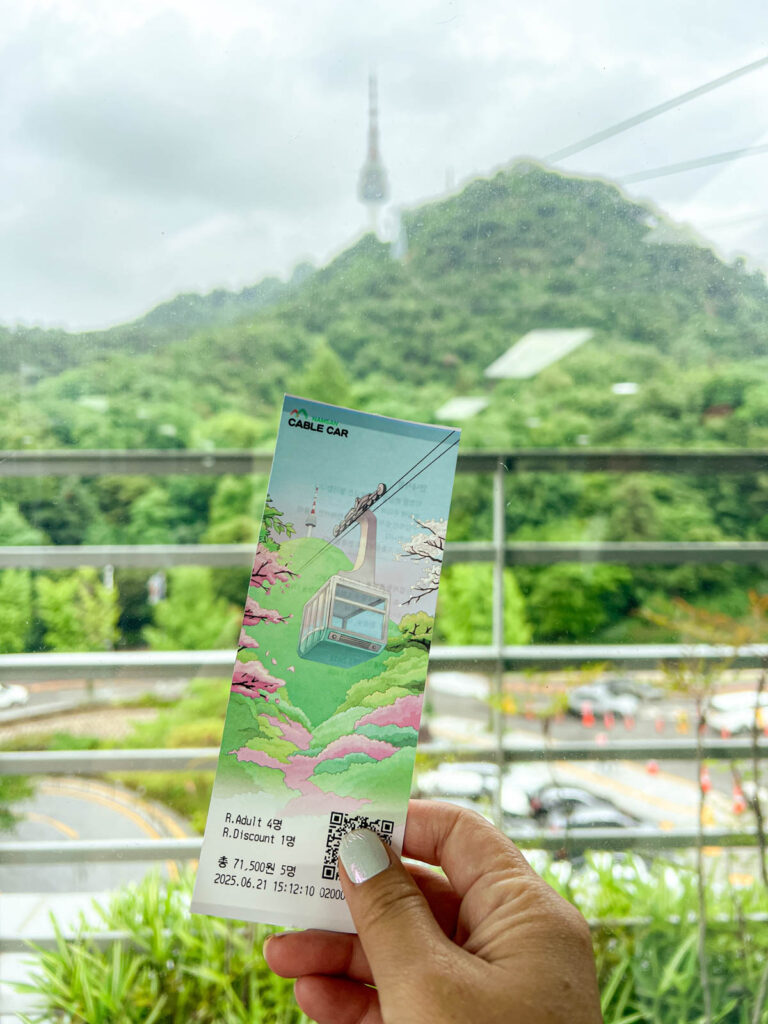
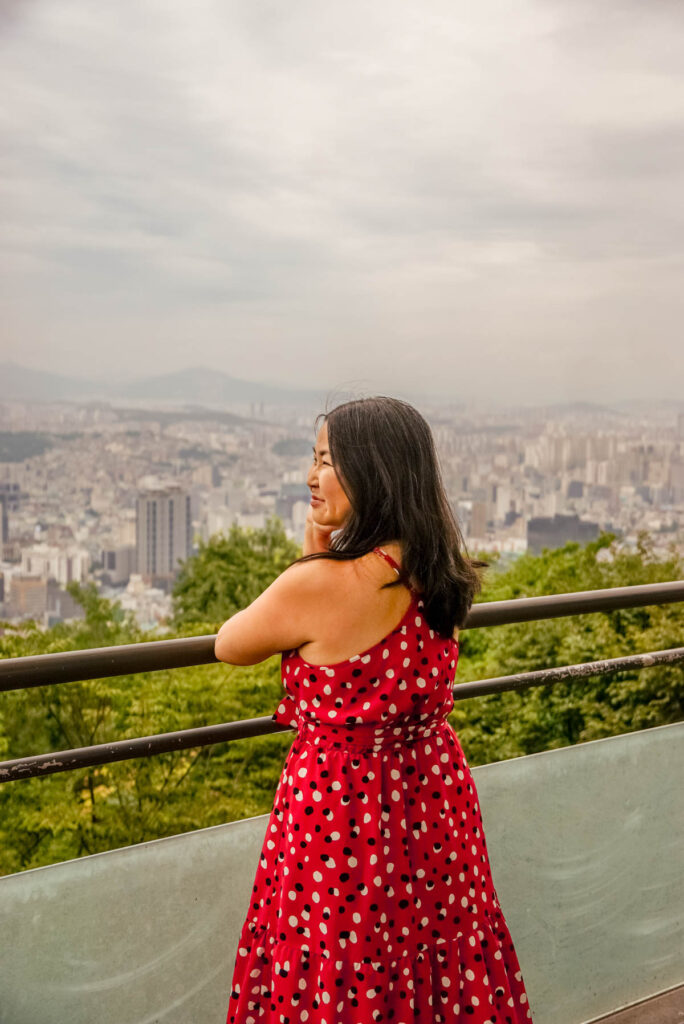
The most popular time to visit N Seoul Tower is for sunset, although you’ll have to allow plenty of extra time to catch the cable car. The lines will be LONG around this time, so if you’re planning to go for sunset, make sure you’re in line for the cable car at least 2 hours before.
As we had limited time with only 2 days in Seoul, we decided we didn’t want to wait 2 hours (we also had dinner plans), and opted to visit in the afternoon. We still found the views to be pretty incredible (even on a cloudy day)!
From the observation deck at the base of the tower, you can take in some incredible panoramic views of the entire city, with its towering skyscrapers set against the surrounding mountains in the distance. You’ll really get a sense of how big and dense the city is!
In addition to the observation deck, there’s a number of shops, walking trails, food vendors, and more at the base of the tower. We grabbed some beers and banana milk (a must-try while in Seoul!) and enjoyed them while taking in the views.
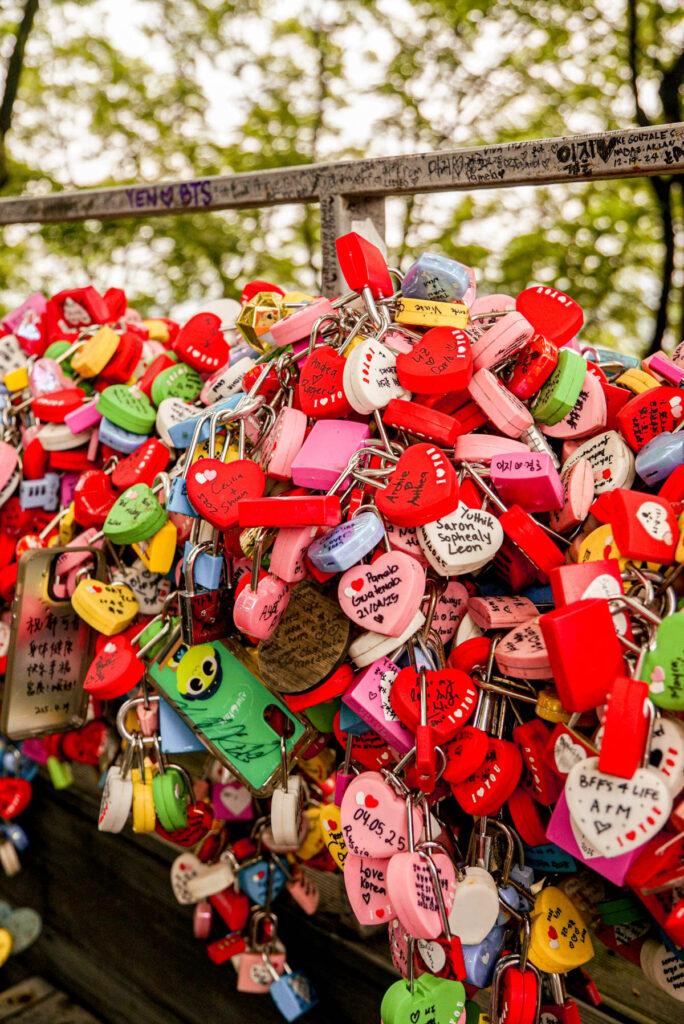
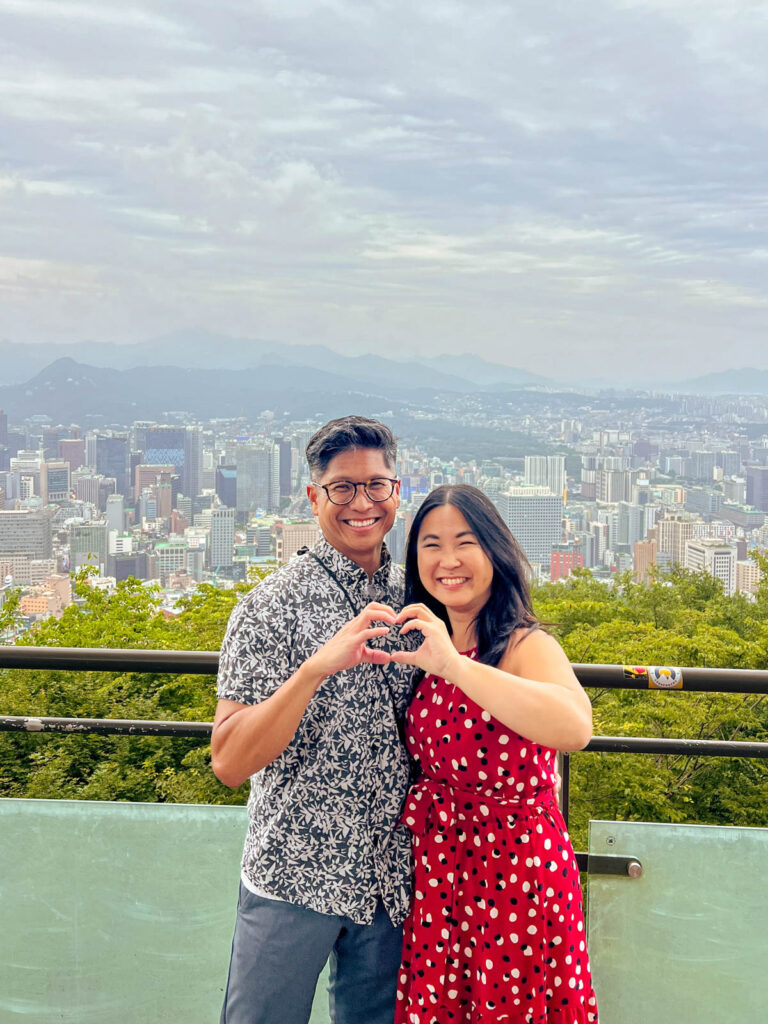
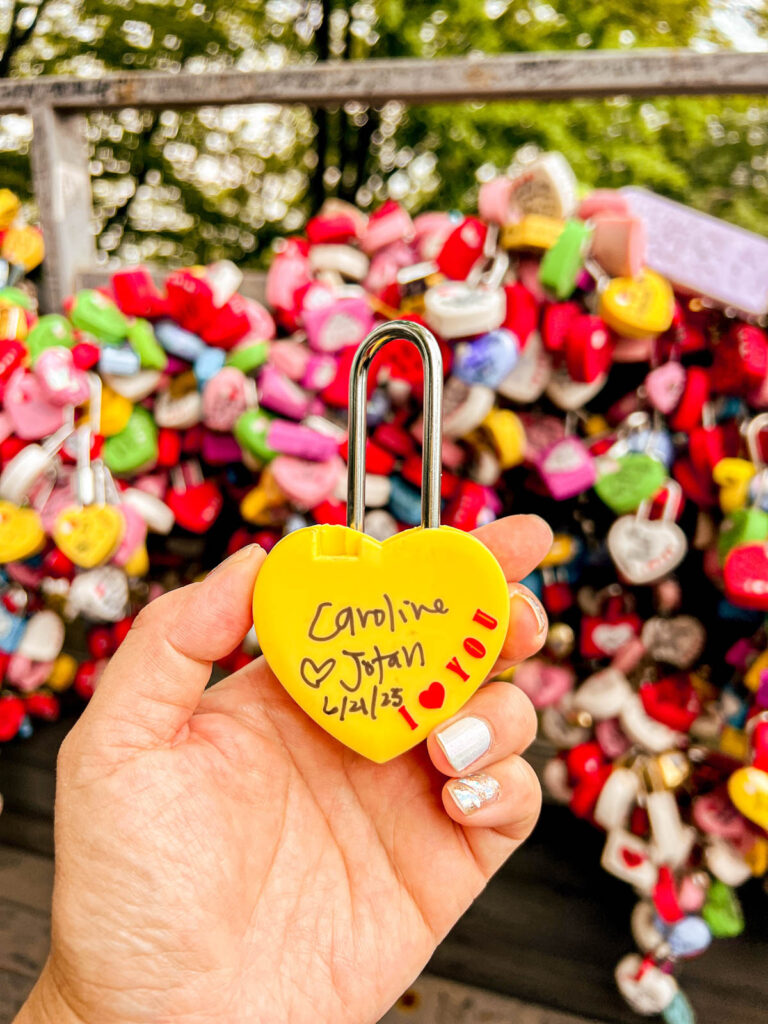
You’ll also see the famous love locks, thousands of colorful heart-shaped locks attached to the railings leading up to the tower. You can even add your own lock here – it is said that couples who attach their locks here will have their love last forever!
For even more amazing views, you can also go up to the observation deck at the top of the tower. From here, you can take in views from 784 meters high for a birds-eye view of the city. If you do choose to go up to the top, be sure to book your tickets in advance, as they do sometimes sell out!
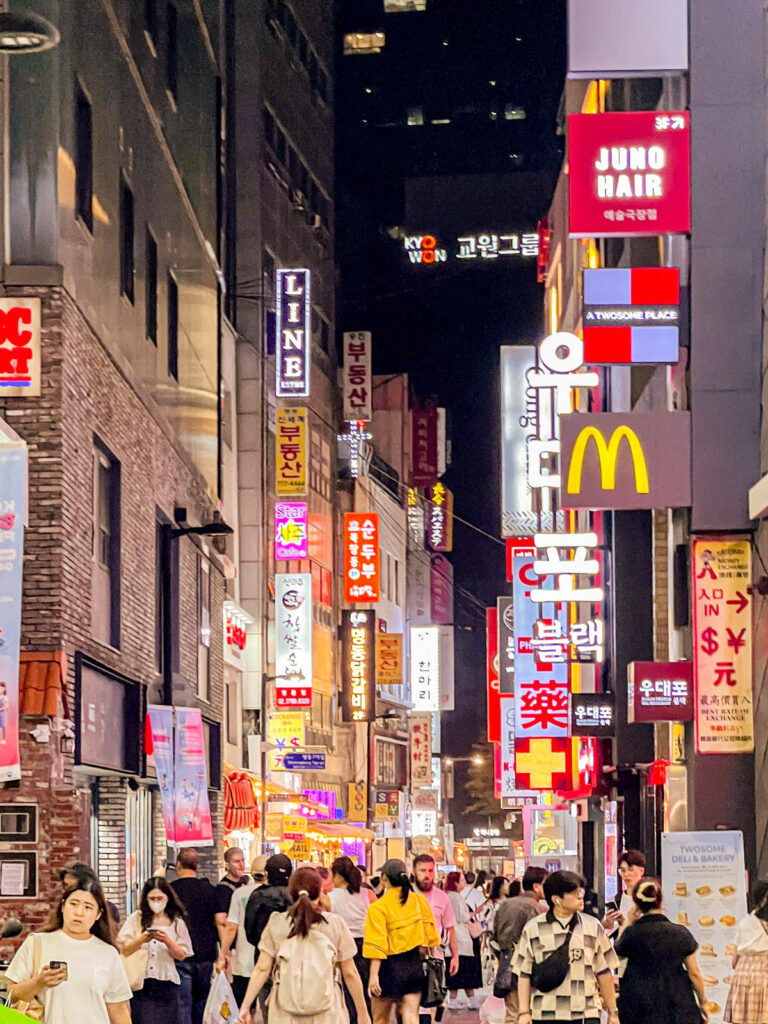
Myeongdong Night Market + Shopping
Next up, it’s time to head over to Myeongdong for some shopping and to check out the famous night market. The lively, bustling district is also one of the main shopping areas in the city, and shopaholics won’t be disappointed here. Even if you aren’t so much of a shopper, you’ll probably end up buying something lol.
You’ll find everything from name brand shops, skin care boutiques, fashion and accessories stores, and tons more. Some of the most popular stops include the flagship Olive Young (although there are several other Olive Youngs also within the neighborhood!), and a 12-story Daiso (which actually has a cool view of the N Seoul Tower from the top).
Pro Tip: If you plan to shop, carry your passport with you, as many stores will automatically give you a tax refund upon presenting your airport. This way, you won’t have to do it at the airport upon departure!
The shops stay open late – until 10 or 11pm – so you can pop into them in between tasting all the goodies offered at the night market.
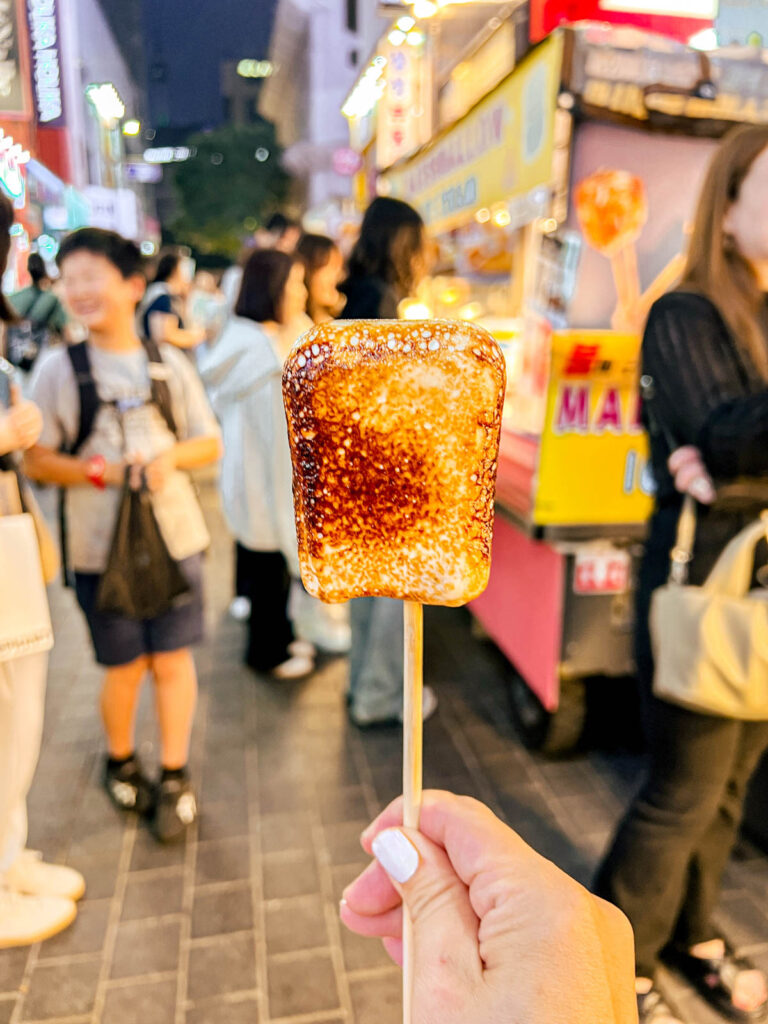
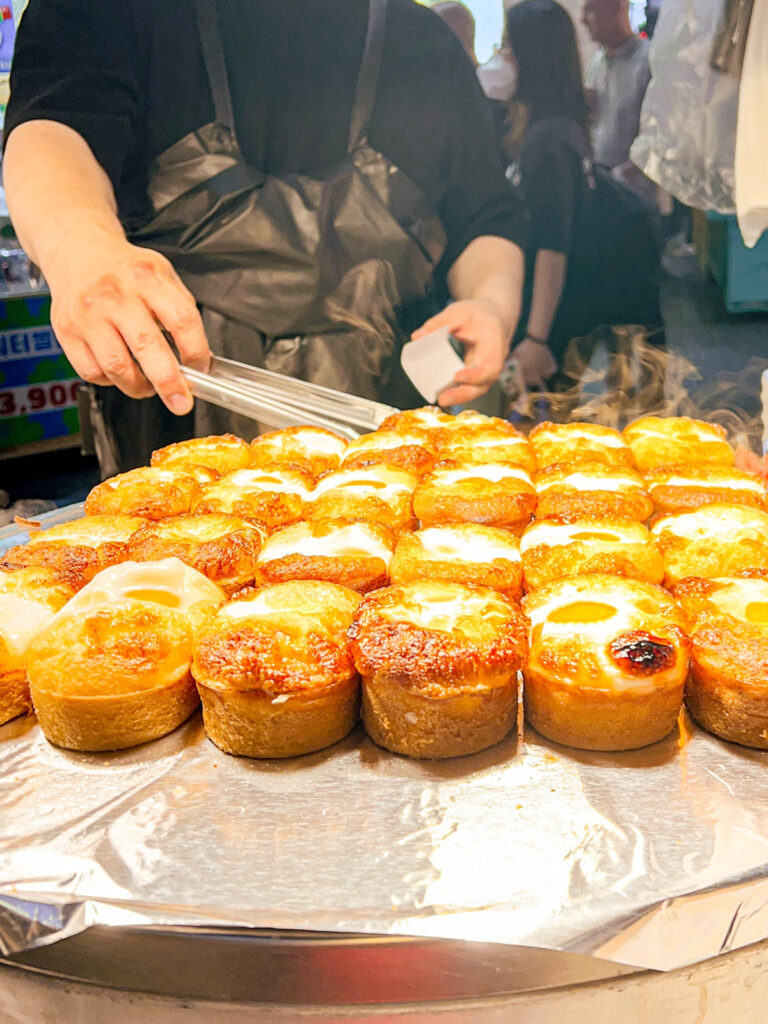
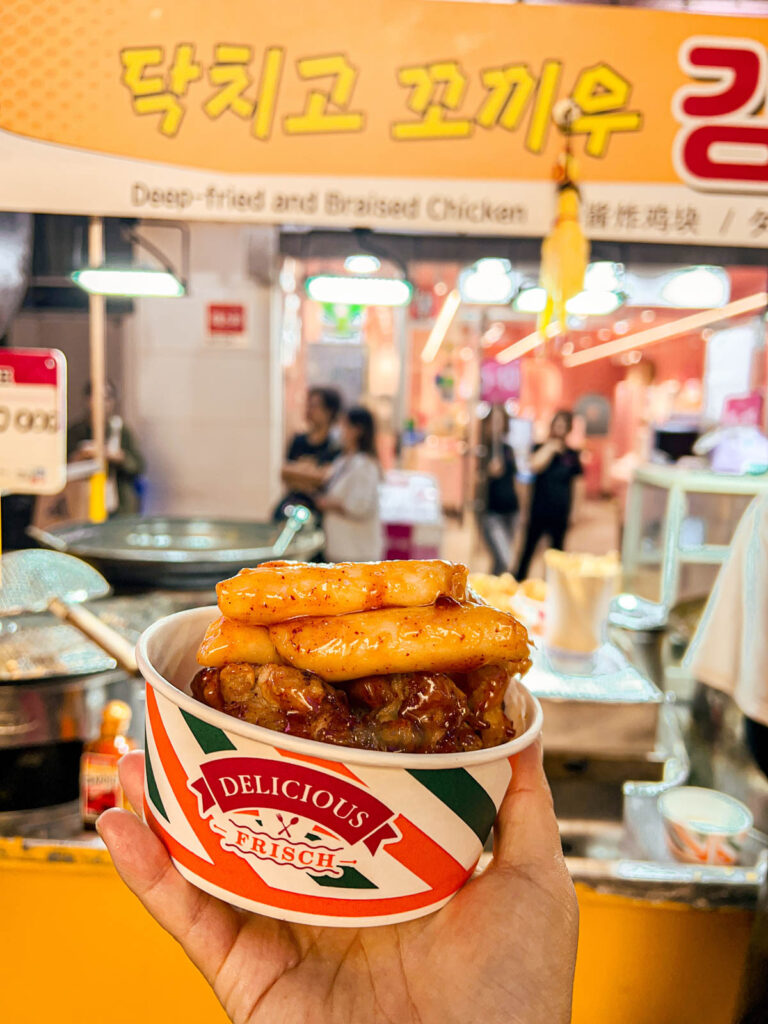
The night market is definitely the highlight of Myeongdong, and you’ll find vendors set up along both the main and side streets starting at around 5pm. There are tons and tons of yummy offerings, from BBQ skewers, grilled squid, roasted chestnuts, mochi, Korean corn dogs, and much more.
My favorites were the fire-toasted marshmallow ice cream, spicy tteokbokki with chicken, and egg bread (which several people told me to try, and it definitely was worth it).
DAY 2 (Cafe-hopping, Gangnam, and Traditional Markets)
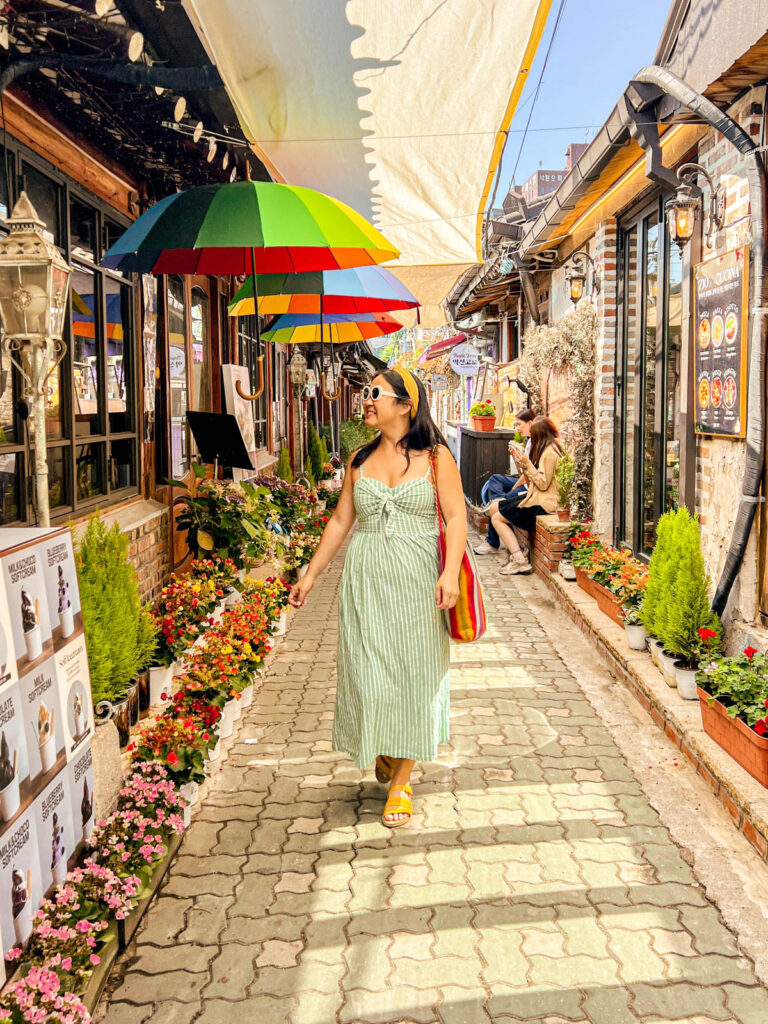
Cafe-hopping in Ikeson-dong Hanok Village
Your second day in Seoul will start off in the Ikseon-dong Hanok Village, one of the most charming areas in the city. While you’ll also find lots of traditional hanok buildings lining the narrow alleyways here, it’s got a completely different feel than the Bukchon Hanok Village, which you visited on day 1.
This is the oldest hanok village in the city, yet Ikseon-dong has a modern, trendy vibe. The hanoks here house cool boutiques, art galleries, breweries, restaurants, and some of the city’s trendiest cafes.
Seoul is known for its cafe culture, boasting tons of unique cafes. Spend your morning checking out at least a few of them in Ikseon-dong, as you’ll find some of the best ones here!
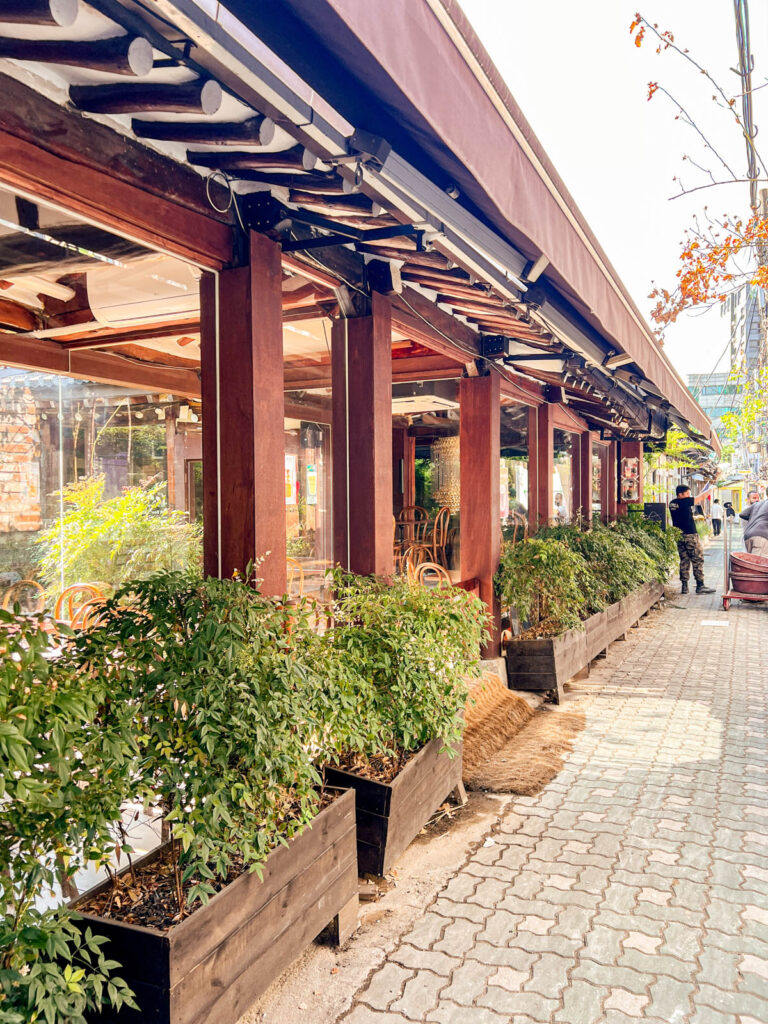
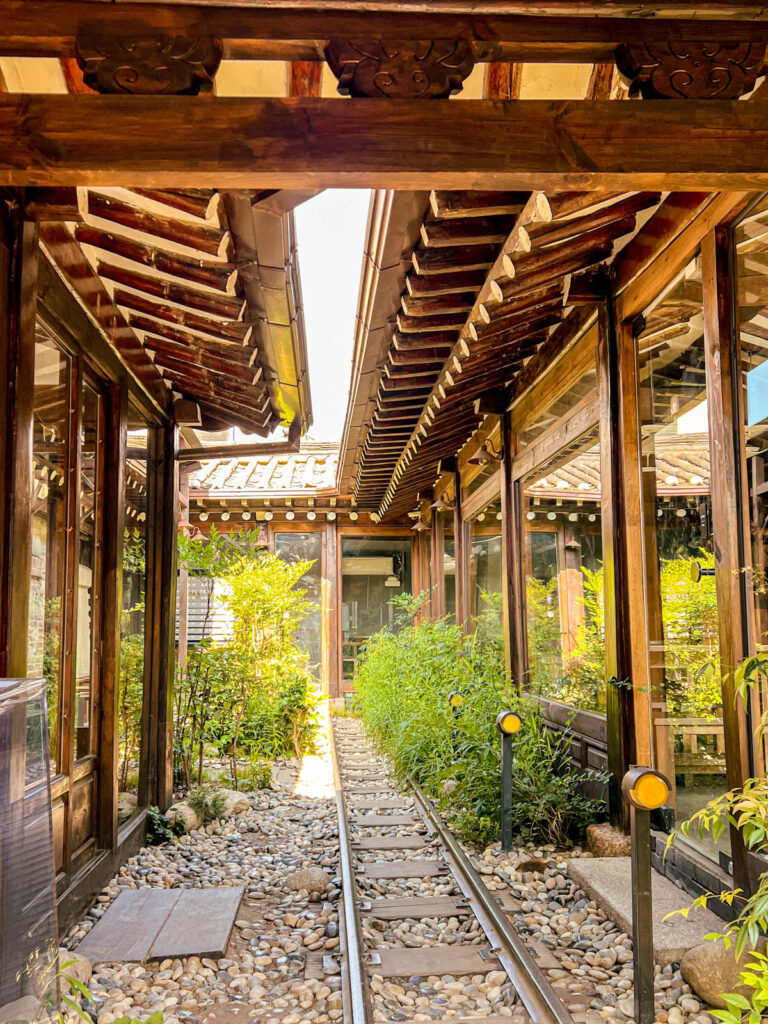
Do note that many of the cafes tend to open late, around 10 or 11am (as do most of the shops). However, if you’re trying to be efficient (like we were!), there are a handful of cafes that open earlier, that you can hit up first. I suggest getting there a little bit before opening, as you’ll already see a line start forming.
You’ll likely only have time to hit up 1-2 cafes (you are trying to see Seoul in 2 days, after all!), but that’s enough to get a taste for Seoul’s cafe culture.
Here are some of the notable cafes in the Ikseon-dong Hanok Village:
- Mil Toast: This viral cafe opens at 8am, which is the earliest in the area (and one of the earliest in the city in general). They’re known for their toasts and steamed breads. Be sure to get there early to avoid a line – we strolled up around 8:20 and already found a loooong line that looked like it was going to take an hour+, so we skipped it.
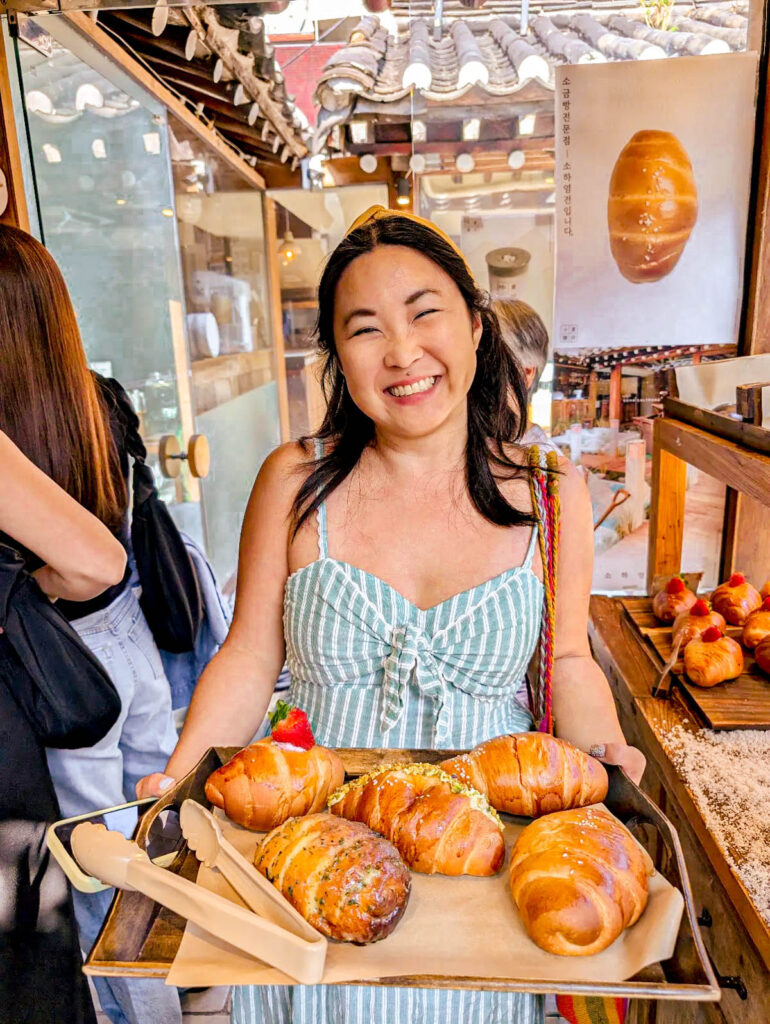
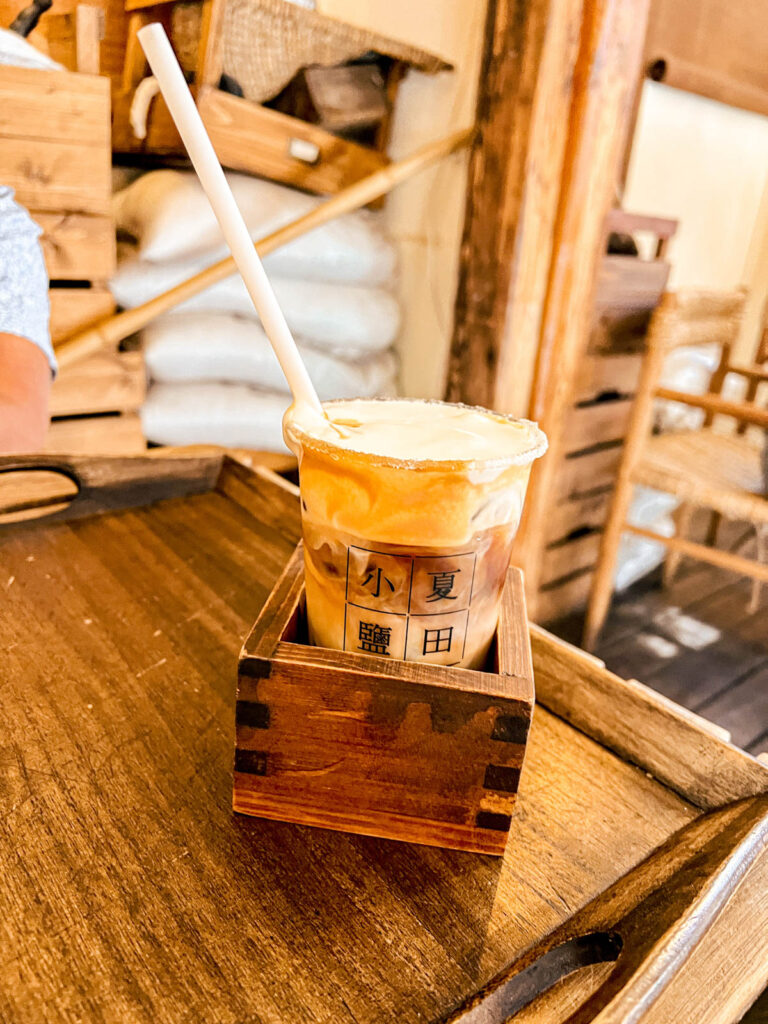
- Soha Salt Pond: This is where we went instead, since it was opening at 9. By 8:45, there was a small line forming. Soha Salt Pond is one of the most aesthetic cafes in the area, and really plays up the salt theme. They’re known for their salt breads, and you’ll find many varieties here – our favorites were the strawberry and the garlic.
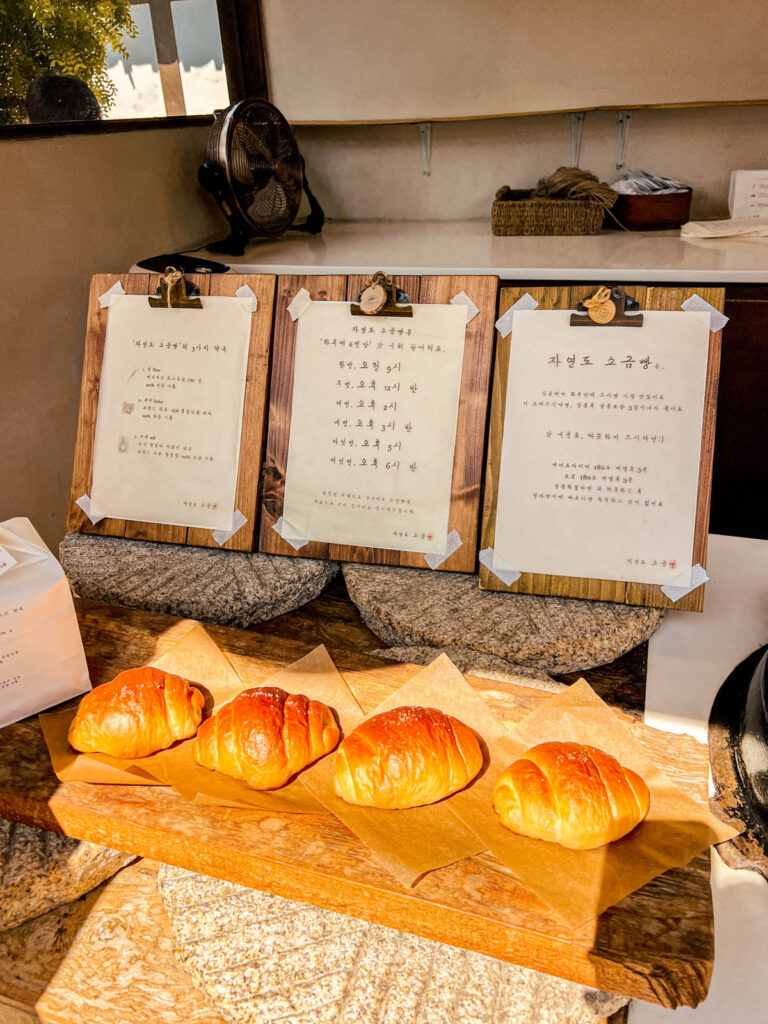
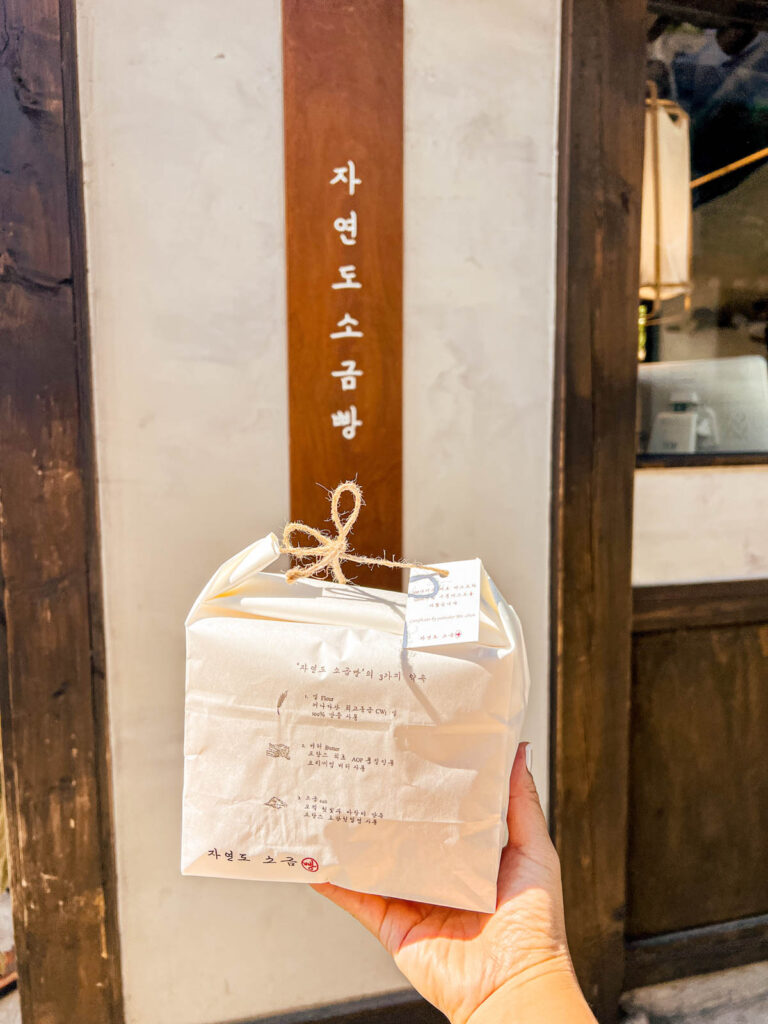
- Jayeondo Salt Bread: The salt bread here is absolutely to die for – buttery, soft, and warm! This is more of a grab-and-go place rather than a sit-down place, but it’s an absolute must. They’ve got multiple locations around the city, so if you don’t go to this particular location, make sure you stop by one of the others.
- Nakwon Station Cafe: Famous for the train track that runs though the cafe, as well as having cakes served conveyor-belt style.
- Cheongsudang Bakery: This cafe has a gorgeous aesthetic, starting with the stone bamboo path you’ll walk through to get to the entrance. You’ll feel like you’re hanging out in a lush Zen garden!
Explore Gangnam
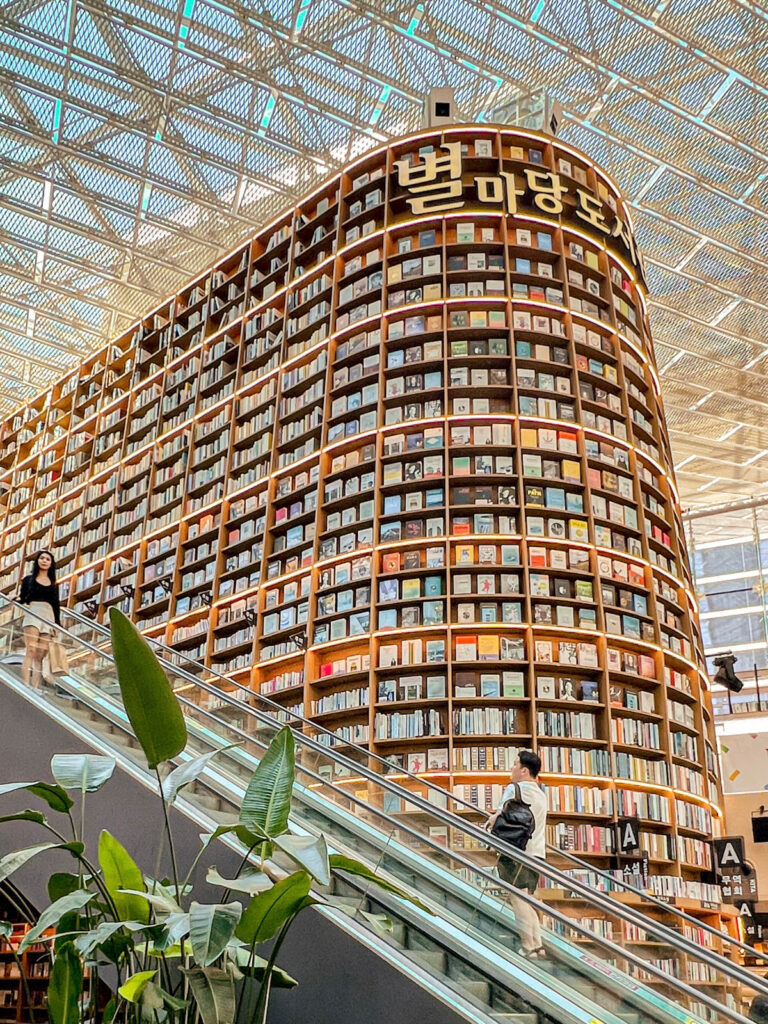
If you’ve paid any attention to pop culture over the last decade or so, you’ve probably heard of Gangnam thanks to the chart-topping song, “Gangnam Style.”
Gangnam is considered to be the Beverly Hills of Seoul (similar to how Polanco is the Beverly Hills of Mexico City), where all the city’s wealthiest occupants live and hang out. It’s famous for its luxury shops, as well as its cosmetic surgery clinics. If you’re interested in getting some K-Beauty treatments done, this is definitely where to go!
Even if you aren’t interested in high-end shopping or getting plastic surgery, there are some cool attractions in between. It’s definitely a worthwhile stop to explore for a few hours, to see a different side of Seoul.
It takes about 45 minutes via subway to get to Gangnam from the Ikseon-dong area, but we found it fairly easy to navigate and get to.
Here are some of the top things to do in Gangnam:
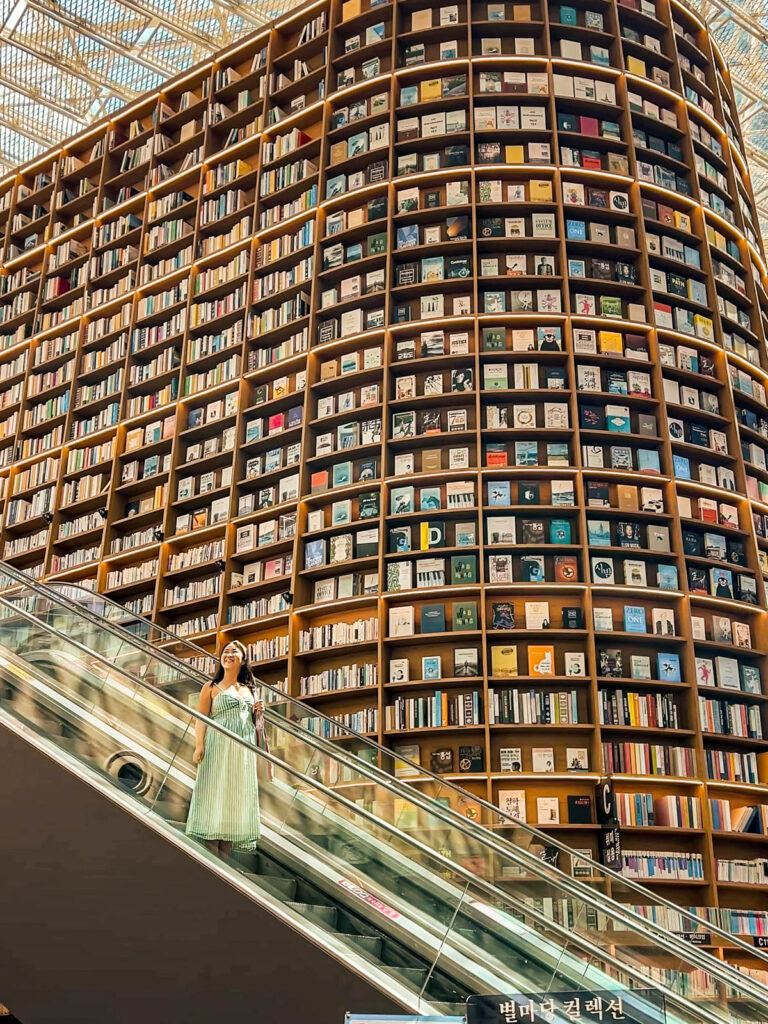
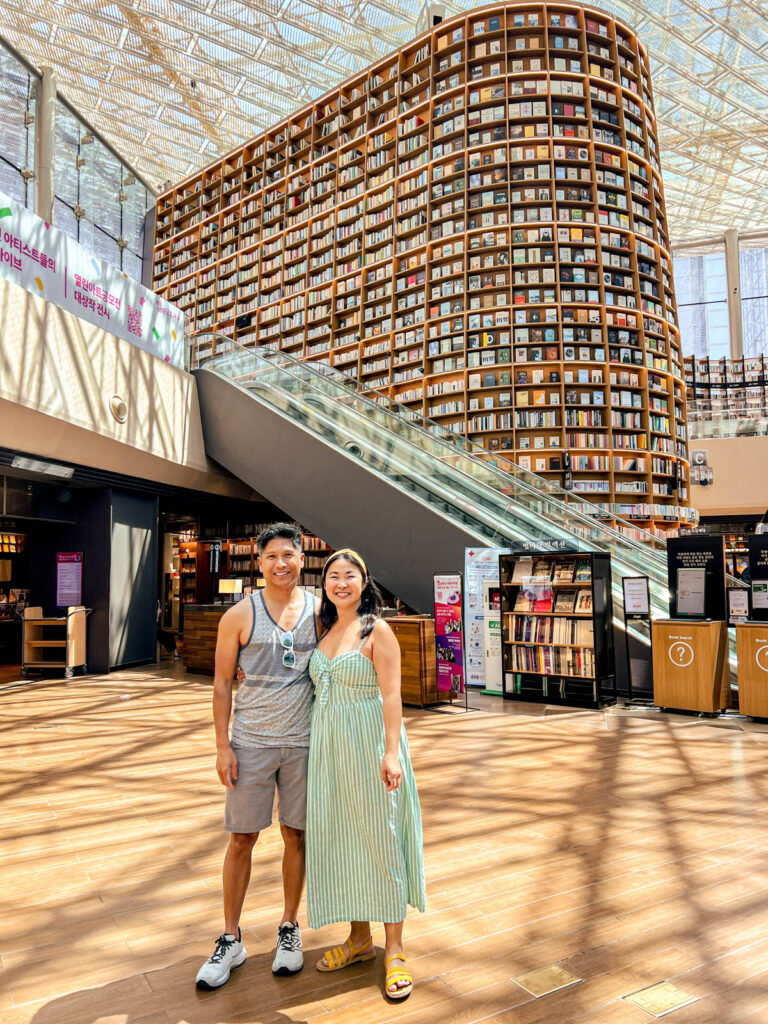
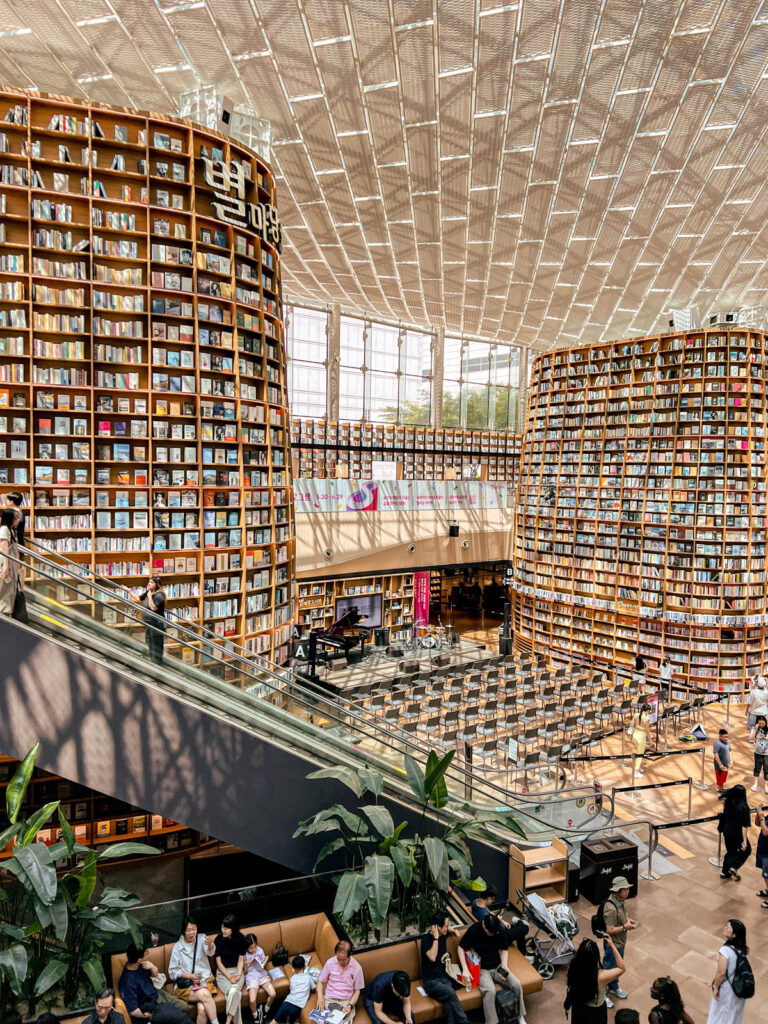
- COEX Mall + Starfield Library: You’ve likely seen this futuristic library on Instagram at some point in time (it’s one of the first things I saved when I started my account back in 2017). You’ll find thousands of books, which you can actually check out, housed in towering shelves. It’s definitely a must for book lovers! Aside from the library, you can also grab a coffee from % Arabica, and go check out the shops, movie theater, or aquarium.
- Bongeunsa Temple: Located directly north of COEX Mall, the Bongeunsa Temple is considered to be one of the most beautiful temples in Seoul. It dates back to the 8th century, although most of it was rebuilt in the 20th century. The complex is huge, and holds a number of memorials, places of worship, and buddhas.
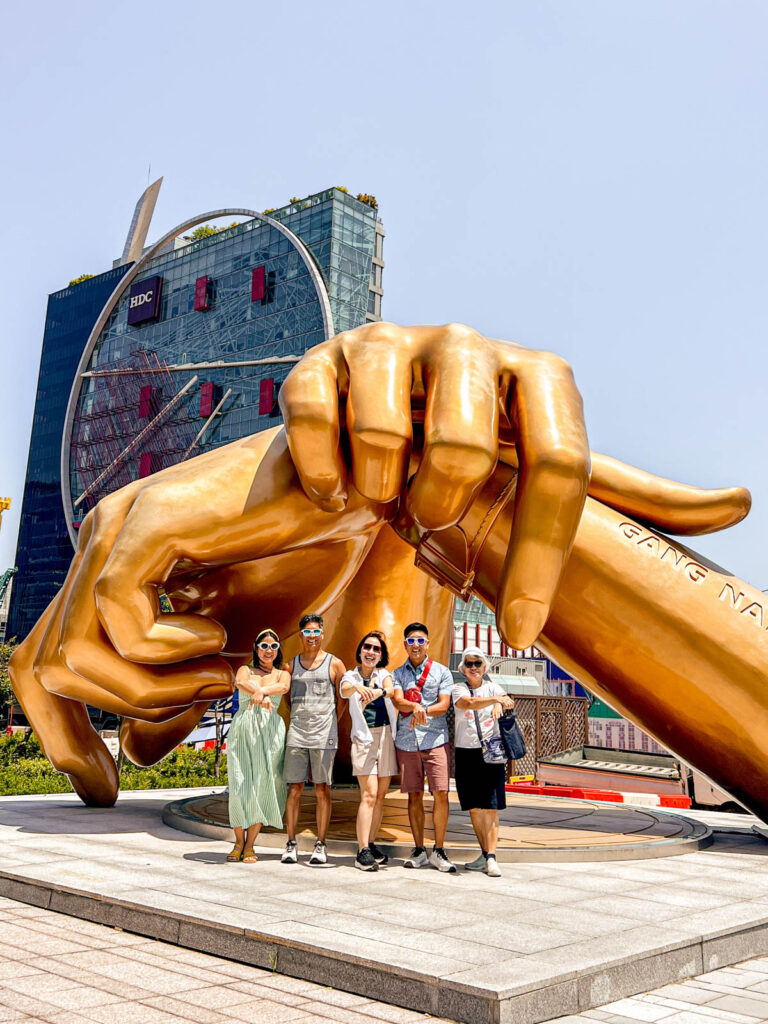
- Gangnam Style statue: This large, bronze-style sculpture is one of Gangnam’s quirkiest attractions, depicting the hands that were used in dance from “Gangnam Style.” It’s a worthwhile stop for a quick photo – there’s even a stand you can use to prop up your phone for the perfect selfie.
- K-Star Road: One of the most whimsical attractions in the area, this street is lined with around 20 “GangnamDols,” large, colorful bear statues representing some of the most famous K-pop acts.
Lotte World Tower + Seoul Sky (Optional)
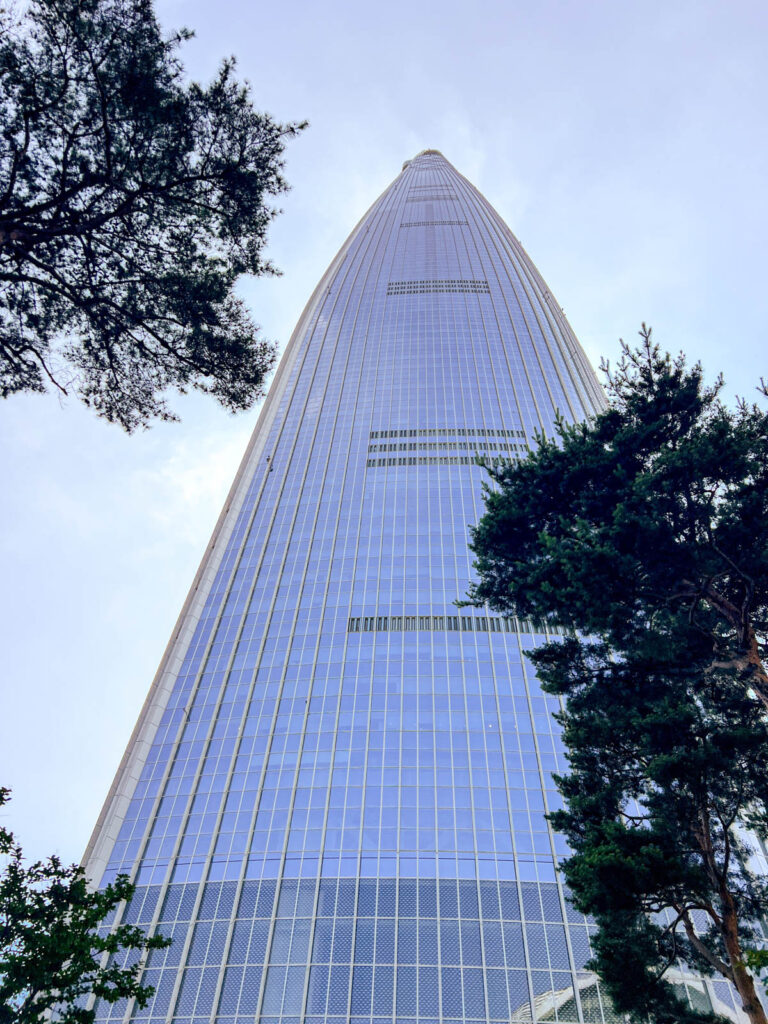
Located not too far from Gangnam in neighboring Jamsil is the Lotte World Tower, the sixth tallest building in the world. It’s worth a stop if you’re into observation decks and city views, but if not, feel free to skip it (you probably have limited time, after all).
The first 10 or so floors of the tower make up the Lotte World Mall, the largest shopping center in Seoul. Here, you’ll find hundreds of shops, as well as restaurants, cafes, a movie theater, aquarium, art galleries, a theater, and more.
We ate lunch at the food court here on the 6th floor. You’ll find a bunch of different restaurants here, each focusing on a different type of Korean cuisine (as well as a handful of non-Korean eateries). We ended up eating at a random spot, which ended up being delicious! I’m not sure what the place is called (the signs were all in Korean), but they had grilled short rib and pork patties, which come with a platter of various Korean side dishes.
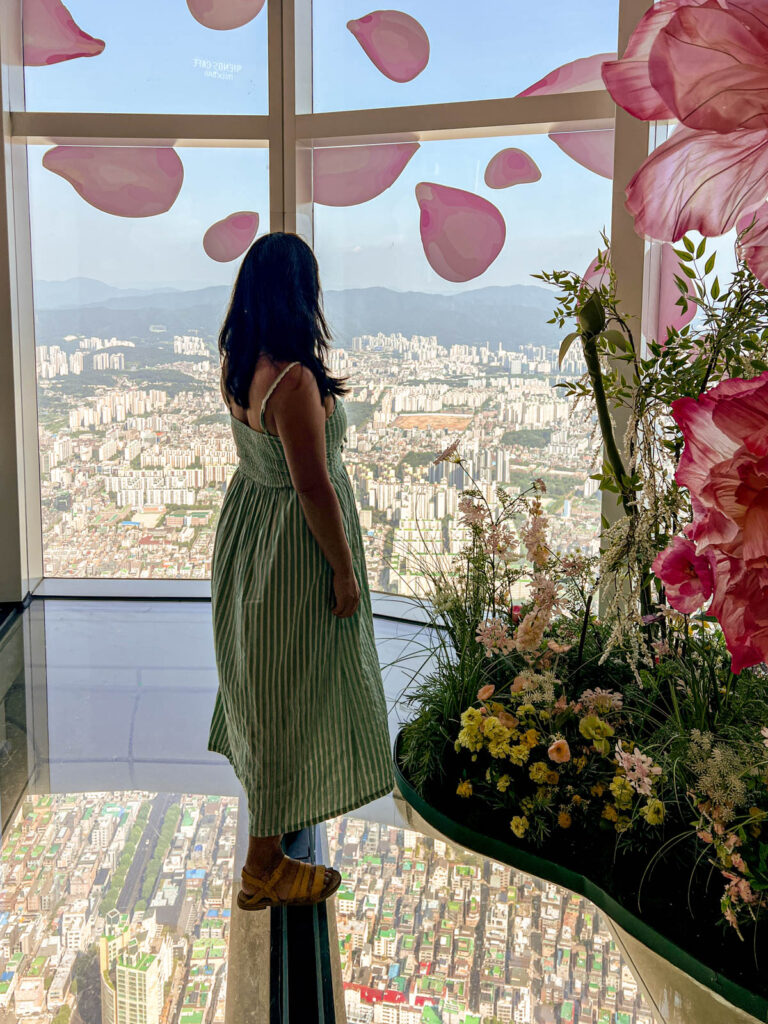
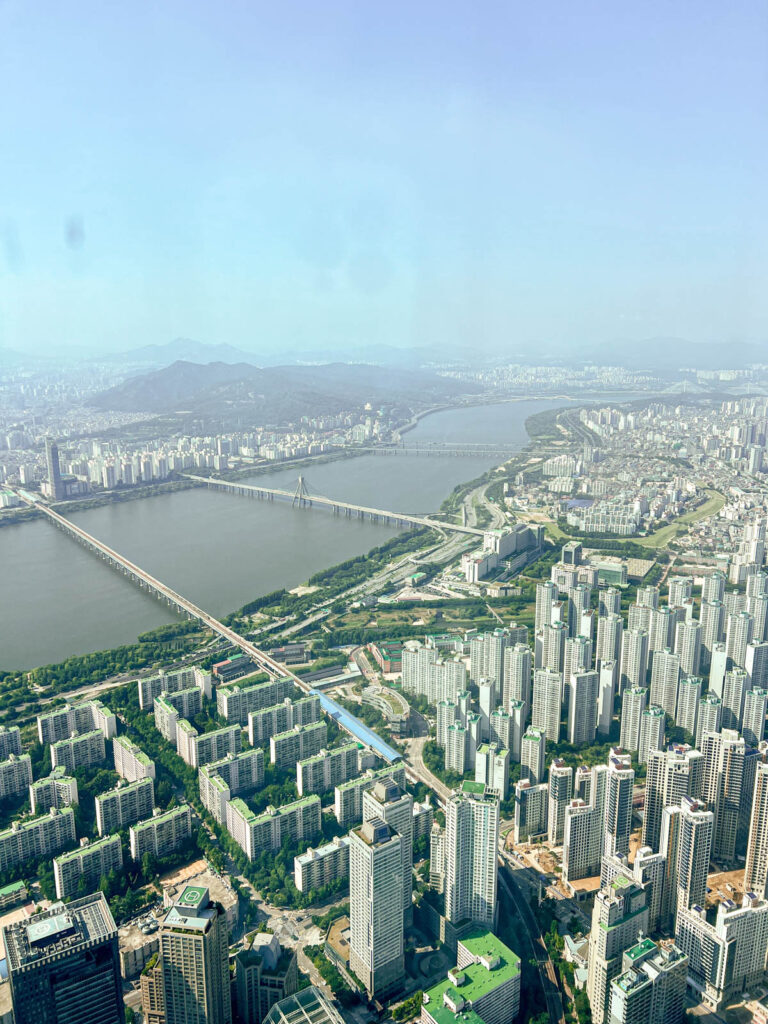
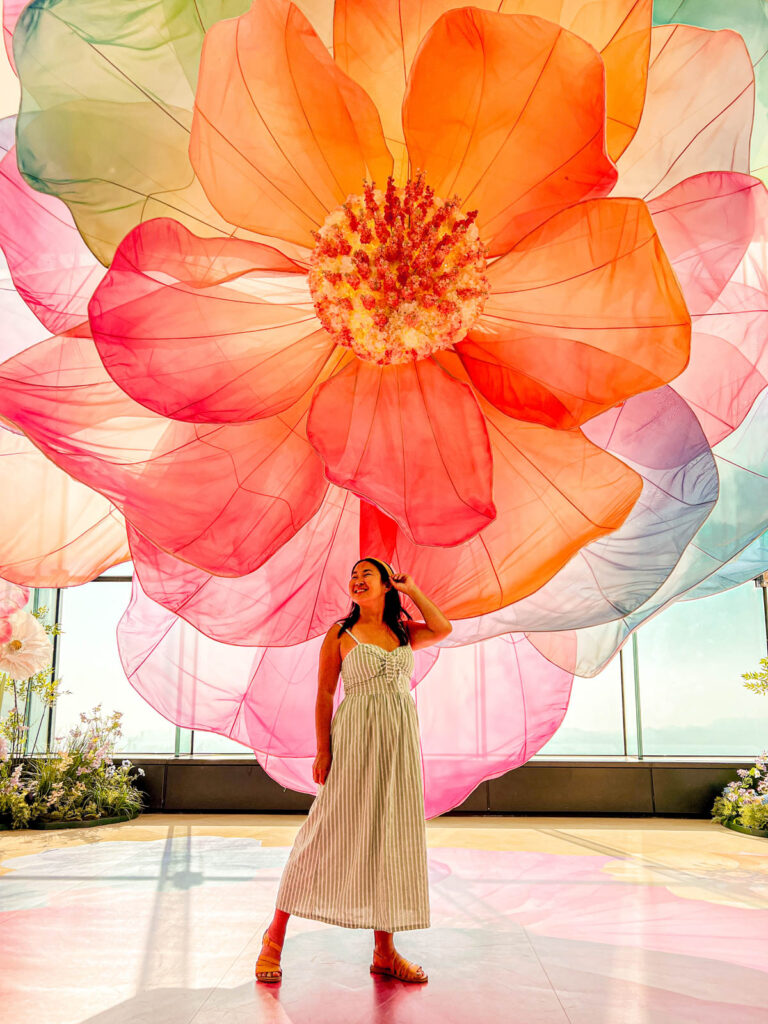
On floors 117-123 is Seoul Sky, one of the highest observation decks in the world. I highly recommend booking your tickets in advance to avoid any lines in the ticket office (and to avoid the chance of sellouts).
From here, you can catch a birds-eye view of the entire city, its skyscrapers, the Han River, the surrounding mountains, and even some of the neighboring cities.
There’s a glass floor (similar to the one at Skydeck in Chicago), as well as numerous photo ops and art installations. Daredevils can also partake in the Sky Bridge experience, from where you can walk across the outdoor bridge connecting Lotte World Tower’s two structures.
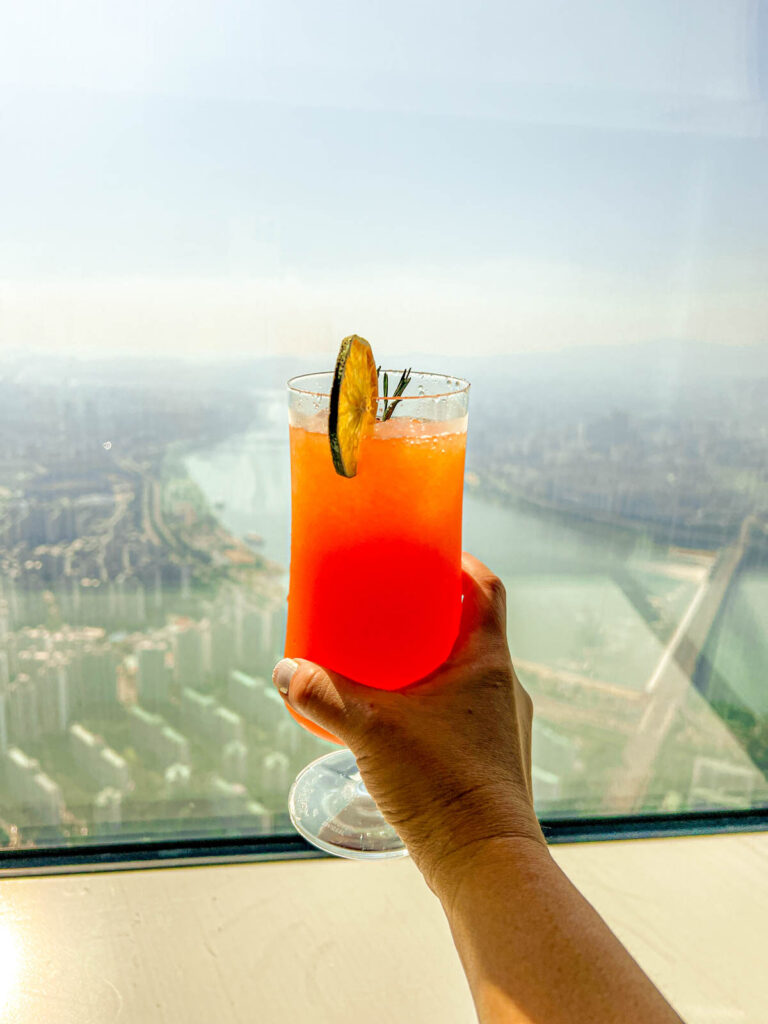
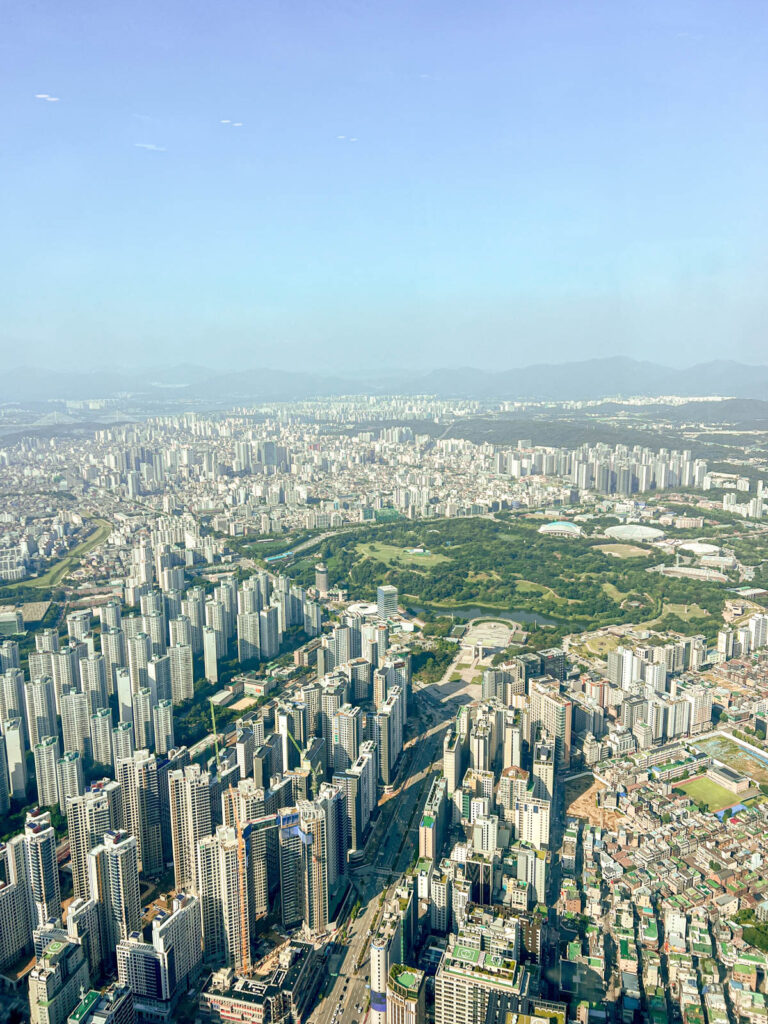
If you’re less adventurous (like me haha), I still highly recommend grabbing a drink at the 123 Lounge, the restaurant and bar located on the 123rd floor. Here, you can sit and relax with a cocktail in hand – the perfect way to take in those views. The experience is kinda trippy though, because you’re up so high – you can feel the tower swaying in the wind!
Just outside of the tower is the Seokchon Lake, which is a nice spot to get some fresh air, relax, and do some people watching. If you’re visiting during cherry blossom season, it’s definitely a must, as it’s got some of the most gorgeous blossoms in the city. It’s also supposed to have some beautiful fall foliage as well.
Gwangjang Market
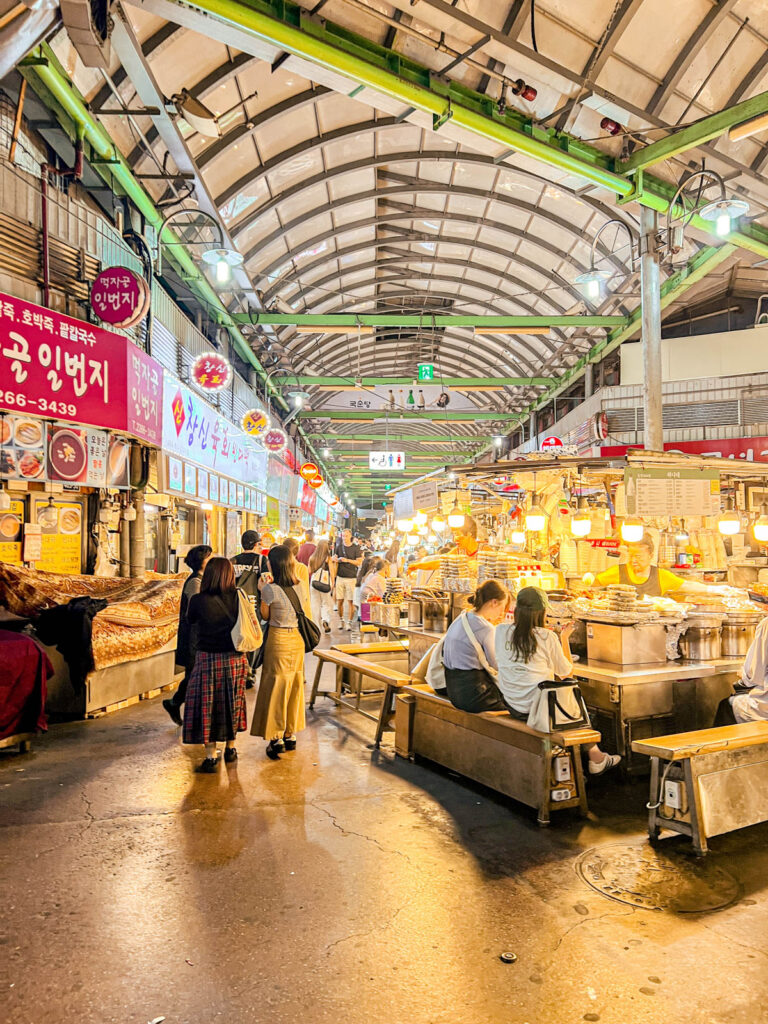
Afterwards, head on over to Gwangjang Market, one of the oldest traditional markets in South Korea. There are several other traditional markets in the city, but Gwangjang is one of the largest. It’s also the most visited, thanks to its popularity after being featured in the Netflix show, Street Food Asia. In fact, you’ll see a number of stalls posting up signs indicating that they were featured in the show.
It’s HUGE and it’s super busy, so it can definitely feel overwhelming at times! One thing I really wish was to take a food tour of the market, so a local guide could take me to all the best spots.
The market has thousands of vendors selling everything from tteokbokki, gimbap, mandu, noodles, pancakes, skewers, and every other kind of Korean street food you can think of.
One of the most famous stalls here is run by Cho Yonsoon, aka “the Netflix lady,” who featured prominently on the show for her knife-cut noodles. It can be a bit confusing to find – she’s at stall #70, but the stalls are numbered weird so it might take a bit of walking around to find it. Eventually we did, but we decided to come back on a different day – sadly, she was closed when we came back, so we never got to try it.
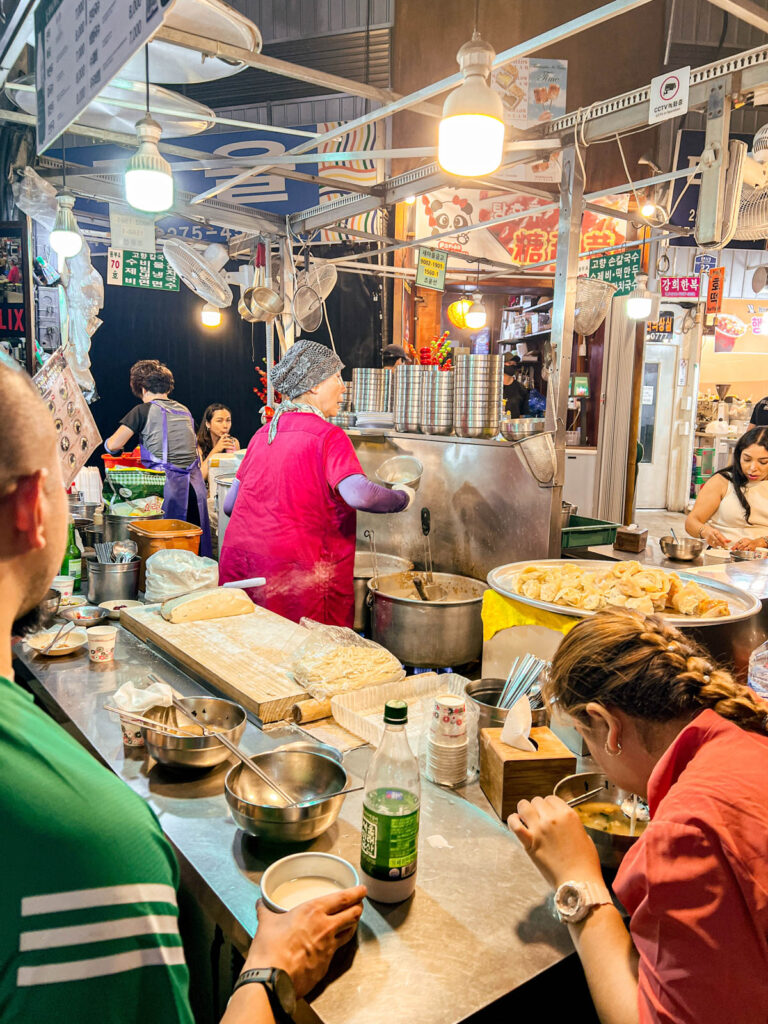
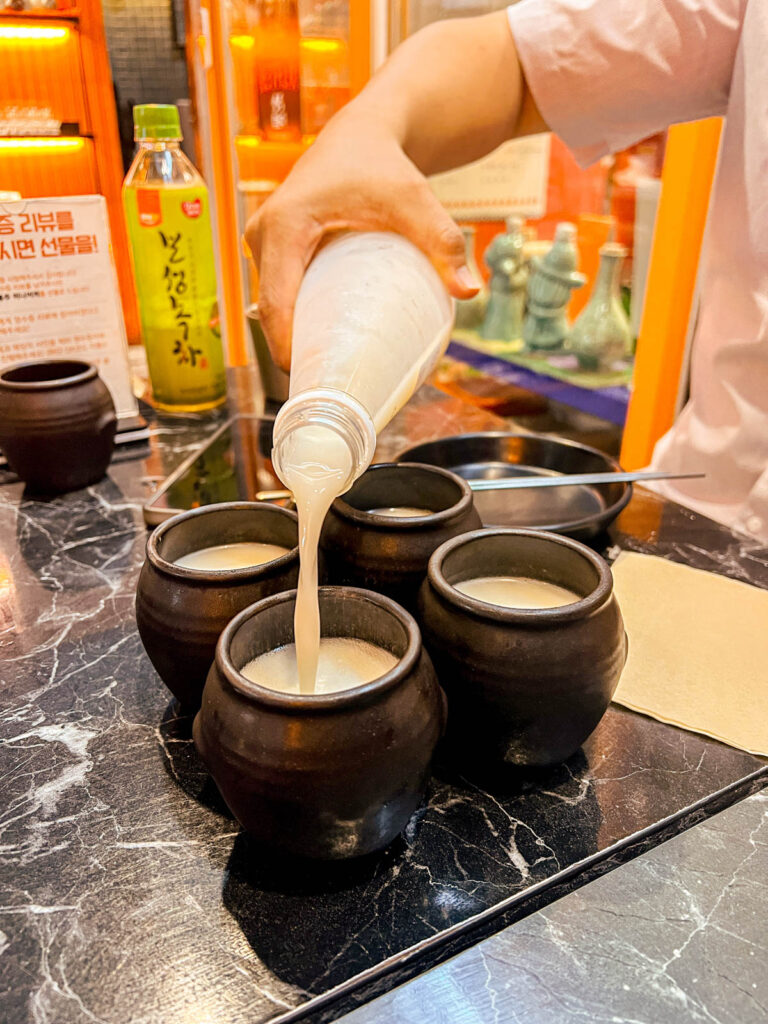
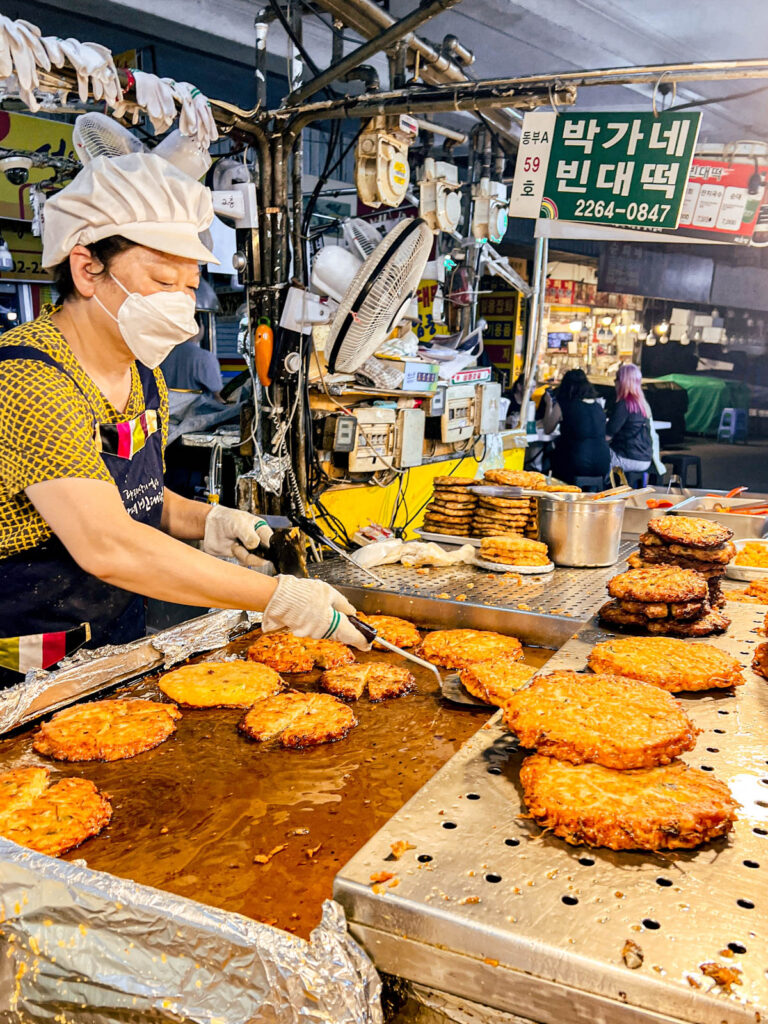
So, while the market is technically open 7 days a week, I recommend not coming on a Monday, as we found that in addition to her stall, several others were closed.
And definitely come hungry, because there’s a tonnnn of food here! We weren’t very hungry when we came, so we didn’t really try much but I really enjoyed being able to take in the sights, sounds, and smells of the market, which is always bustling with activity.
We did get to try some makgeolli, Korean rice wine. The place to go for this is Ho Seonsaeng Jeon. They have a whole refrigerated room full of makgeolli, available in a ton of different varieties – I really loved the chestnut one, which was sweet, toasty, and almost tasted like caramel.
Another super popular item here is the kkwabaegi, essentially a twisted donut. The stall is located near the entrance, and it’s hard to miss thanks to the long line (going around the block) of people waiting. Sadly, we were too lazy to wait in line so we didn’t try it, but our local friend said it was definitely worth it!
Night walk along Cheonggyecheon Stream
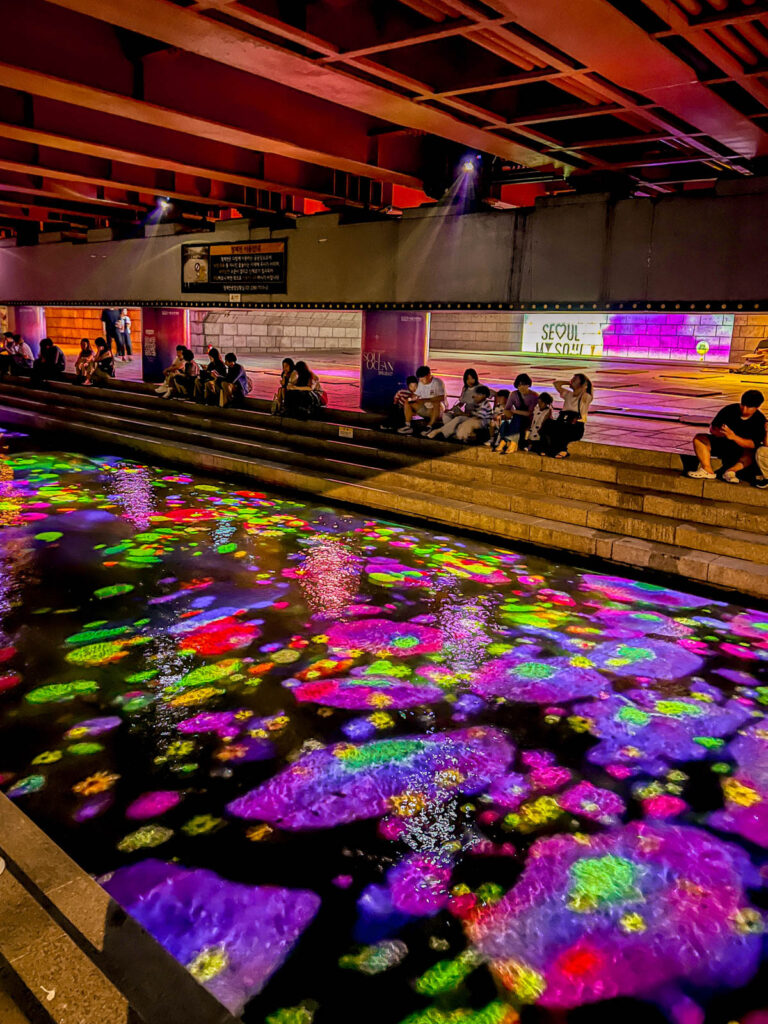
Now it’s time to walk off all that delicious food you had at the market! The perfect place to do so is at the Cheonggyecheon Stream, a 10.8 kilometer stream that flows through downtown Seoul and into the Han River.
It was part of an urban renewal project in Seoul, and it feels like a bit of a respite in the middle of the bustling city. Taking a nighttime stroll here is the perfect way to wind down and end your 2 days in Seoul!
The stream is a popular hangout spot for locals (we saw so many people on dates here), and it’s been featured in several popular K-dramas.
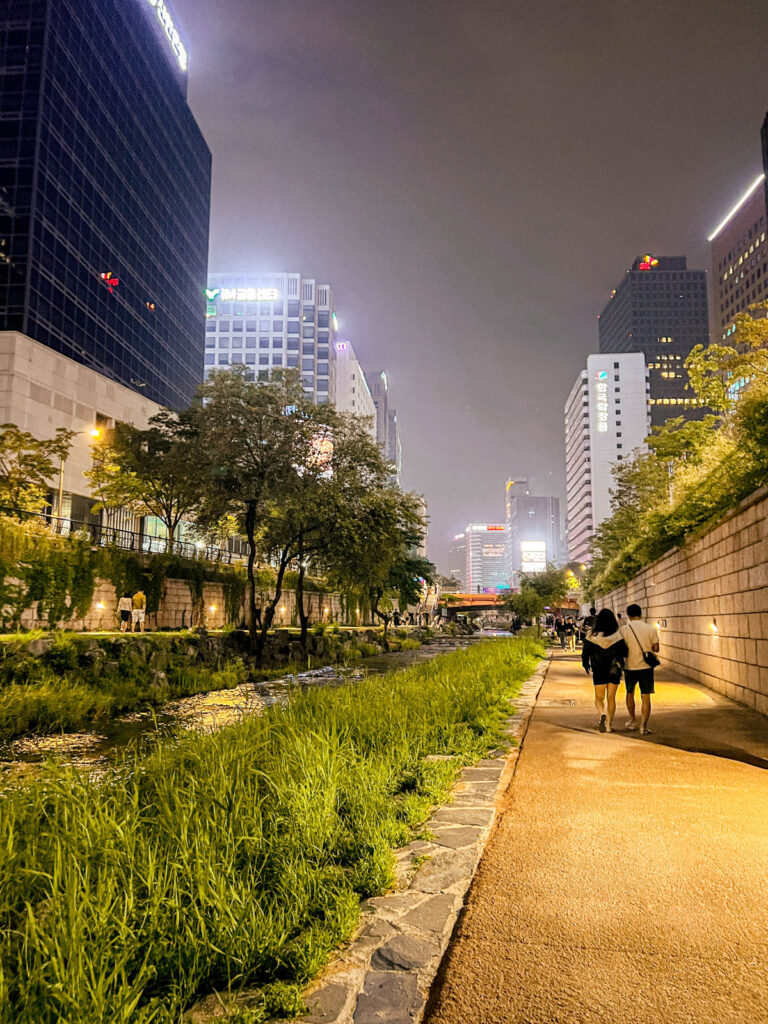
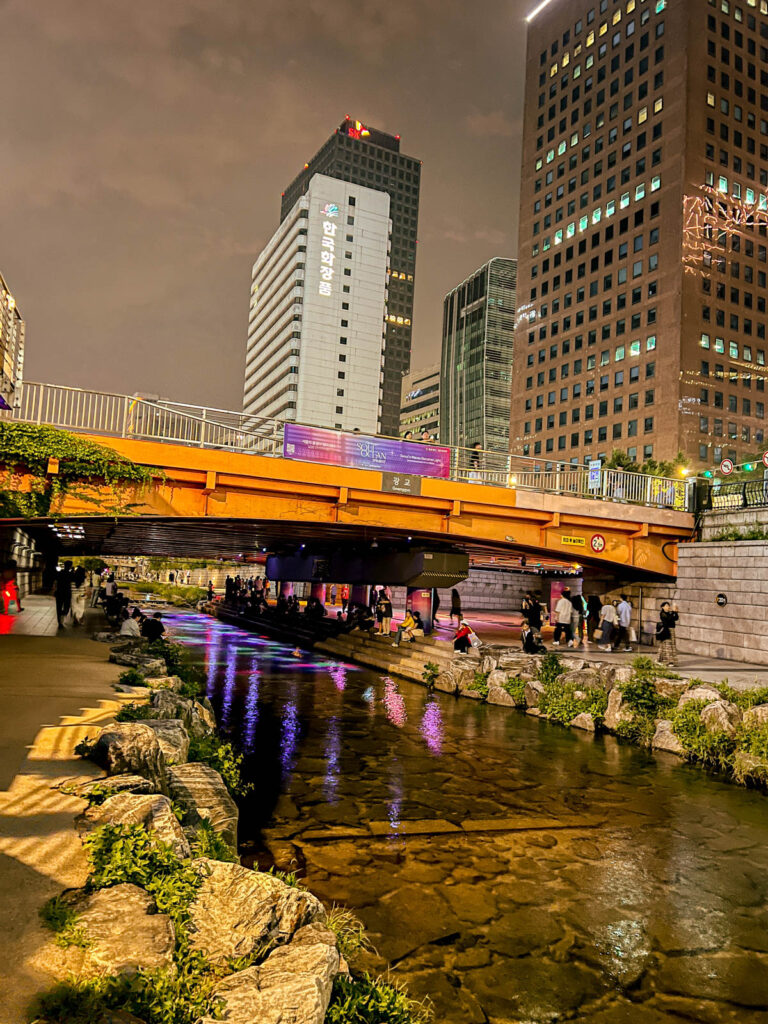
You definitely don’t need to walk the whole thing, but it’s definitely worth walking through at least a part of it! Along the way, you’ll find manmade waterfalls, tons of bridges (22 to be exact), and plenty of art installations.
While we were here, they were playing a projection show directly into the water, which was super cool to see! In the winter, it also plays host to the Seoul Lantern Festival. During this time, you’ll also see the stream dotted with illuminated lanterns, light installations, and even a Christmas Market.
Where to Eat in Seoul
One of my favorite things that I did in Seoul – eating alllll the things! All the food was incredible, and I don’t think we had a bad meal.
While I usually include places to eat as part of my itineraries, I decided to list them in a separate section. Some of the places we went to were local spots that our local friend took us to, that might be a bit far from the main attractions included as part of this Seoul itinerary.
However, we had some of the most amazing meals there, so I wanted to include them in case you’re feeling adventurous and want to seek out something that’s a bit more off the beaten path. We had plenty of delicious things that were also close to the main tourist drags, so I’m including those here as well!
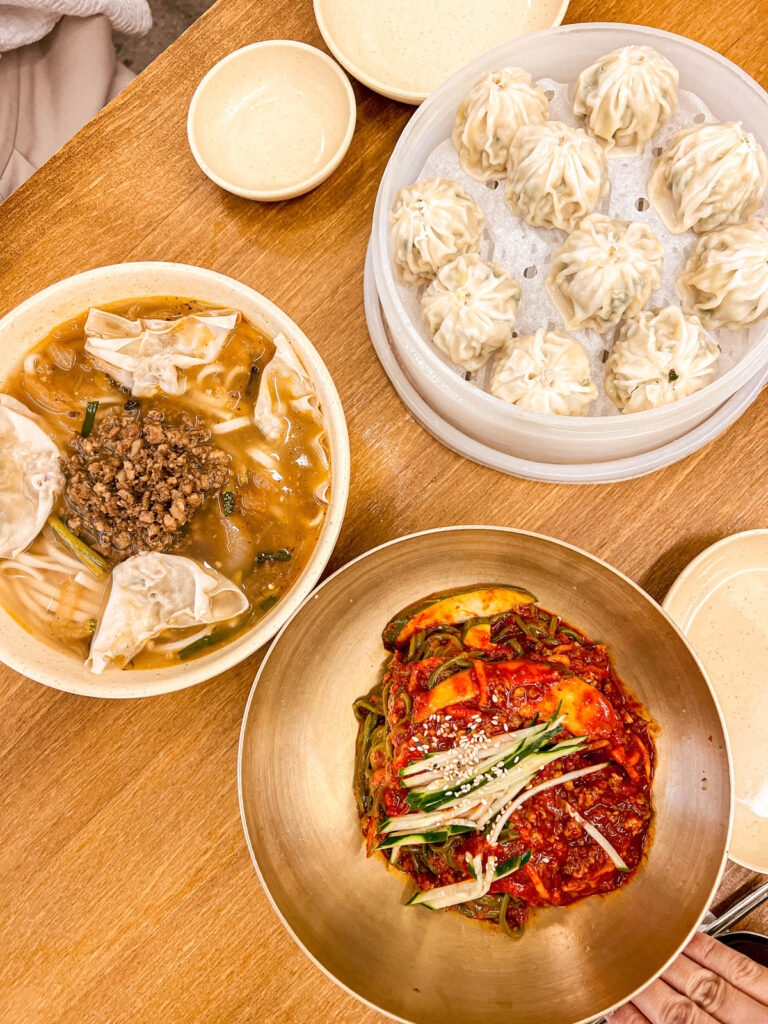
Myeongdong Kyoja: This popular restaurant has been Michelin-rated for many years, and is so popular that there are now two locations (within a few blocks of each other) in the heart of Myeongdong. It’s beloved by both tourists and locals – our friend said it was one of their wife’s and mom’s favorite spots!
It’s the perfect spot to sit down for a meal in between shopping in Myeongdong, or for a sit-down meal before the night market. There’s usually a line, but it moves fast – we were in and out in 30 minutes.
They only offer 4 items on the menu, and are especially known for their kalguksu, a noodle soup with knife-cut noodles and minced meat. My favorite item, however, was the bibim-guksu (cold noodles in spicy sauce), which had so much flavor and was refreshing on a warm day!
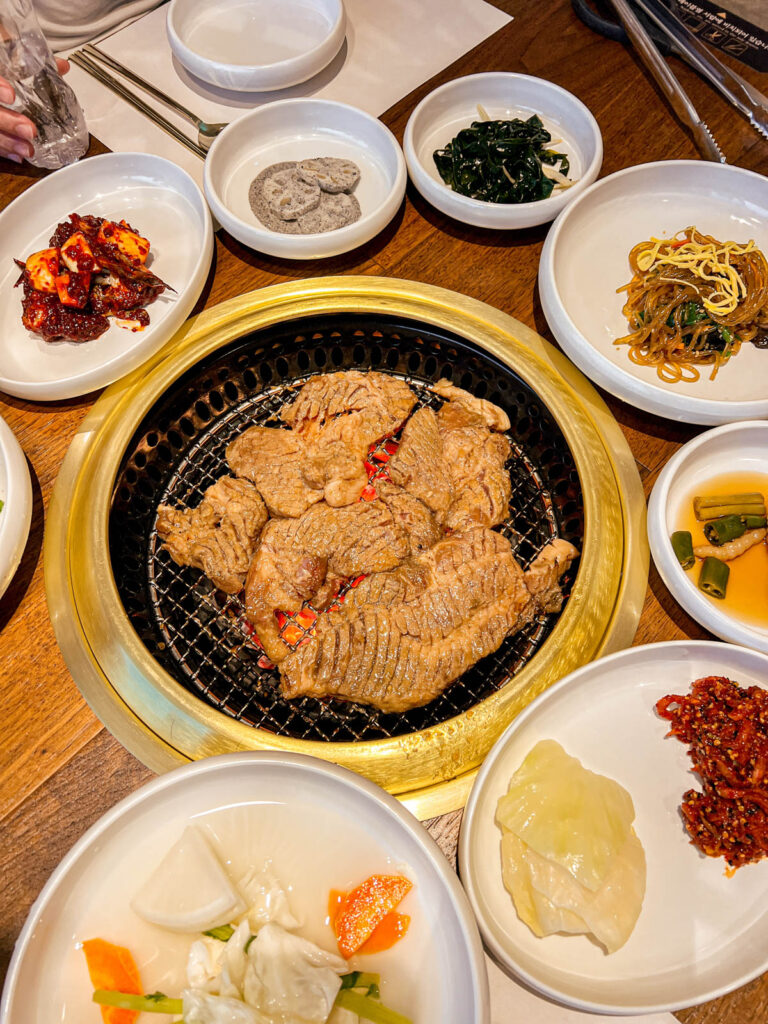
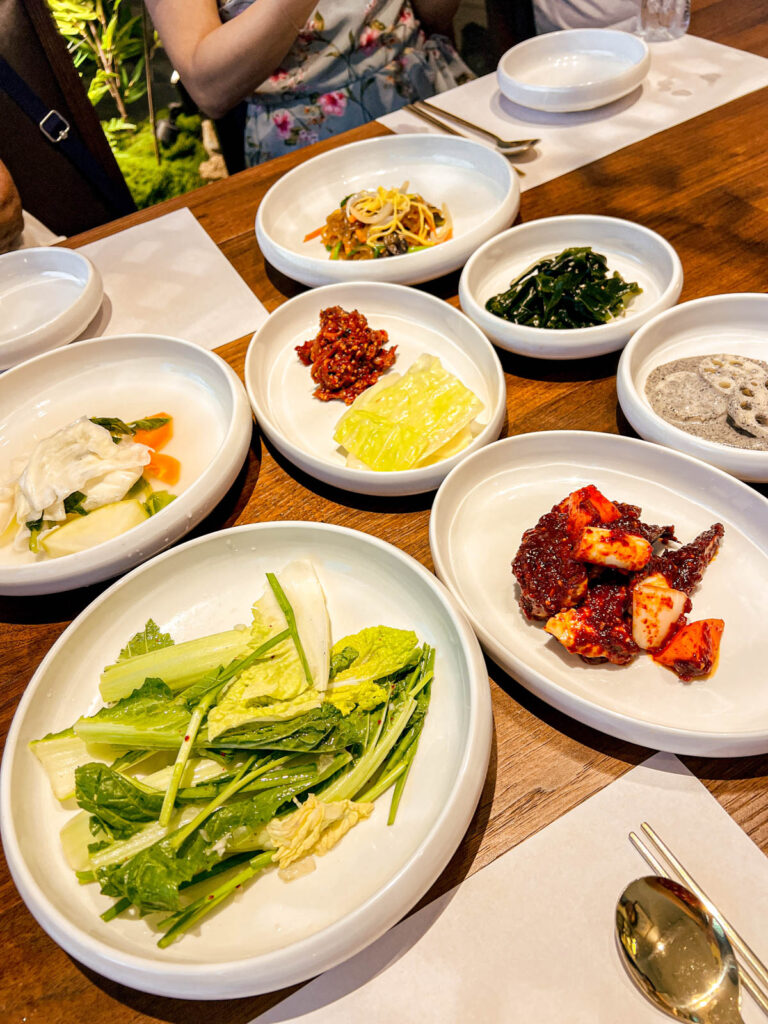
Songdo Galbi (송도갈비): This is a local Korean BBQ chain, with several locations around the city. We had dinner at the Jahamun location, which is about a 10-15 minute drive from the Gyeongbokgung Palace area (you can take a taxi there).
Our friend had us try the pork BBQ here, and it was probably the best Korean BBQ I’ve ever had – it was soooo tender and flavorful, and very different from what you think of when you think of pork. They also have Kalbi and beef on the menu, if you want that instead.
The side dishes here were also a highlight, and very different from what you usually find in the US. We loved the spicy soft shell crab and the white kimchi!
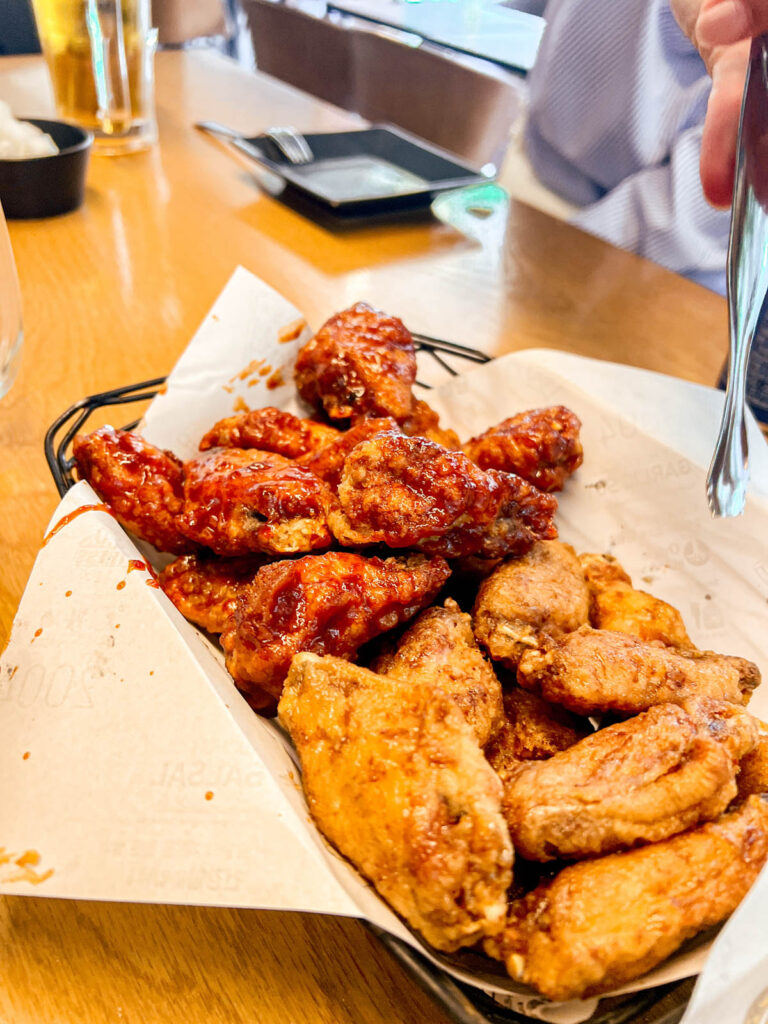
Kyochon Chicken: This is a local chain (although they actually have a location here in Los Angeles) for Korean fried chicken, and we loved it so much that we went twice! Kyochon has locations all over the city, so definitely find one near you.
They’re especially known for their soy garlic wings, and they apparently brush the sauce on the chicken over a 100 times. Because of this, your order may take a while to arrive (around 30 minutes). They are definitely worth the wait, because they are super addictive!
We also tried the red hot wings, which are sweet and spicy and have a ton of flavor. However, I found them to be super spicy (so much that I started sweating lol) and it hits you a bit later.
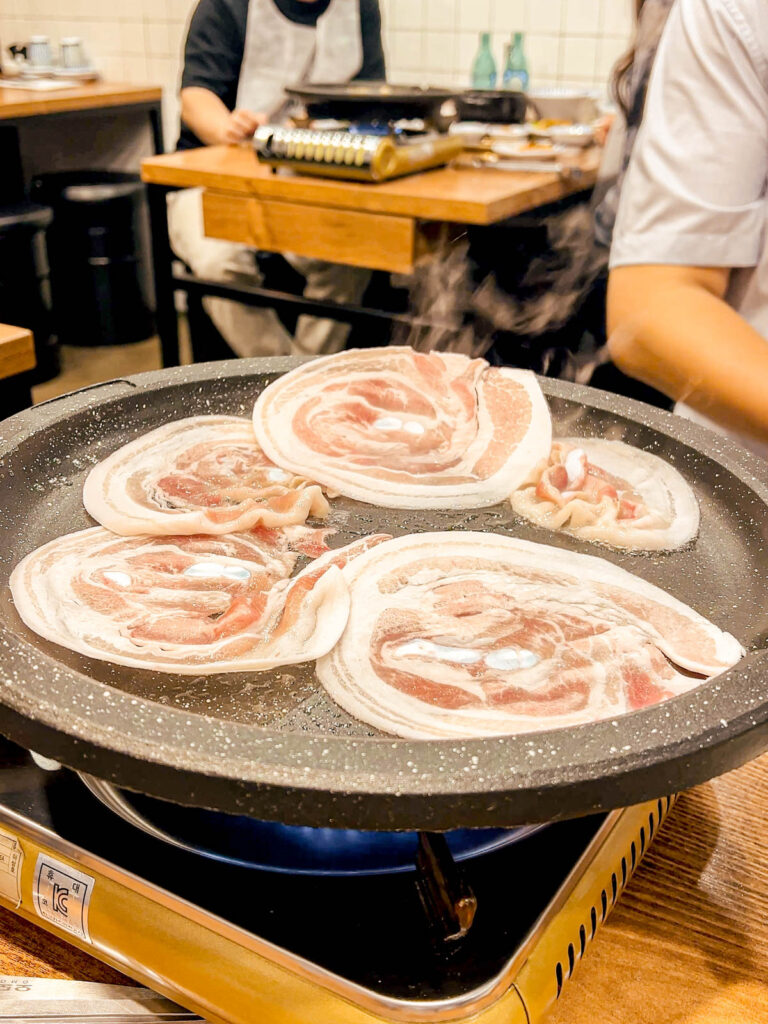
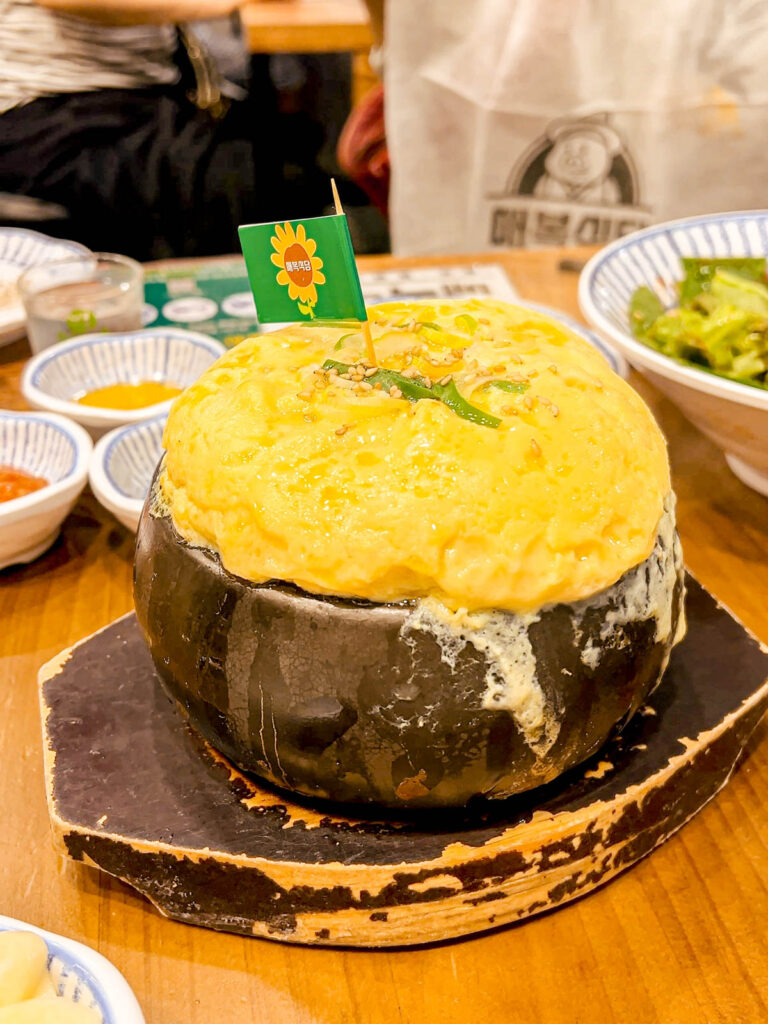
Maeboksikdang (매복식당): Our friend took us here, which is one of his favorite neighborhood spots on the outskirts of the city. They specialize in pork belly BBQ, which is sliced very thinly and almost melts in your mouth.
They cook it for you, and also cook some chives and kimchi to go with it. Honestly, the smells here while they were cooking were kinda intoxicating, and everything ended up being super delicious – so much flavor! I recommend getting some steamed egg to go with it as well.
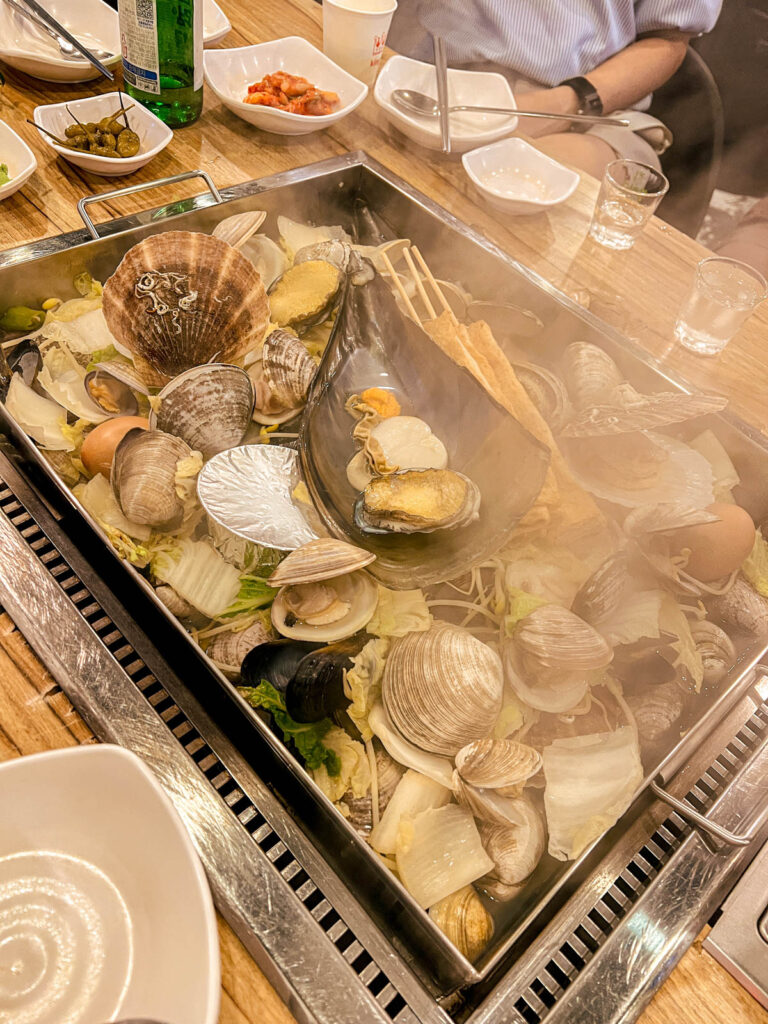
Jjimagi (찌마기): Another one of our friend’s favorite spots, and a must for seafood lovers! They specialize in steamed shellfish, and you order a giant pot to share. We all gasped when they opened the lid – it’s filled with every kind of shellfish you can imagine, from oysters, clams, abalone, scallops, and much more.
At the end, you can get some knife-cut noodles to slurp up the remnants and the broth – so comforting and so good!
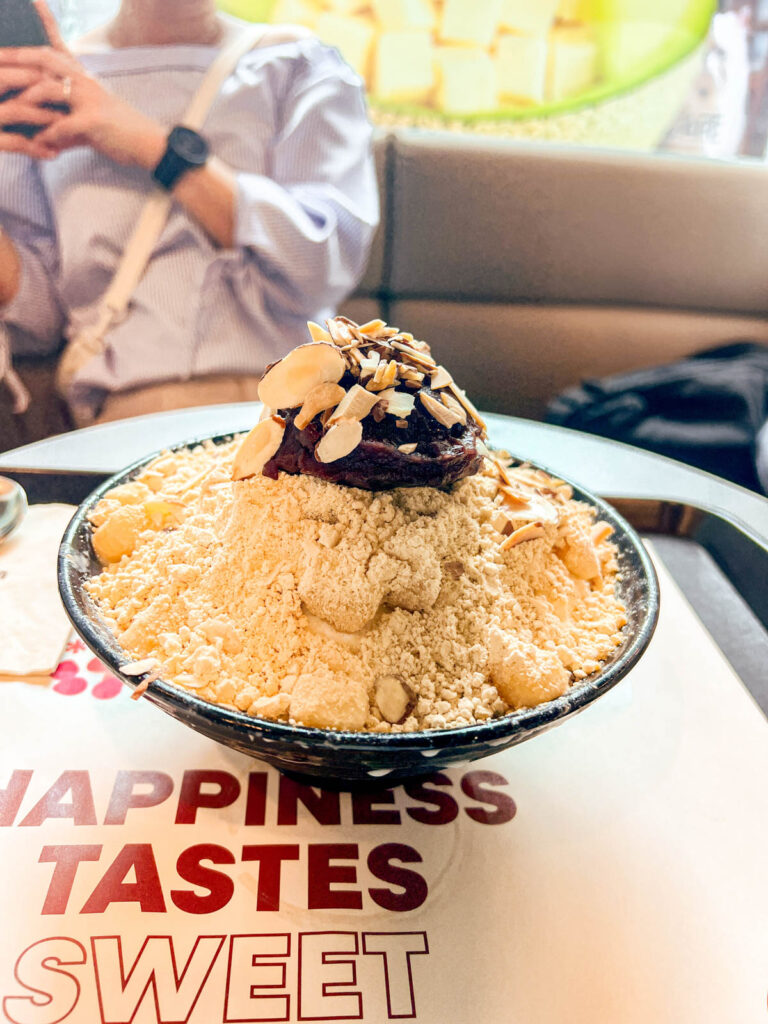
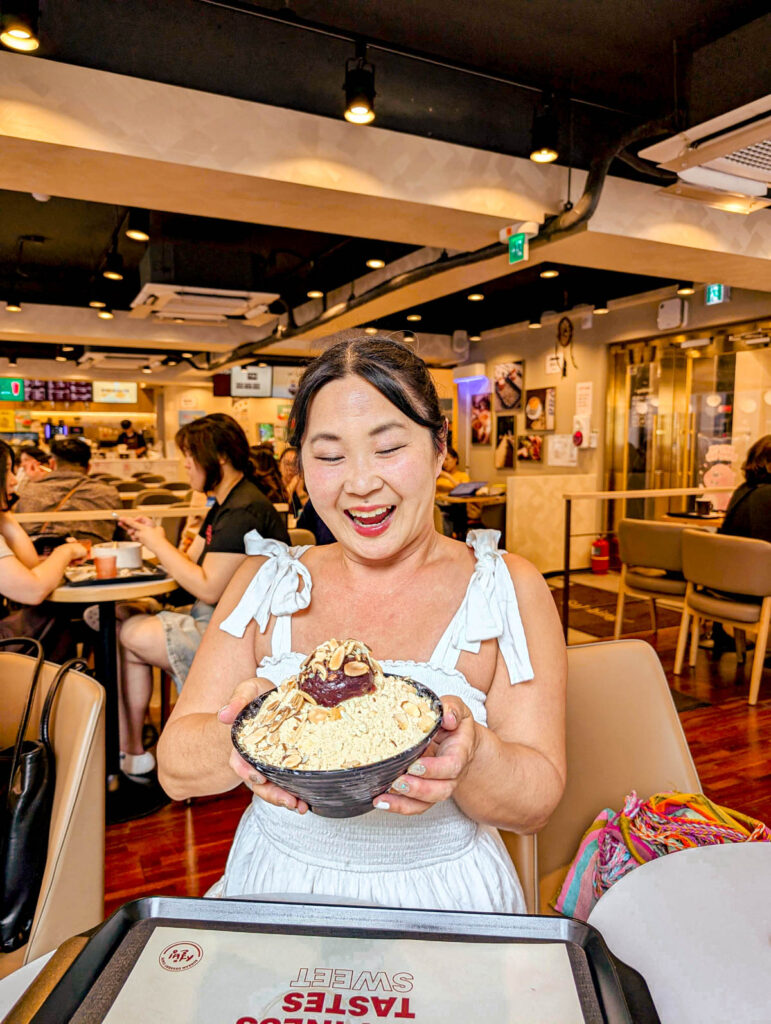
Sulbing: This is the place to go for some bingsu (Korean shaved ice). There’s several locations around the city, including right off the main street in Myeongdong.
Seriously the best bingsu I’ve ever had! I love bingsu because they shave the ice so finely and it just melts in your mouth. The portions here are huge – you can easily share one between 2-3 people (although it will be hard to choose *just one* hahah).
More logistics for your 2 day Seoul itinerary
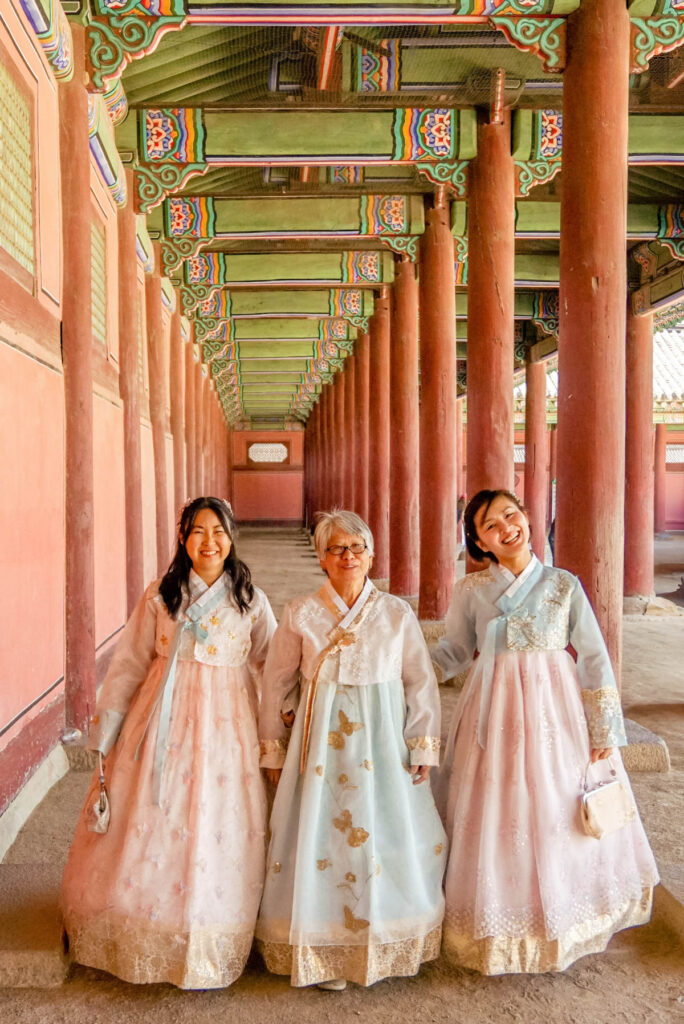
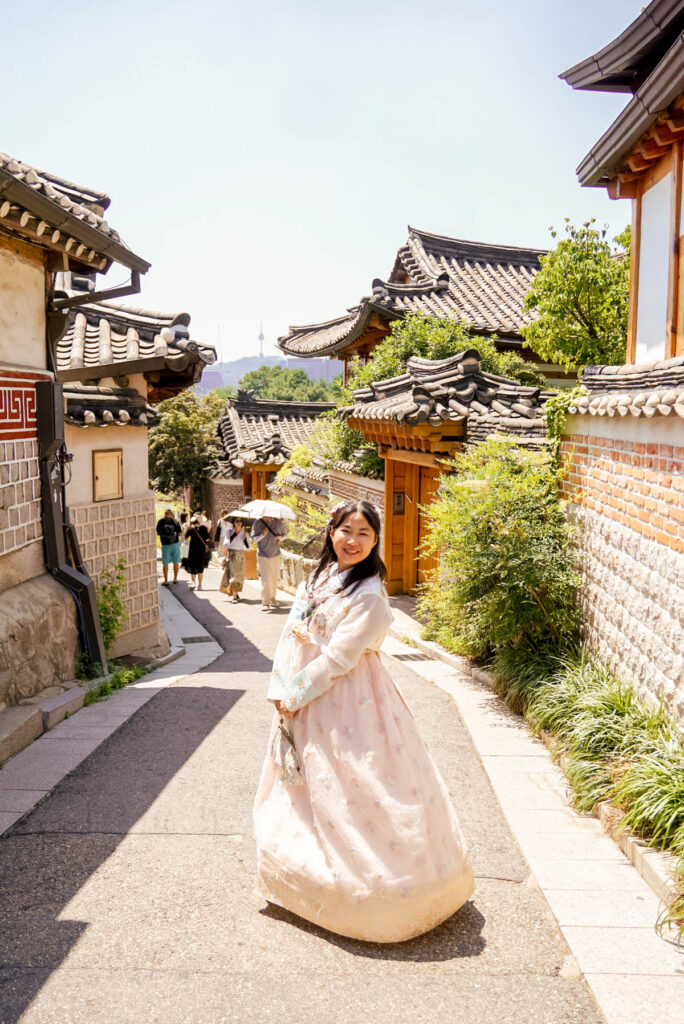
When to visit Seoul
South Korea experiences 4 distinct seasons, each offering a different experience. While Seoul is definitely worth visiting year-round, some times are better than others.
In general, spring (March-May) and fall (September-November) are the best times to visit, offering pleasant temperatures and minimal rain. You’ll also see the prettiest scenery, as spring brings cherry blossoms and autumn brings fall colors.
However, do prepare for increased crowds and higher prices, as these are the most popular times to visit.
Summers tend to be hot and humid, with the arrival of monsoon season as well. Honestly, I would avoid it if you can, but sometimes it can’t be avoided!
We visited in late June, and it was definitely starting to get warm, but it wasn’t too bad yet. In fact, our friend said that that was probably a good time to visit, as it had just started getting warm but it wasn’t super hot and rainy yet. However, right after we left, the city experienced a heat wave, and then some torrential downpours that caused severe flooding.
If you do visit in summer, slather on that sunscreen, stay hydrated, and bring an umbrella!
Winter is the low season. It can definitely get a bit chilly, but you’ll get to see the city with the least amount of crowds – and you might be able to see it under a layer of snow! If you do visit in winter, be sure to bundle up and wear layers (here’s my packing list + tips for winter trips).
Arriving in Seoul
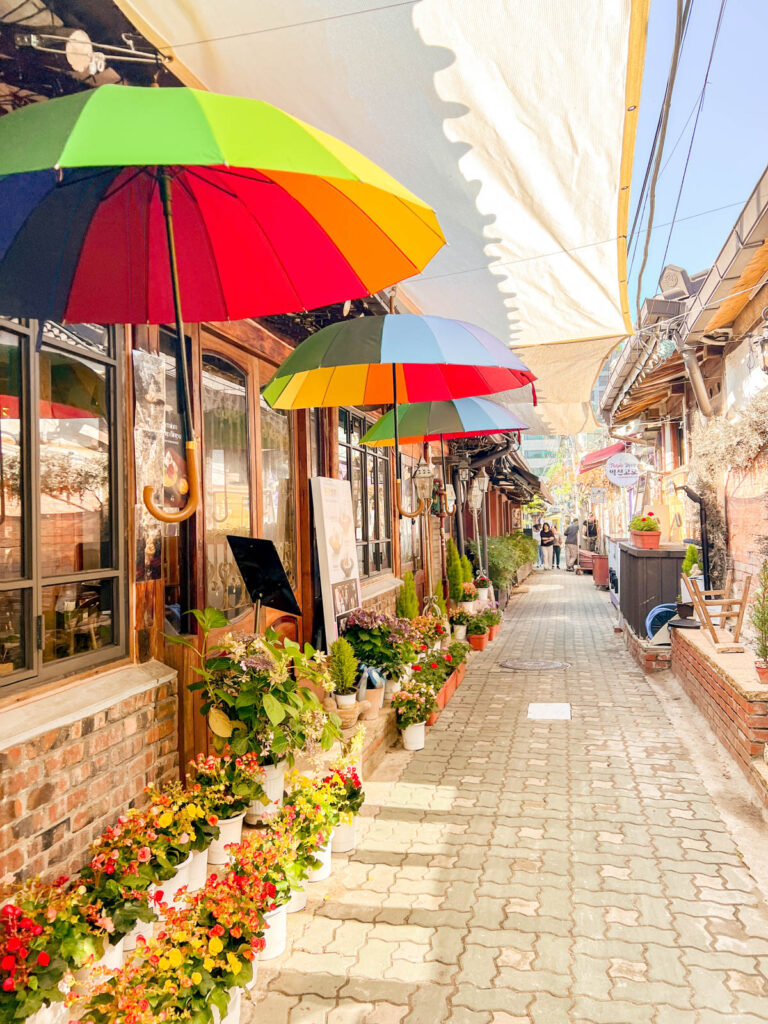
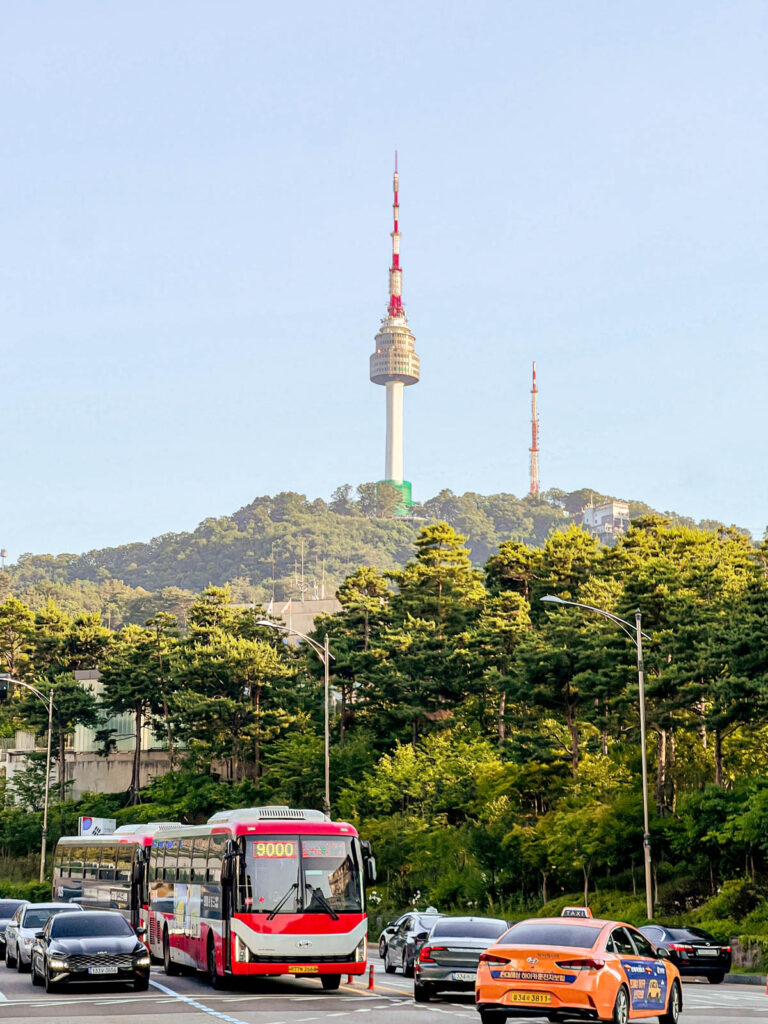
Arriving via Air
Most international visitors to Seoul will arrive via Incheon International Airport (ICN), the main international airport. Incheon sits about 60 kilometers (~36 miles) from downtown Seoul, and offers nonstop connections to cities all around the world.
Another option is to fly into Gimpo International Airport (GMP), which is closer to the city, but is mainly used for domestic and Asian flights.
From Incheon, you have several options for getting into Seoul:
AREX (Airport Express) Train
This is the most affordable way to get to the city. Depending on where you accommodations are, you’ll want to take one of two options: the AREX Express Train (11,000 KRW), which takes you directly to Seoul Station, the city’s main station (where you can transfer to the subway); and the Arex All-stop Train (5650 KRW), which makes some stops along the way.
The trip takes around 45 minutes-1 hour and 15 minutes, depending on where your final destination is. Trains run every 20-40 minutes. You can either pre-purchase your tickets on Klook, or buy them from a ticket machine at the airport.
Airport Limousine Bus
Depending on where your accommodations are (and on time of day), taking the Airport Limousine Bus may be a better option. These buses take you from the airport and into several neighborhoods in Seoul, including Myeongdong, Hongdae, Gangnam, and Itaewon.
Buses depart every 15-30 minutes, and run from 4am to 11pm. The fare is 5500-18000 KRW, depending on when you’re going, and you can buy tickets at the airport.
Taxi
The most direct way to get to your accommodations in Seoul. This was what we did to get to our hotel in Myeongdong, and although it was pricey, we were looking for convenience (especially as we were traveling with an older person).
The cost can range from 60,000-100,000 KRW (~$50-85 USD), although this can vary depending on traffic. We had to get an XL taxi since there were 5 of us, so we ended up paying 140,000 KRW (~$100 USD).
Depending on traffic, it might be faster to take the train. However, when we arrived on a Saturday afternoon, traffic wasn’t too bad, and we got to our hotel in around 45 minutes.
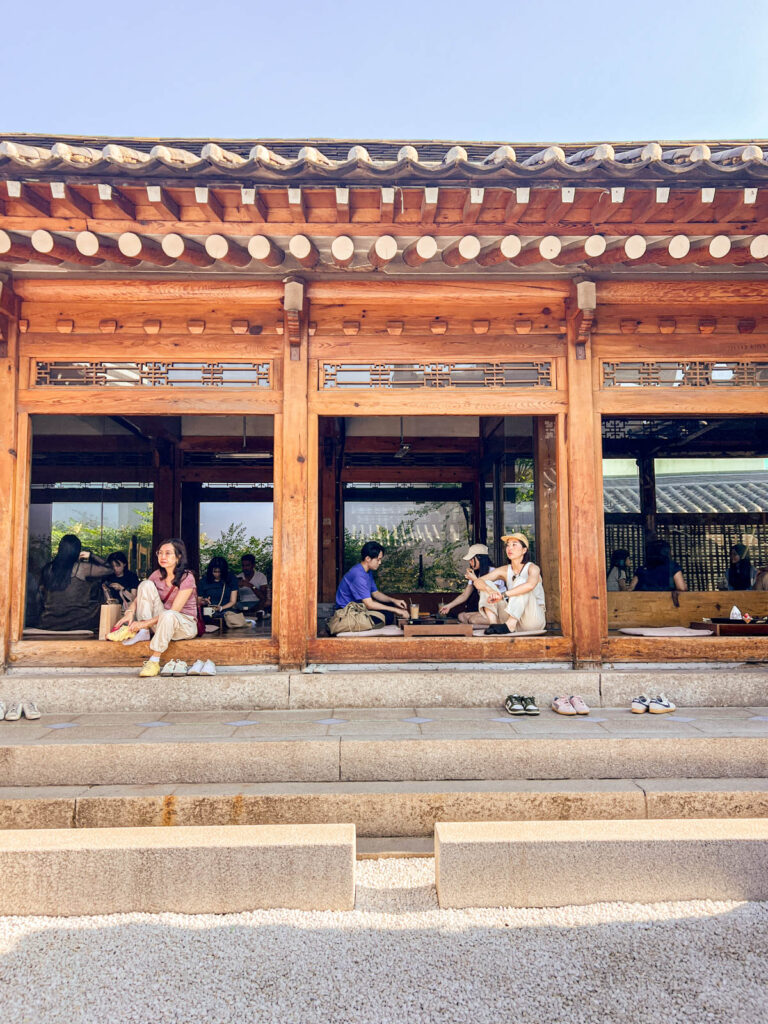
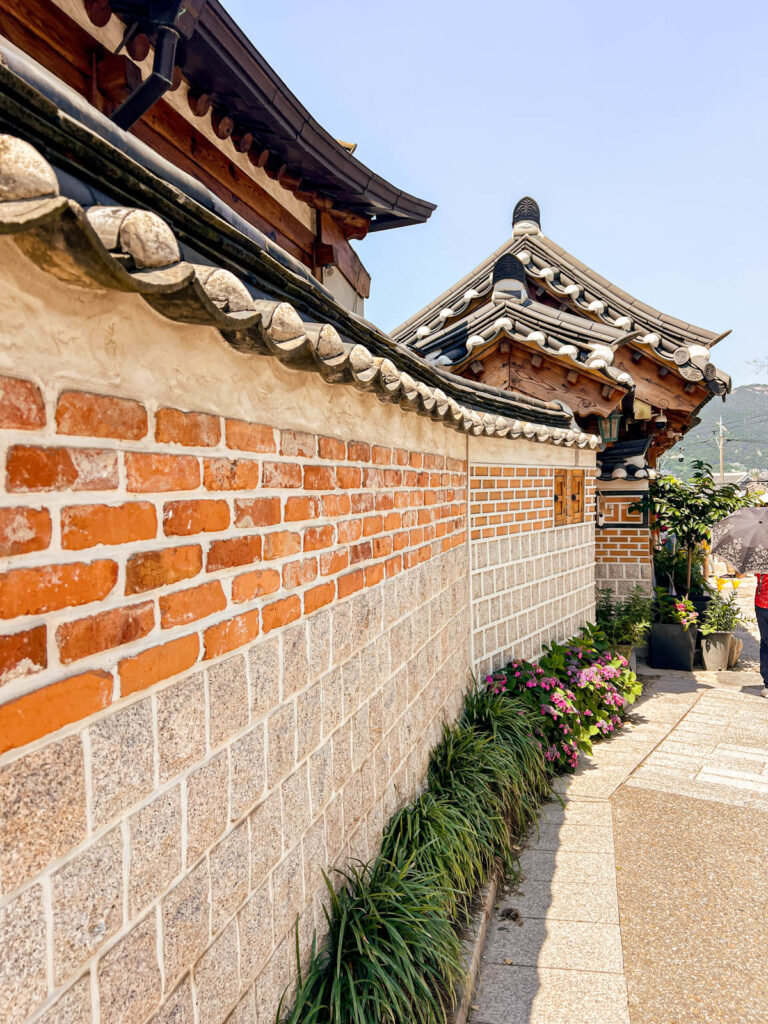
Arriving via Train
If you’re traveling from another city in Korea, then you might arrive in Seoul via high-speed KTX train. This is a highly efficient way to travel in between all the major cities in South Korea. Most trains arrive at Seoul station, and from here, you can connect via subway to your final destination.
If you’re traveling via KTX train, definitely consider booking your tickets in advance, especially if you’re traveling during peak tourist seasons (i.e. cherry blossom season). The easiest best way to do this is to purchase a Korail Pass on Klook, as the KTX website does not accept foreign credit cards.
Getting Around in Seoul
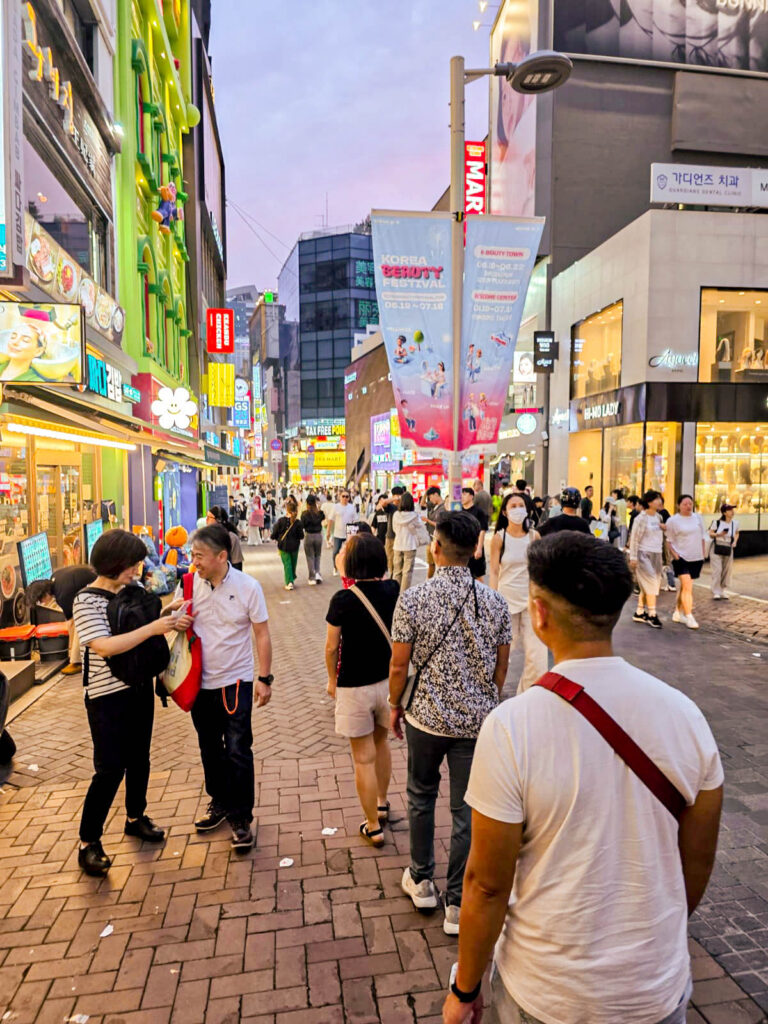
While Seoul is big and spread out, thankfully, it’s relatively easy to get around the city. You’ll find a number of different ways to get around, including on foot, via public transit, or taxis.
One thing to note is that Google Maps’s functionality is limited in Seoul, so you may want to download another app to get around the city. While Google will tell you transit directions and you can technically follow the little dot around while walking, sometimes I just wanted to know how long it will take to walk from point A to B. The preferred navigation app here is Naver Maps.
Public transportation
While Seoul is big and spread out, thankfully, it’s relatively easy to get around the city. This is thanks to its extensive and well-connected public transportation system, which will connect you to almost anywhere you need to go.
I was super impressed by how clean, efficient, and easy using the subway was here! This was even in comparison to using the subway in places like Tokyo, and definitely 100000x better than in NYC. For example, each of the exits have numbers, making navigating a breeze! And there’s signage on the floor, so you can make your way around and look at your phone at the same time.
Each ride costs 1400 KRW (~$1 USD), so it’s a super affordable way to get around the city.
To use public transportation, you’ll first need to pick up a T-Money card. The cards cost between 3000-5000 KRW, and you can do this at the airport, or at any convenience store once you arrive in the city. You’ll need cash to purchase the card, as well as to reload the card.
I’ve heard that the city is in the process of implementing tap to pay using Apple Pay, but it’s still in the process of rolling out, and will not be available for Android phones yet. So, for now, the best way to pay for transit is to use a T-Money card.
In addition to the subway system, the city also has a network of buses, although we ended up not using them.
Taxis
If you don’t feel like using public transportation, no problem, you can easily take taxis around the city. If you plan to use taxis, download Kakao Taxi, which is the city’s preferred taxi app. Uber does also work here, and will connect you to local taxis.
Have you been to Seoul? What would you do with only two days in Seoul?
Liked this post? Save this 2 day Seoul itinerary to Pinterest for later!
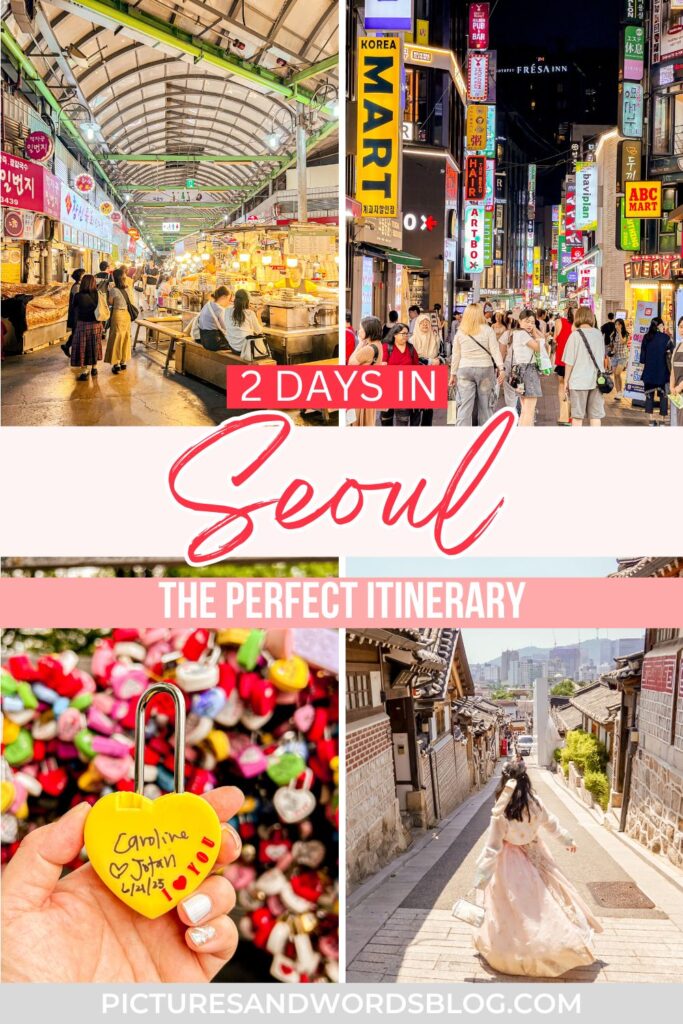
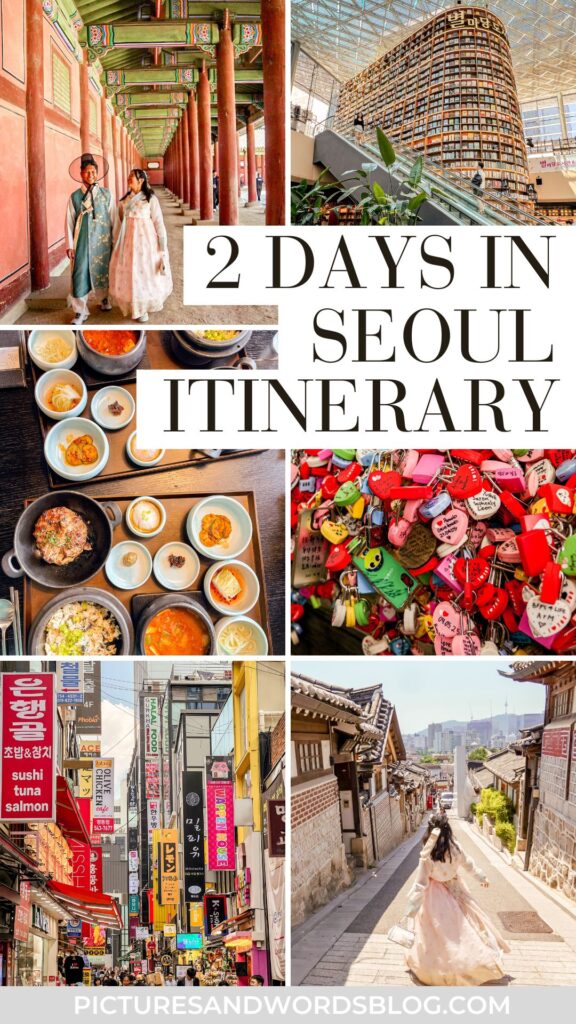
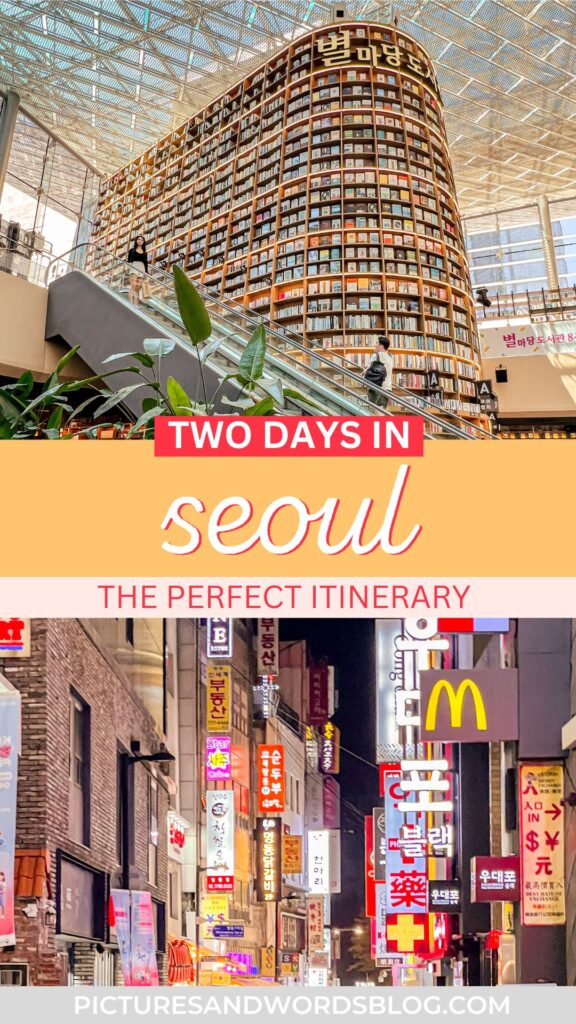
Caroline is a Southern California based traveler, writer, and photographer. She travels all around California, the US, and the world in search of the most colorful places, the most delicious food, and bucket-list adventures. Her aim is to inspire other travelers discover how to add more adventure and joy to their lives. On Pictures & Words, you’ll find detailed guides + itineraries, along with vibrant photos to help you plan the the most epic trips. When she’s not traveling, Caroline also runs half marathons.
